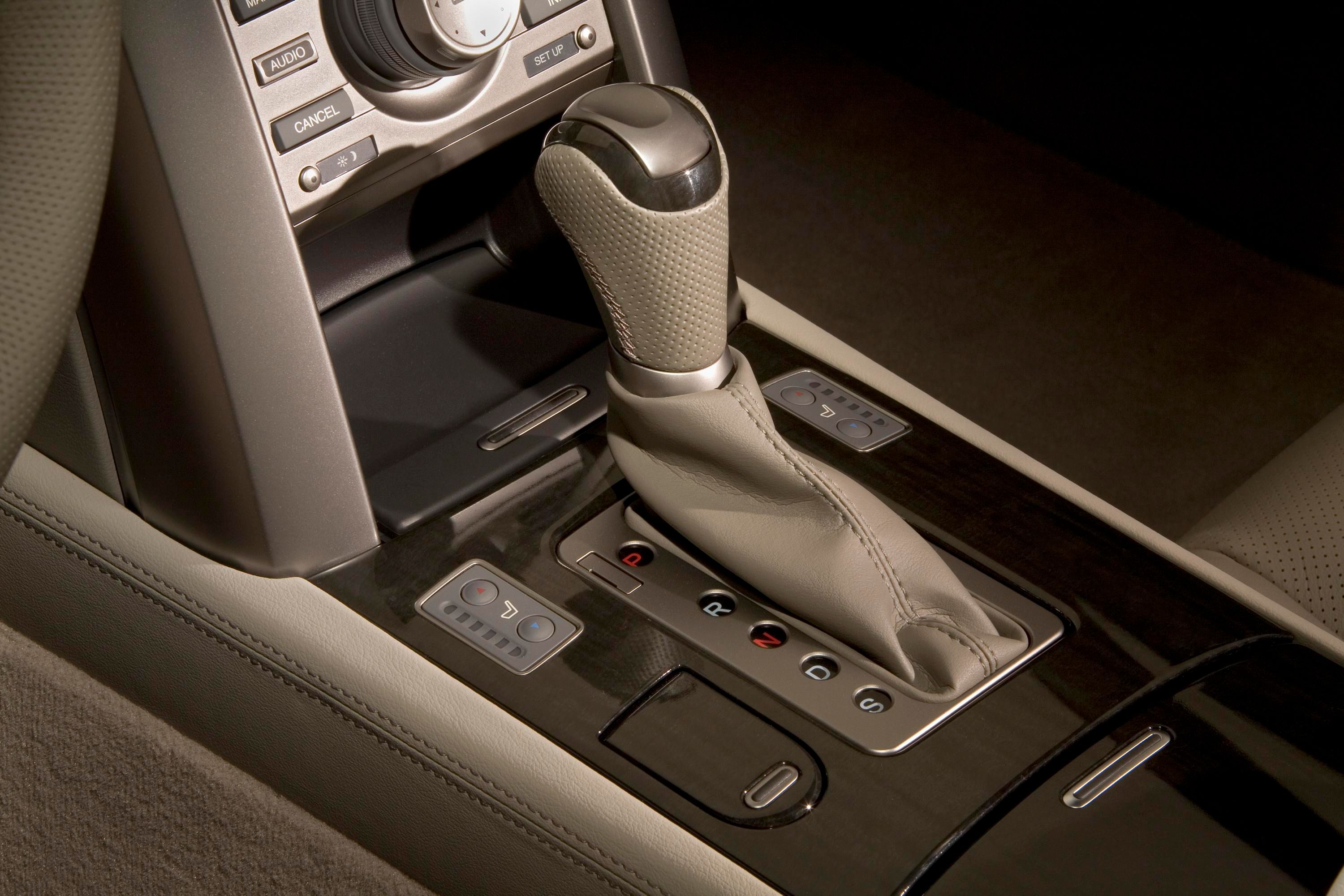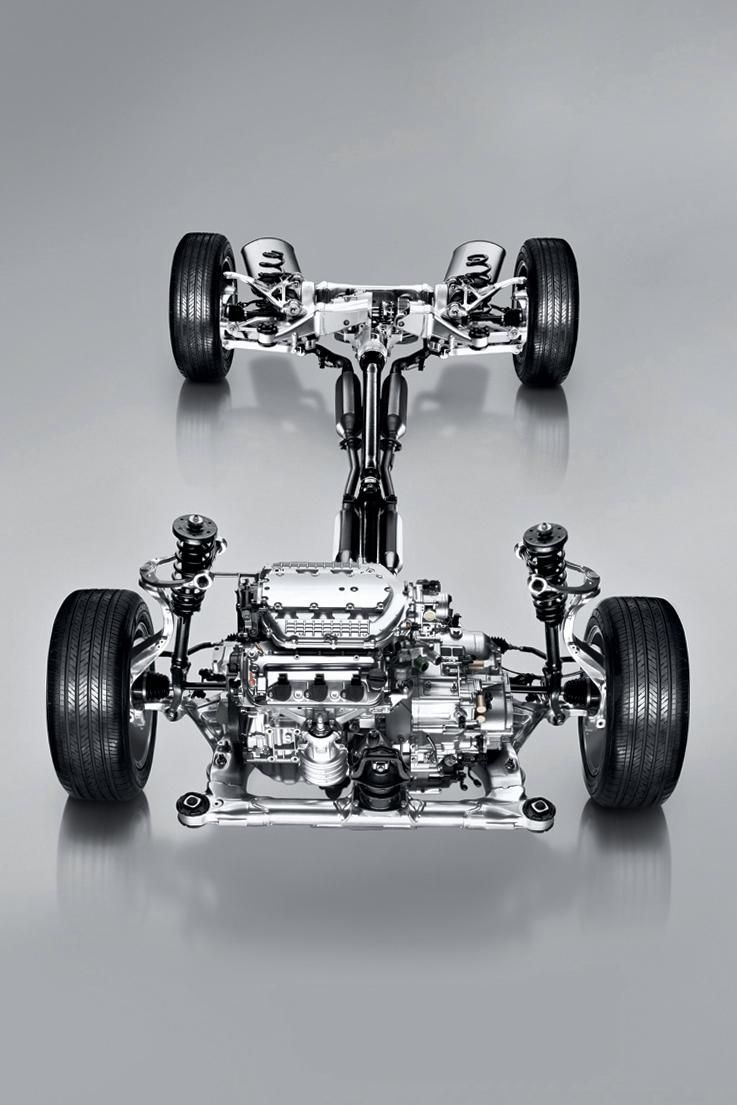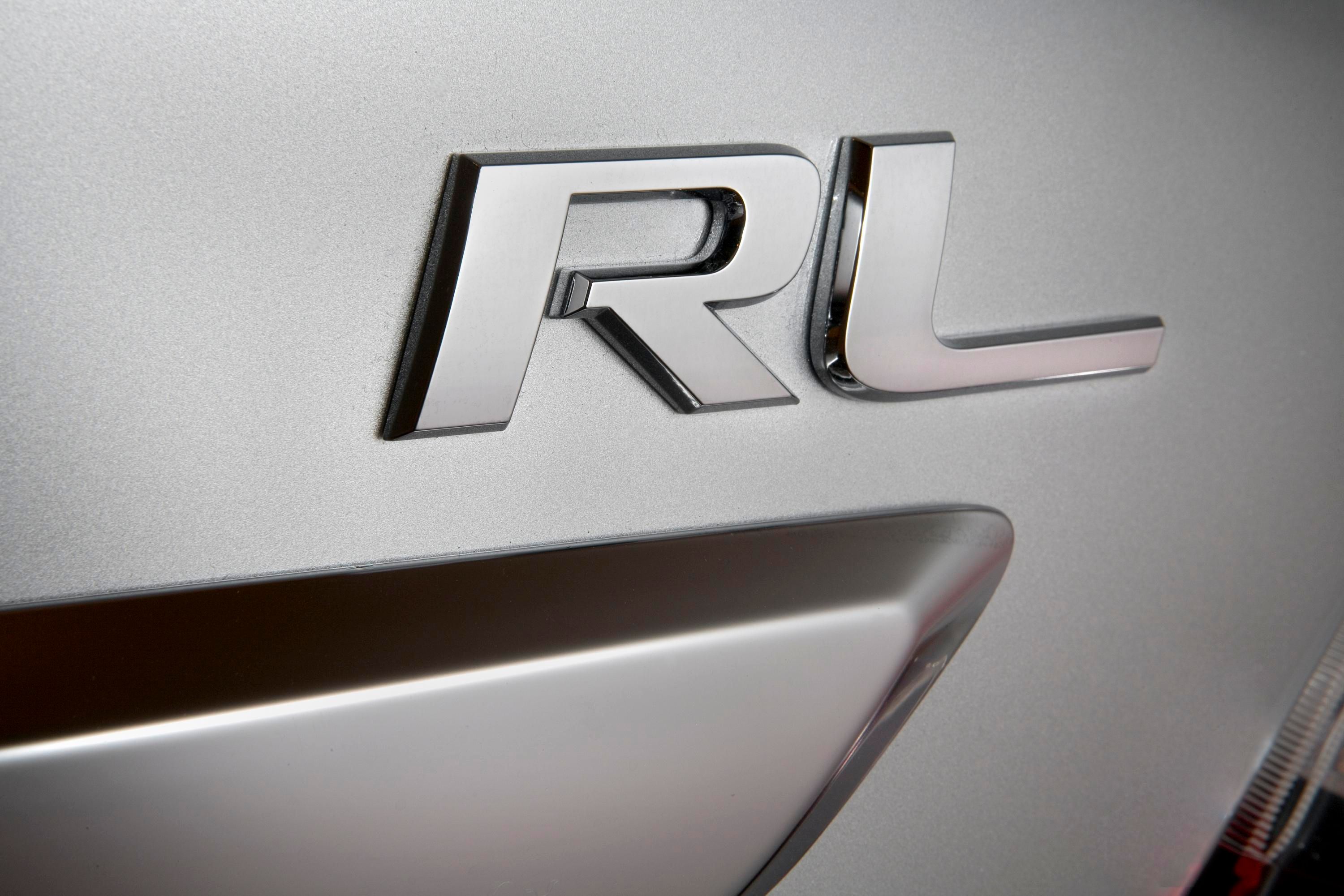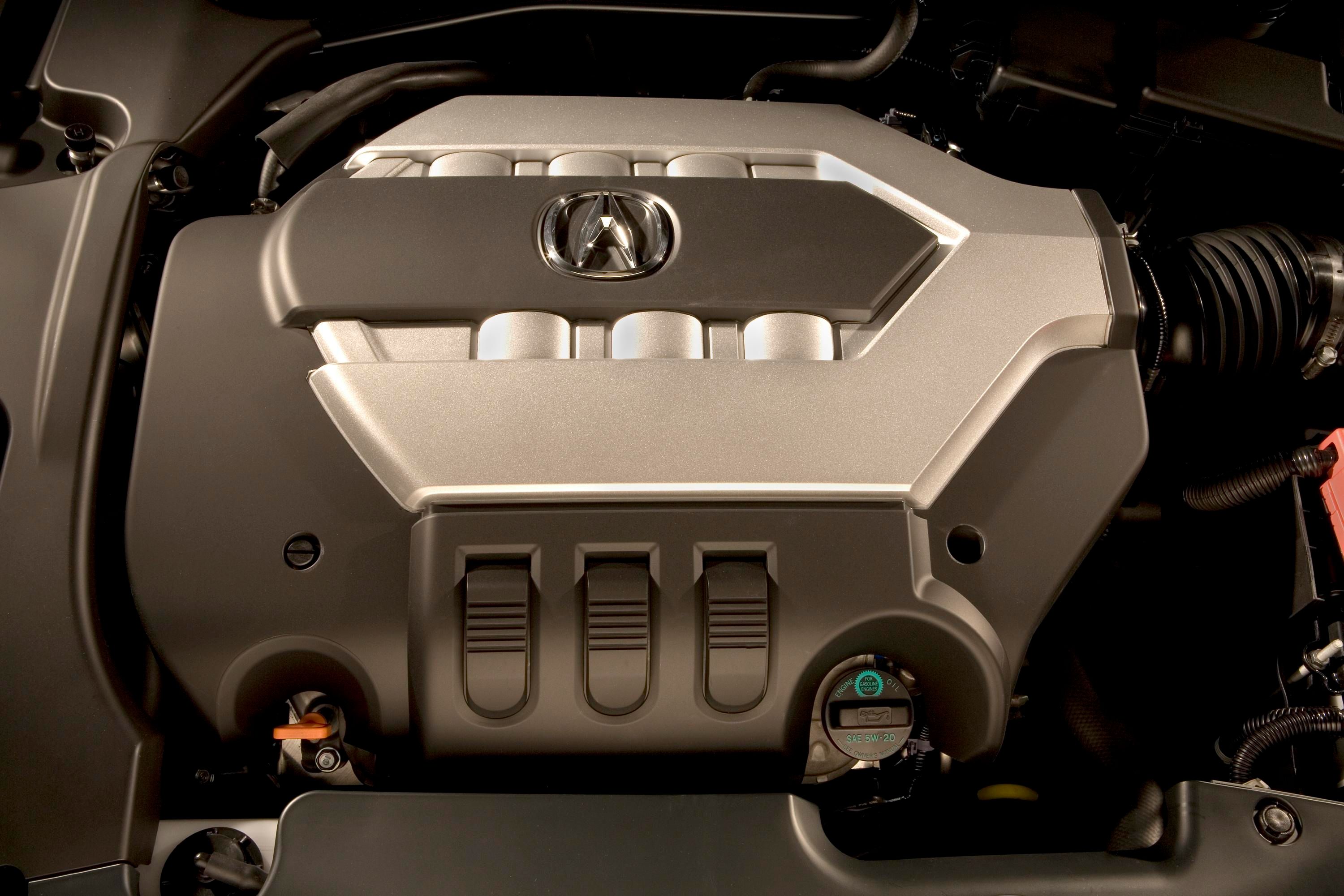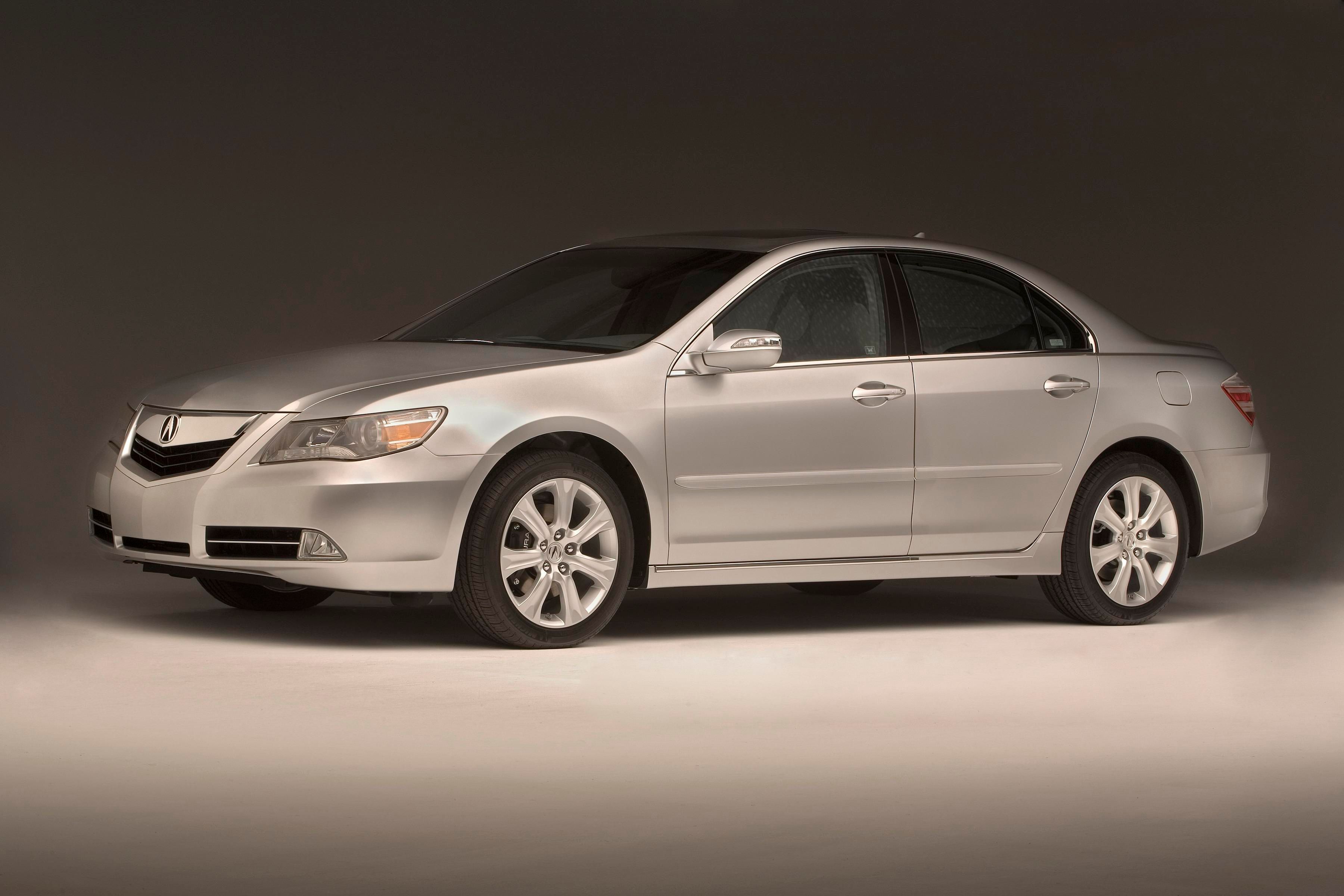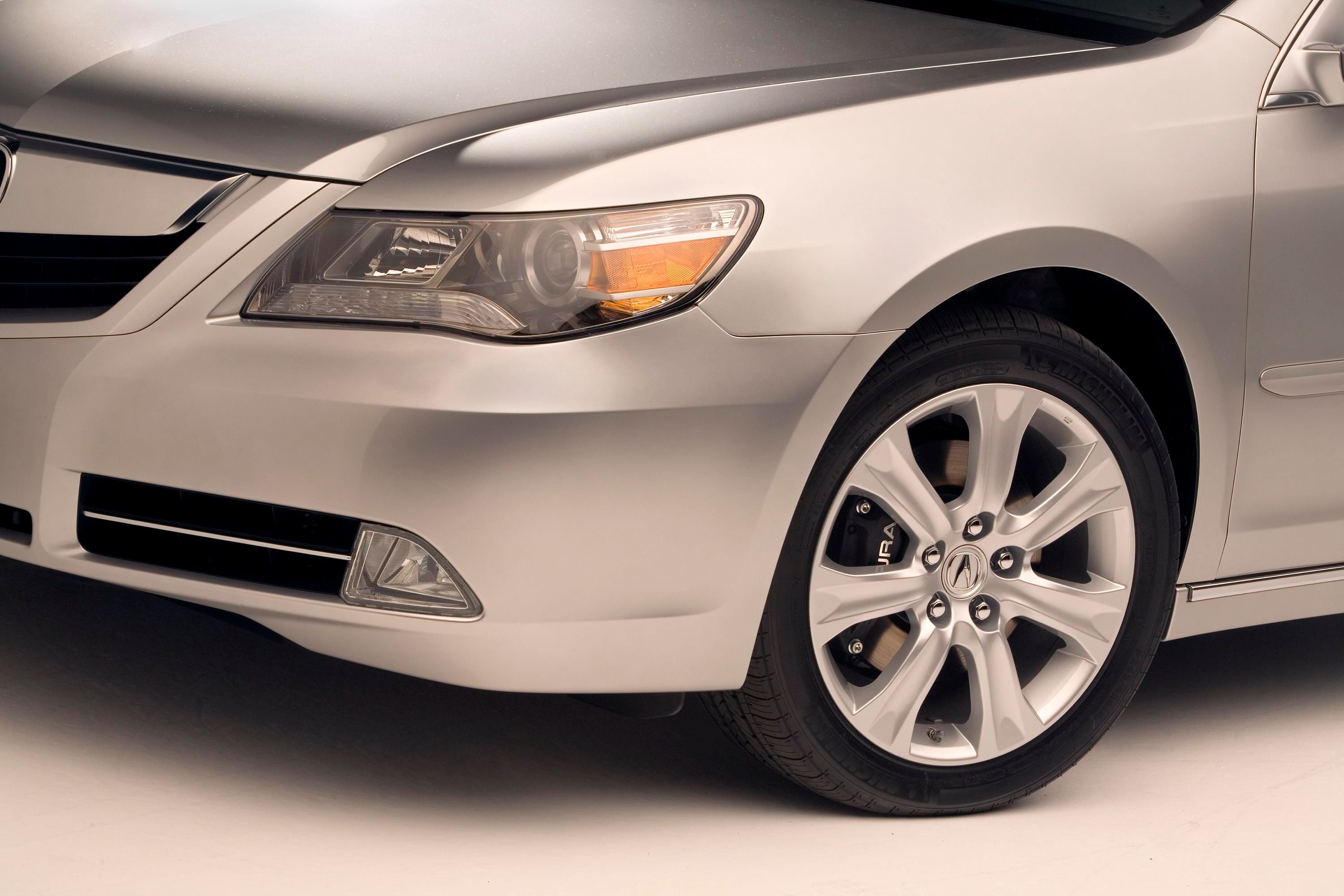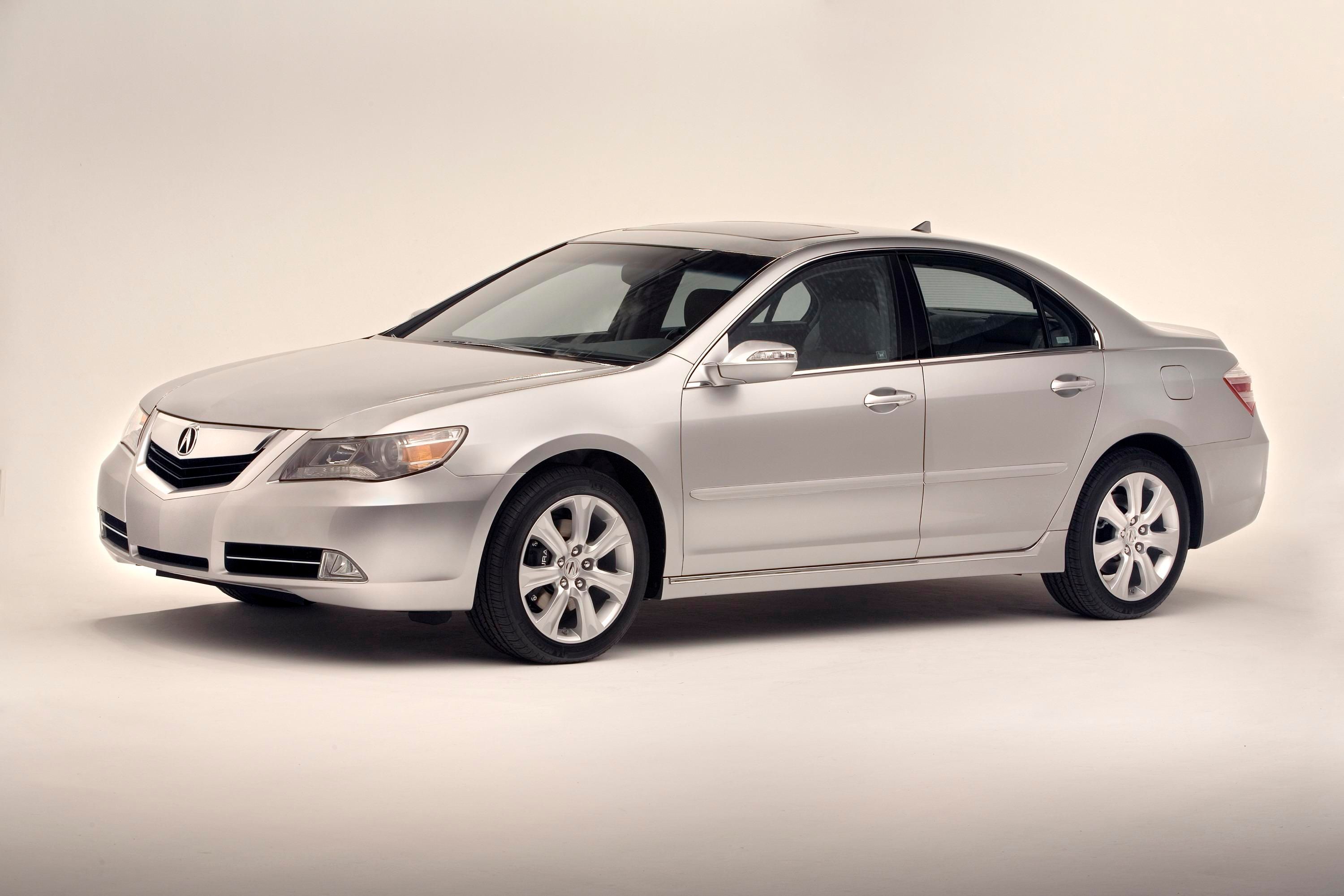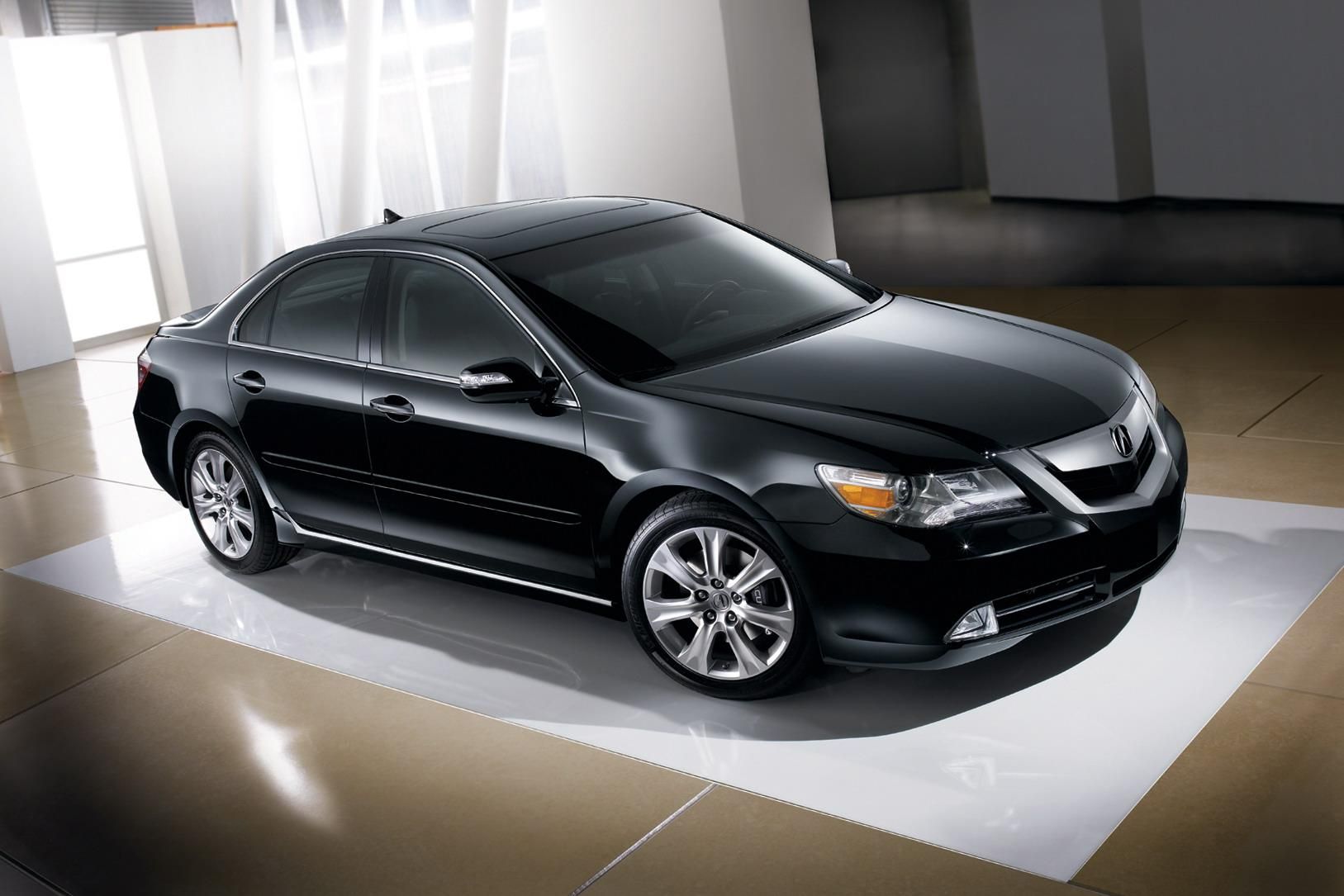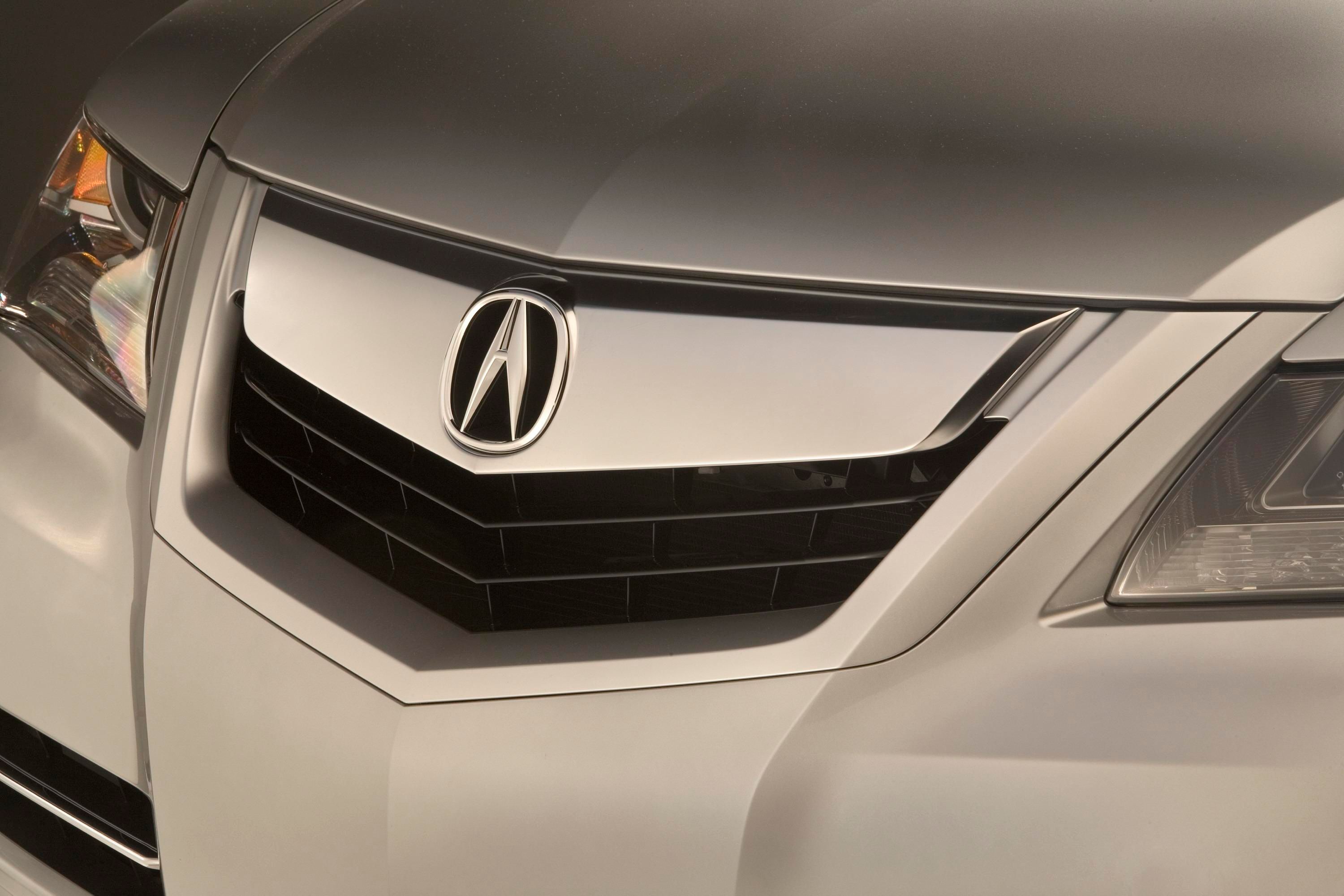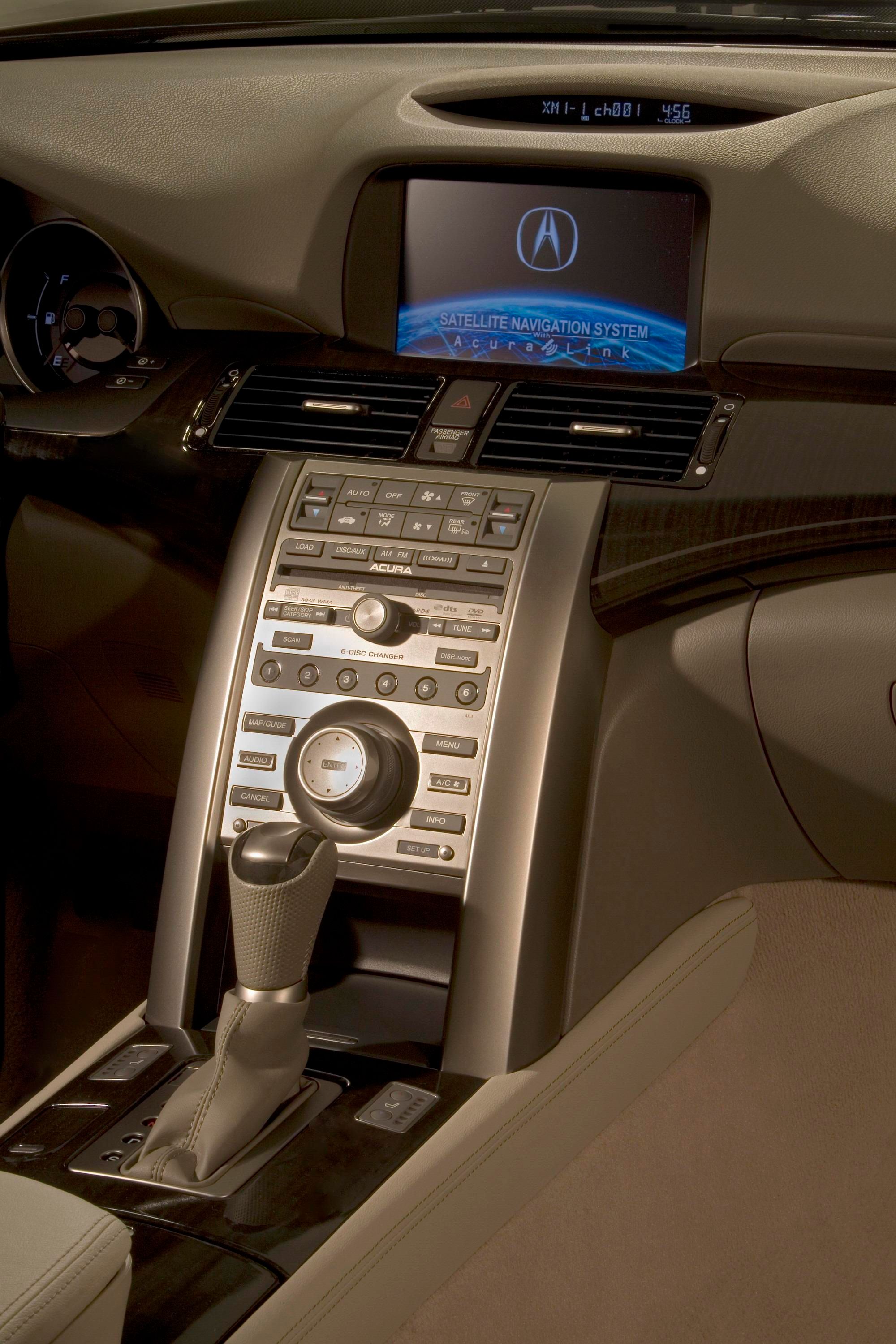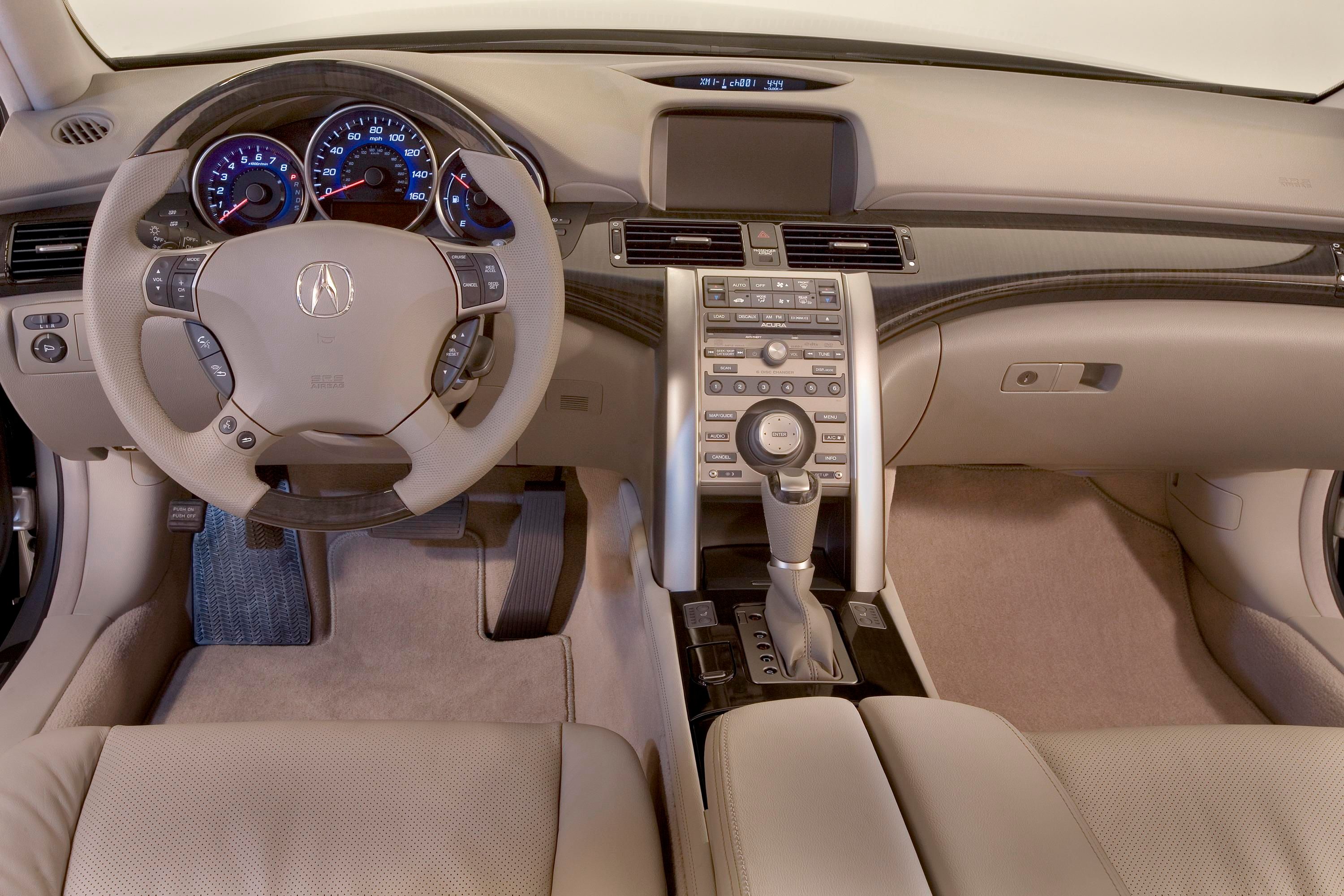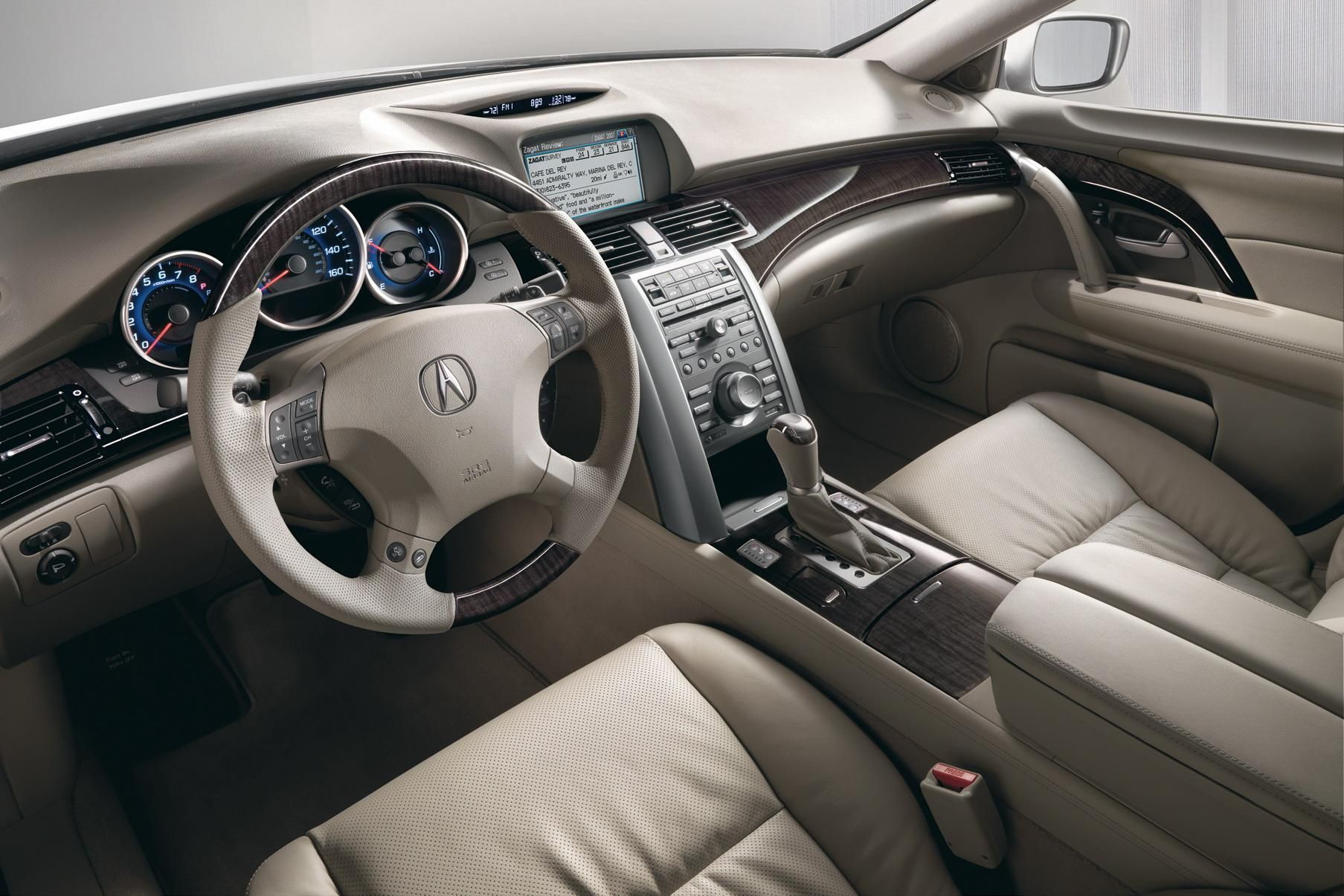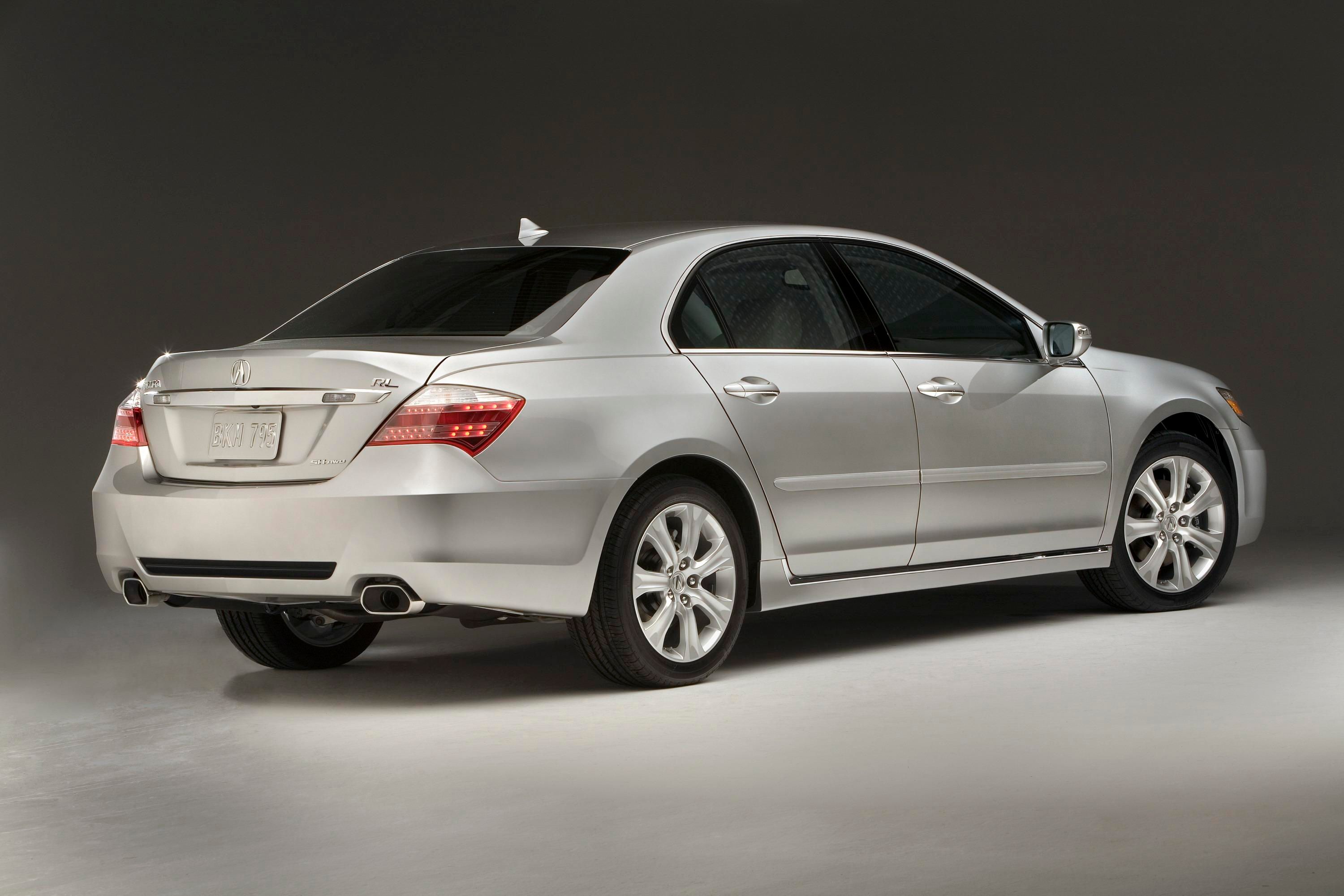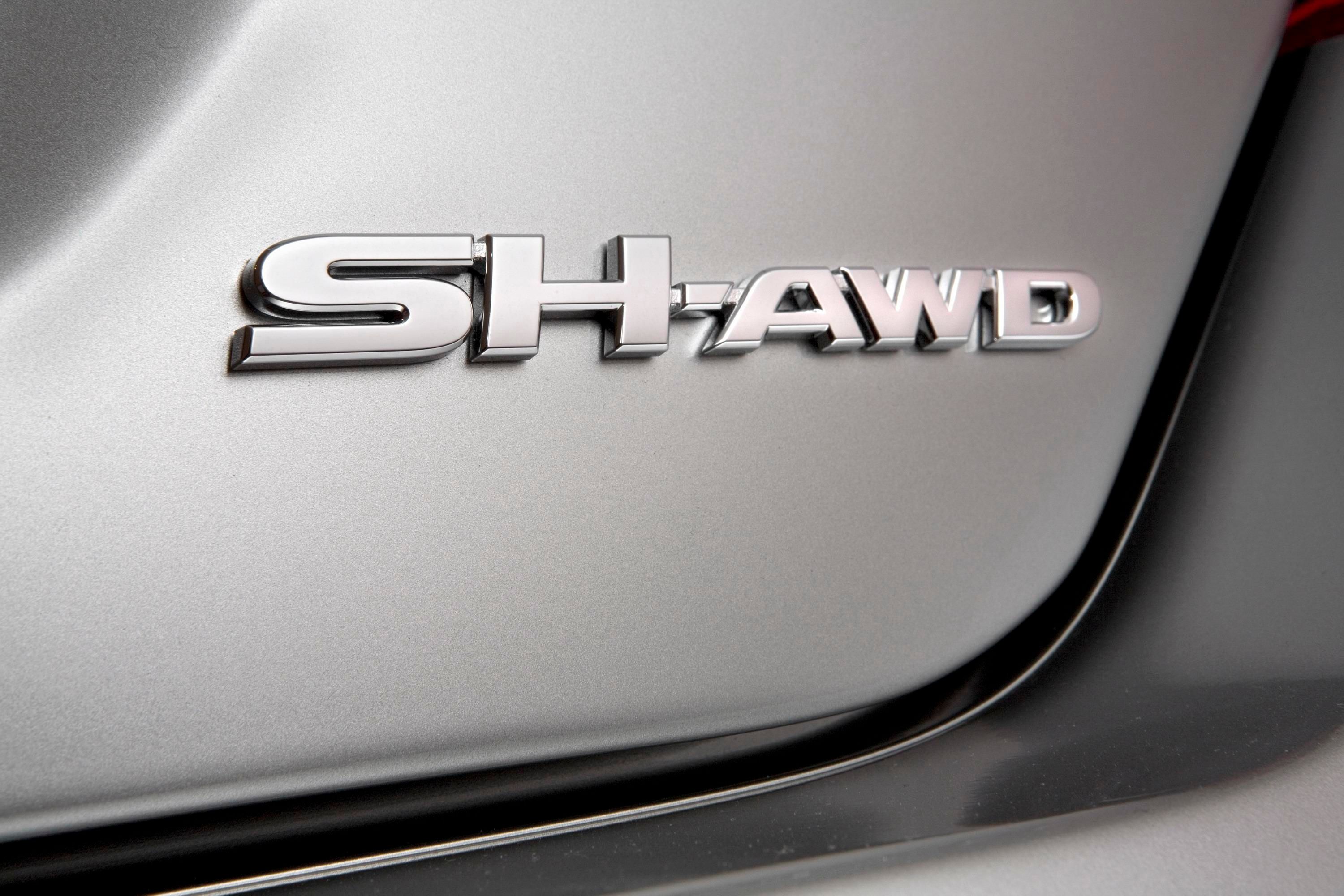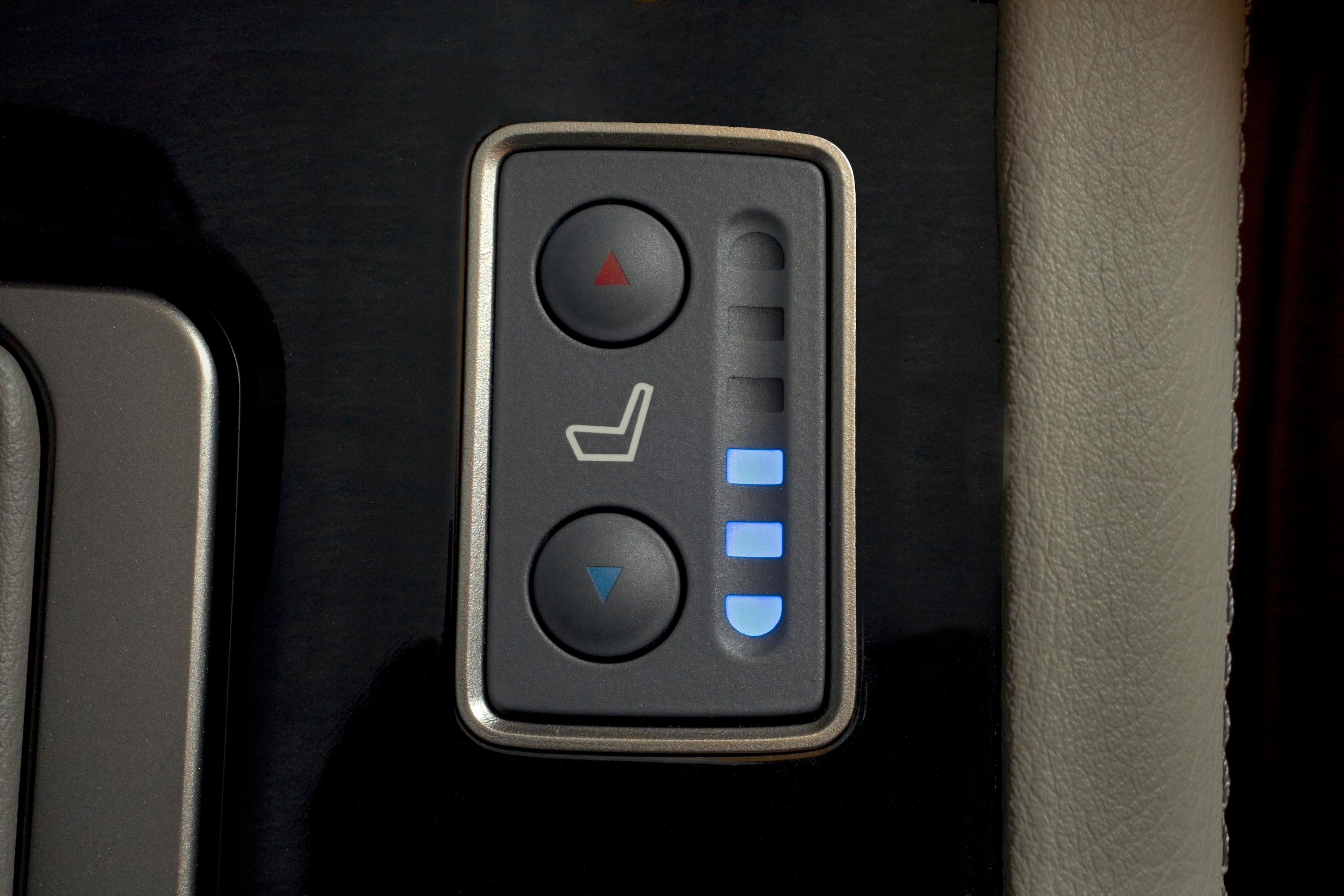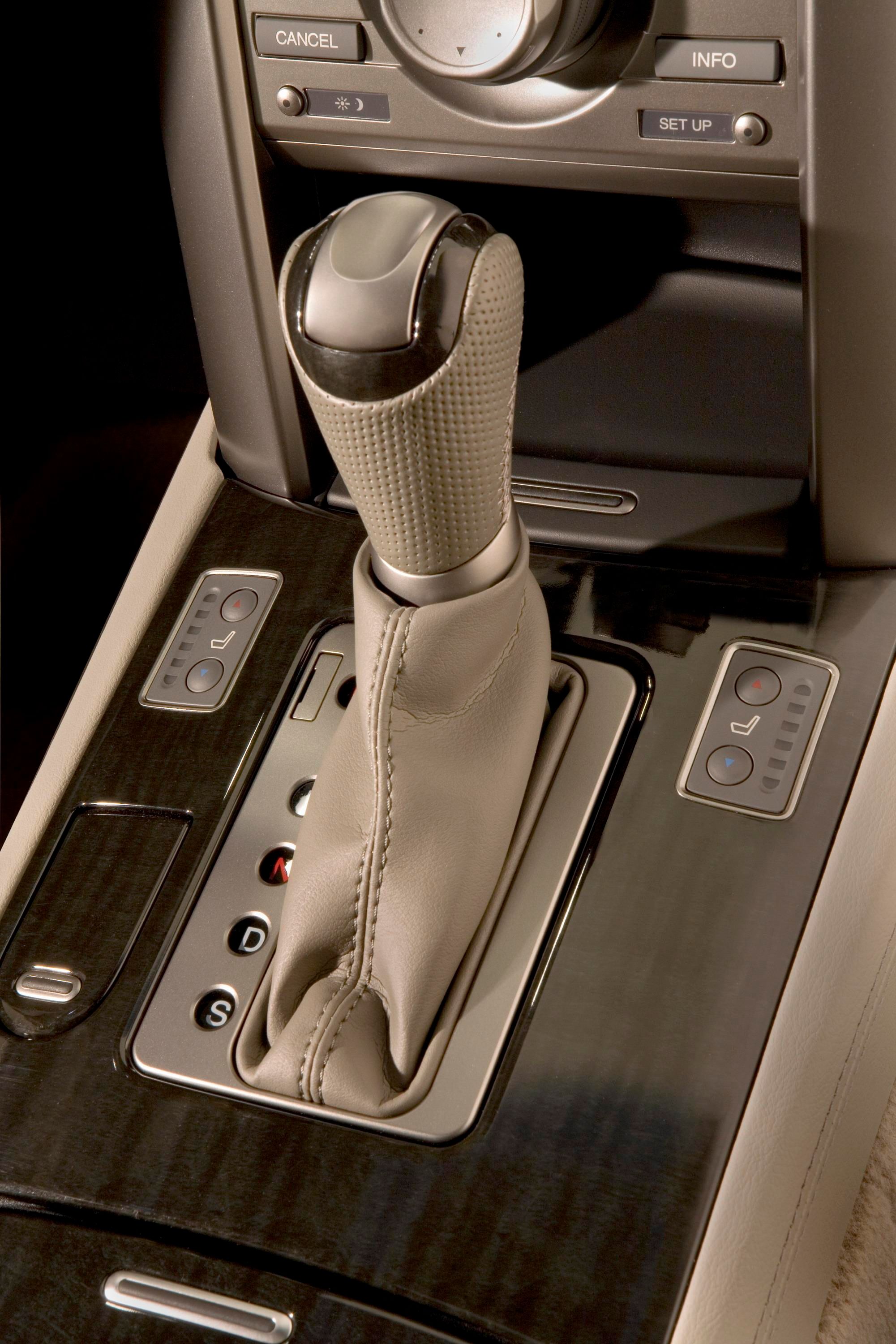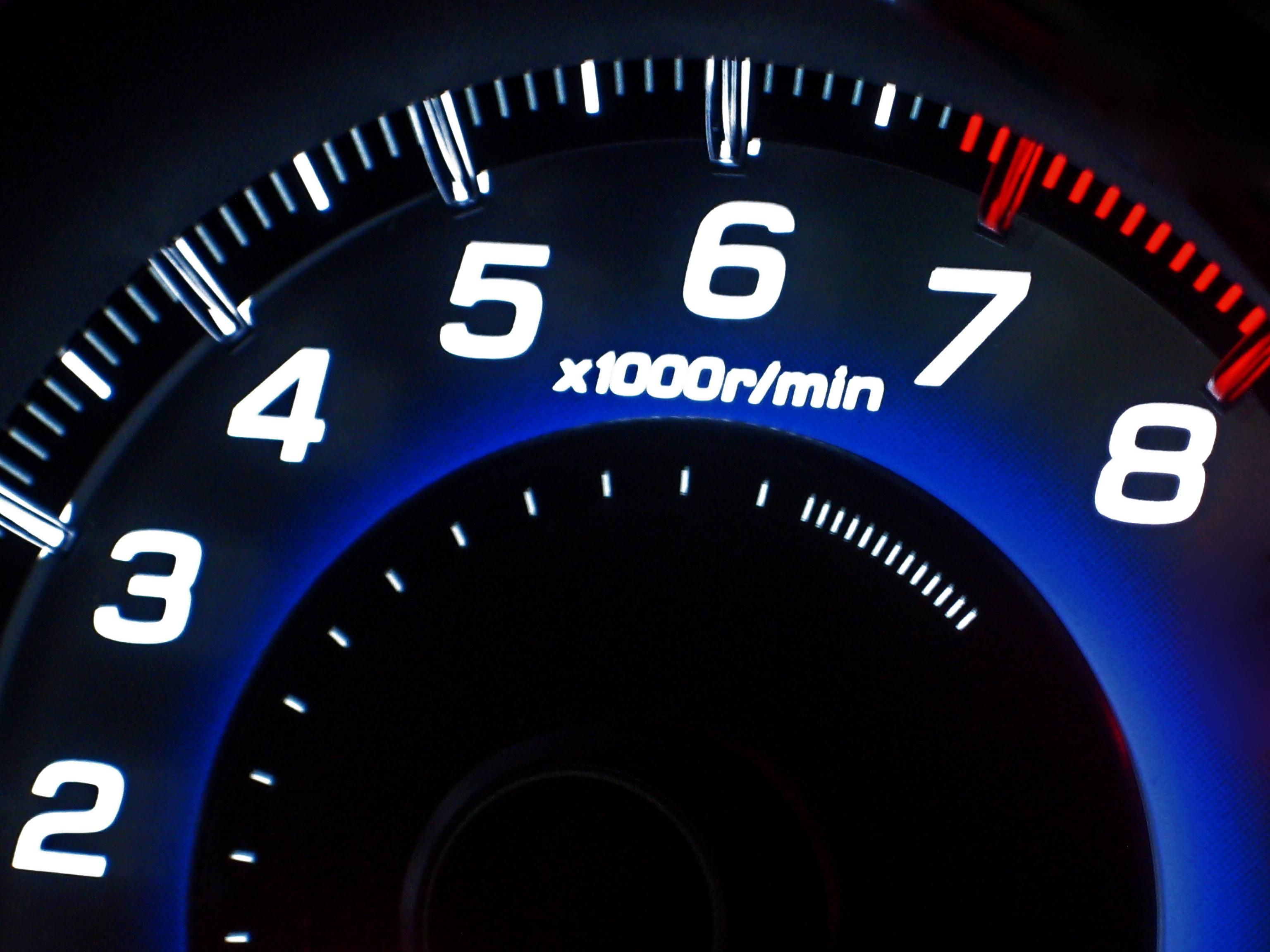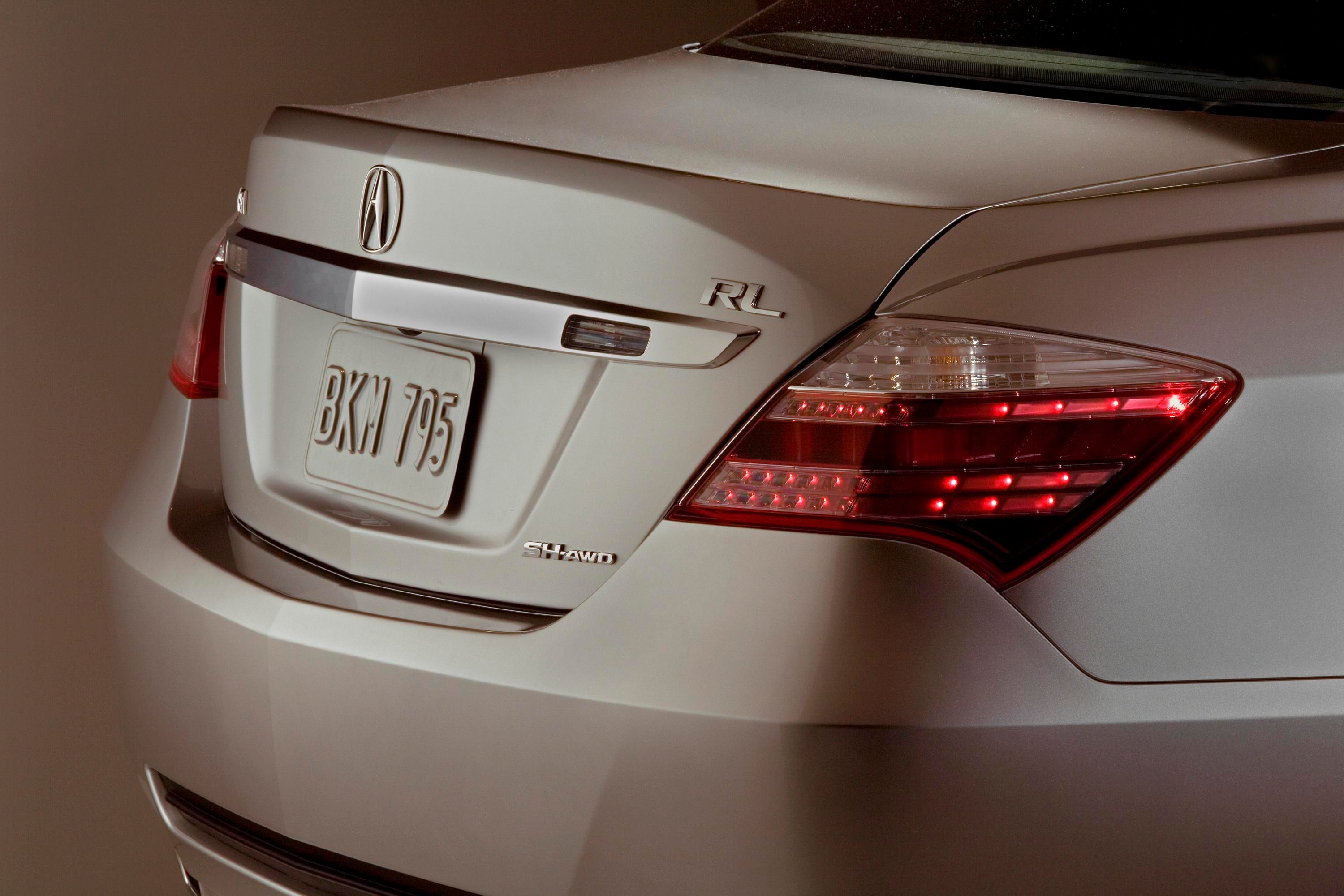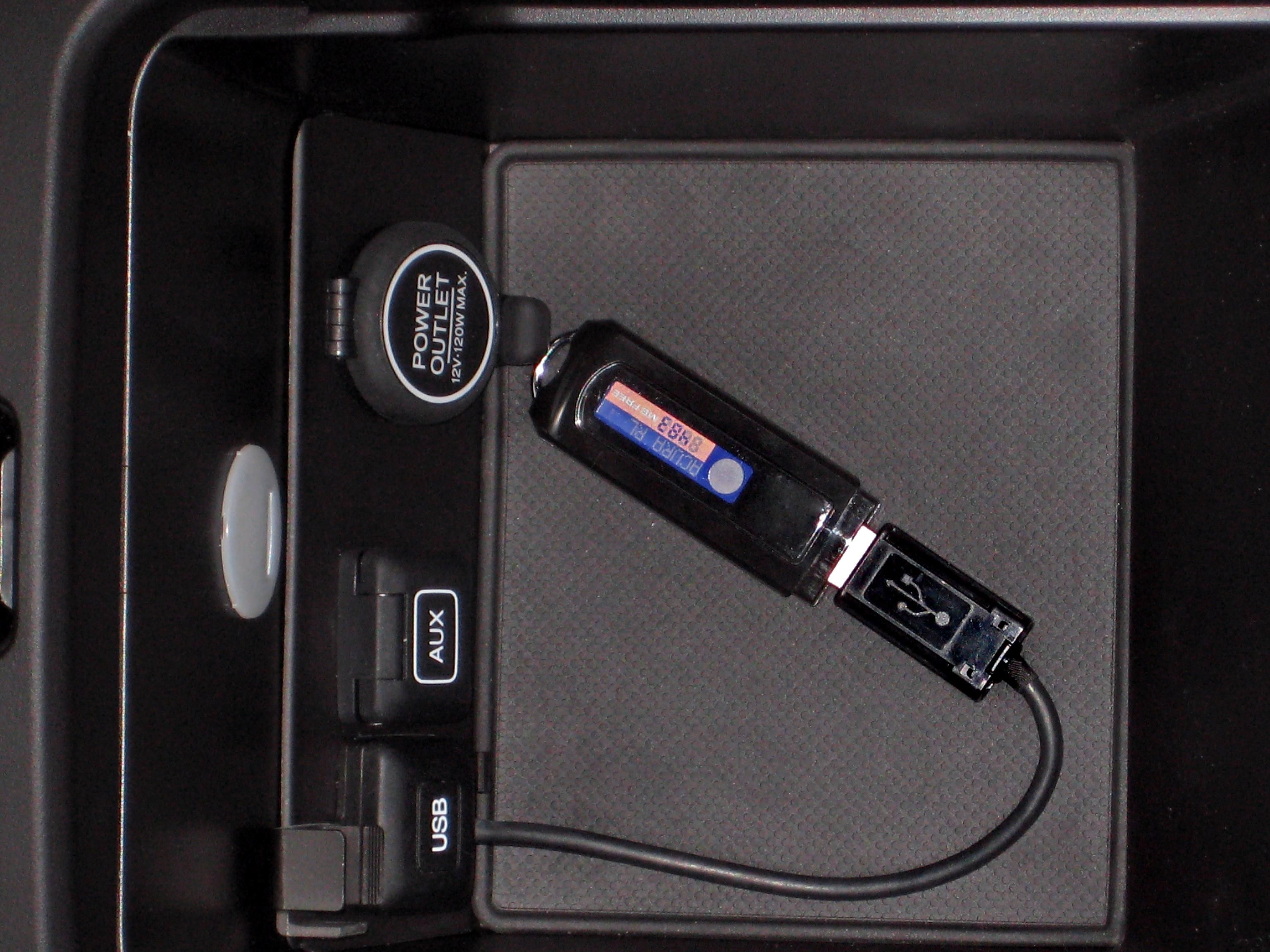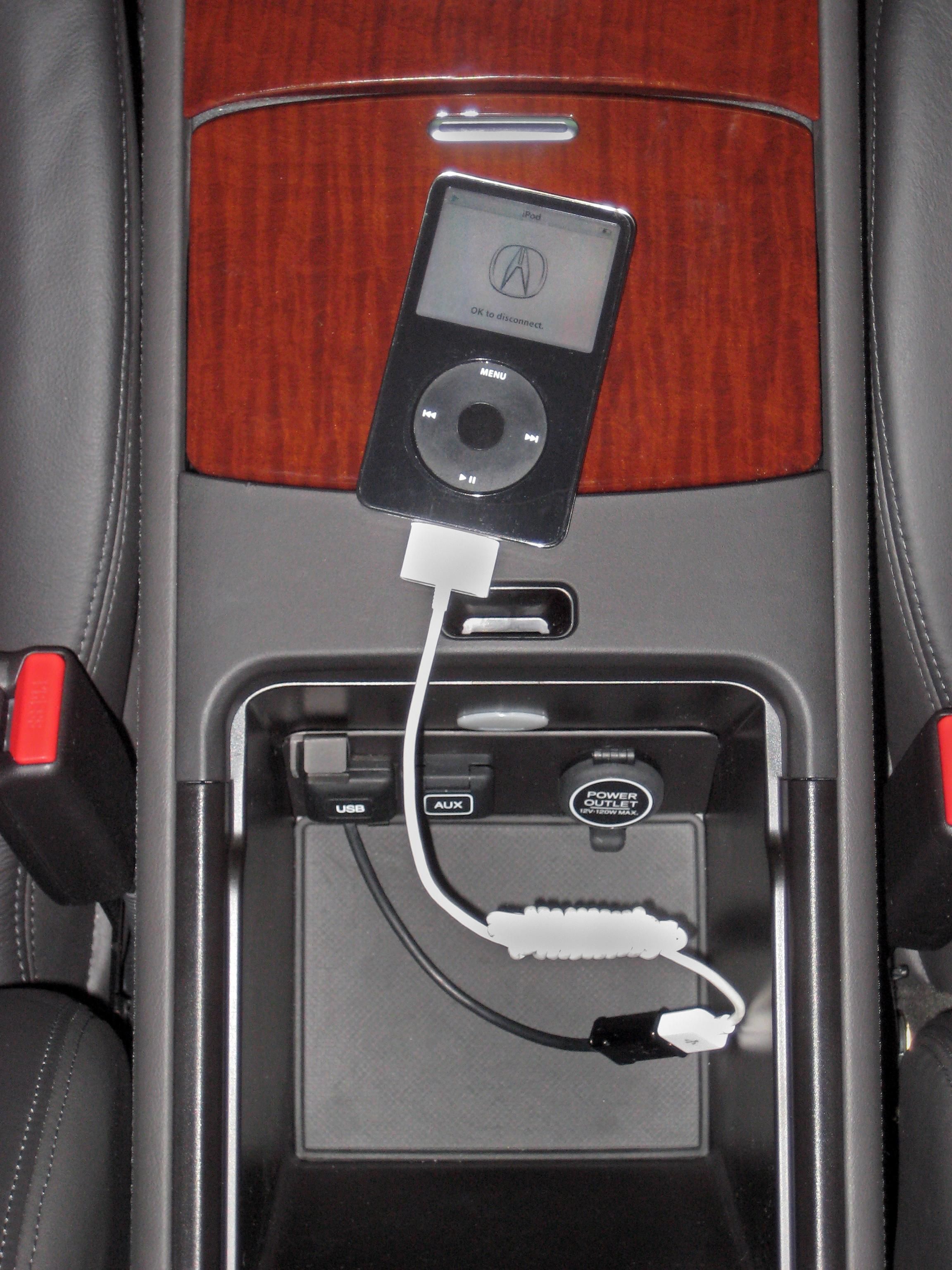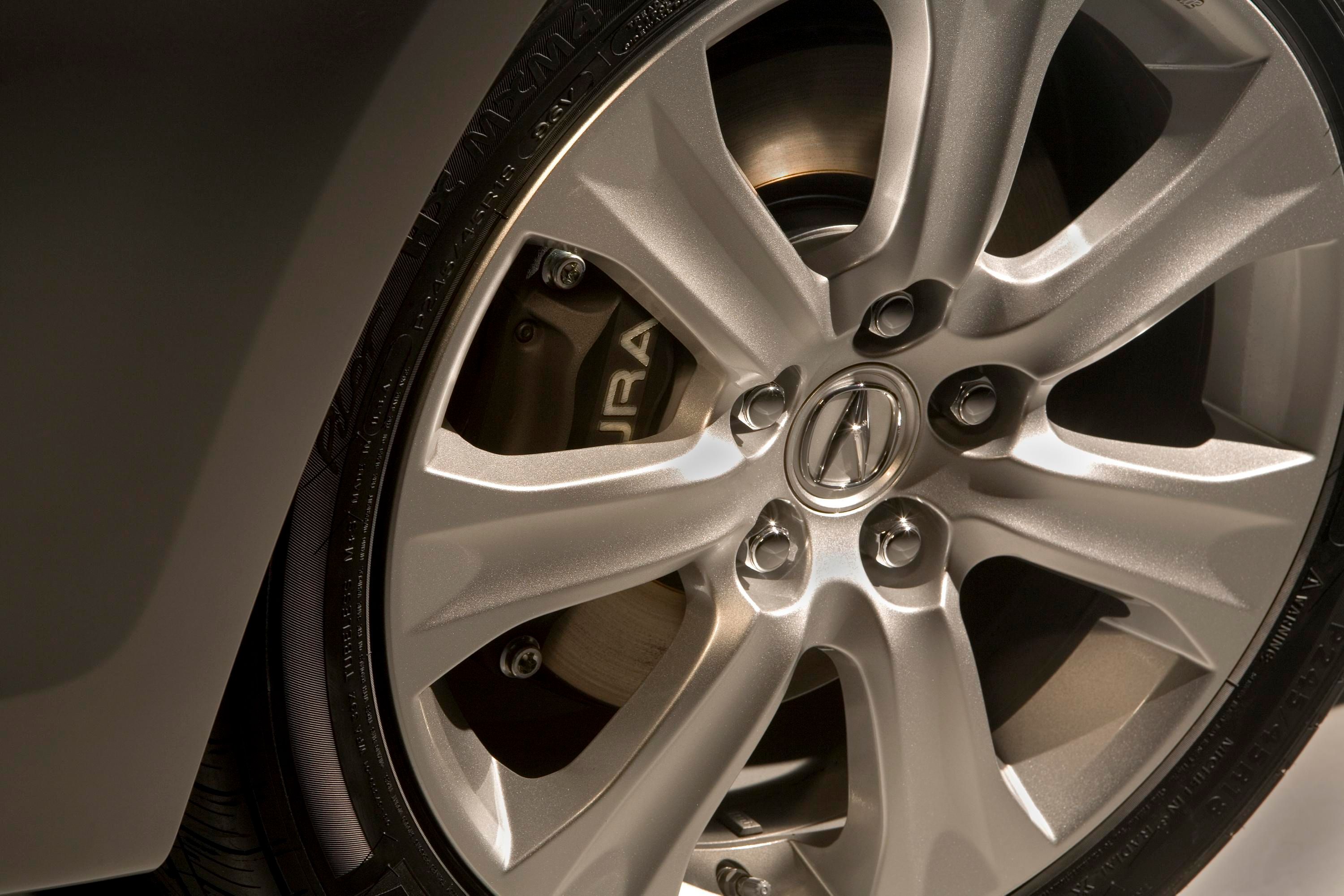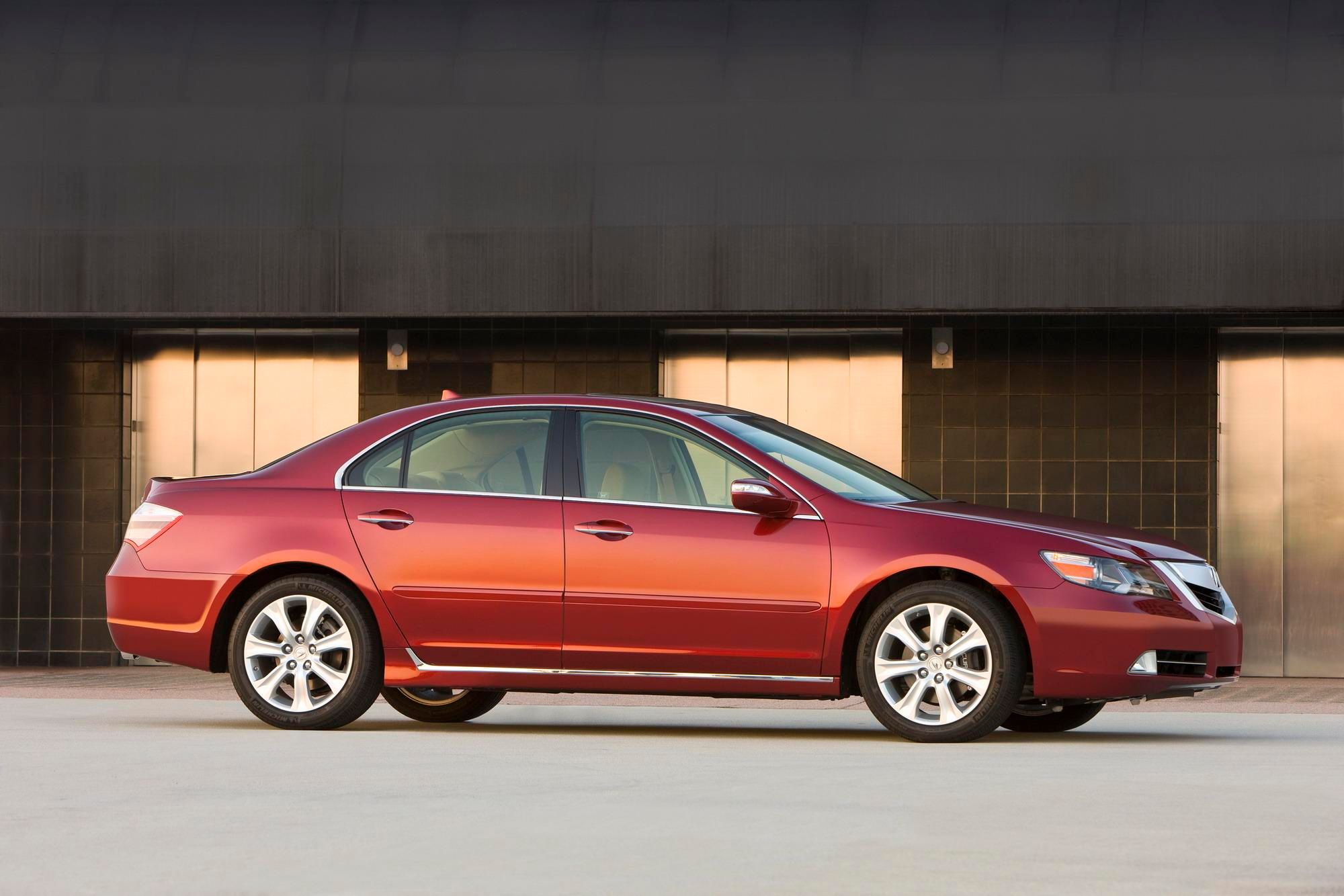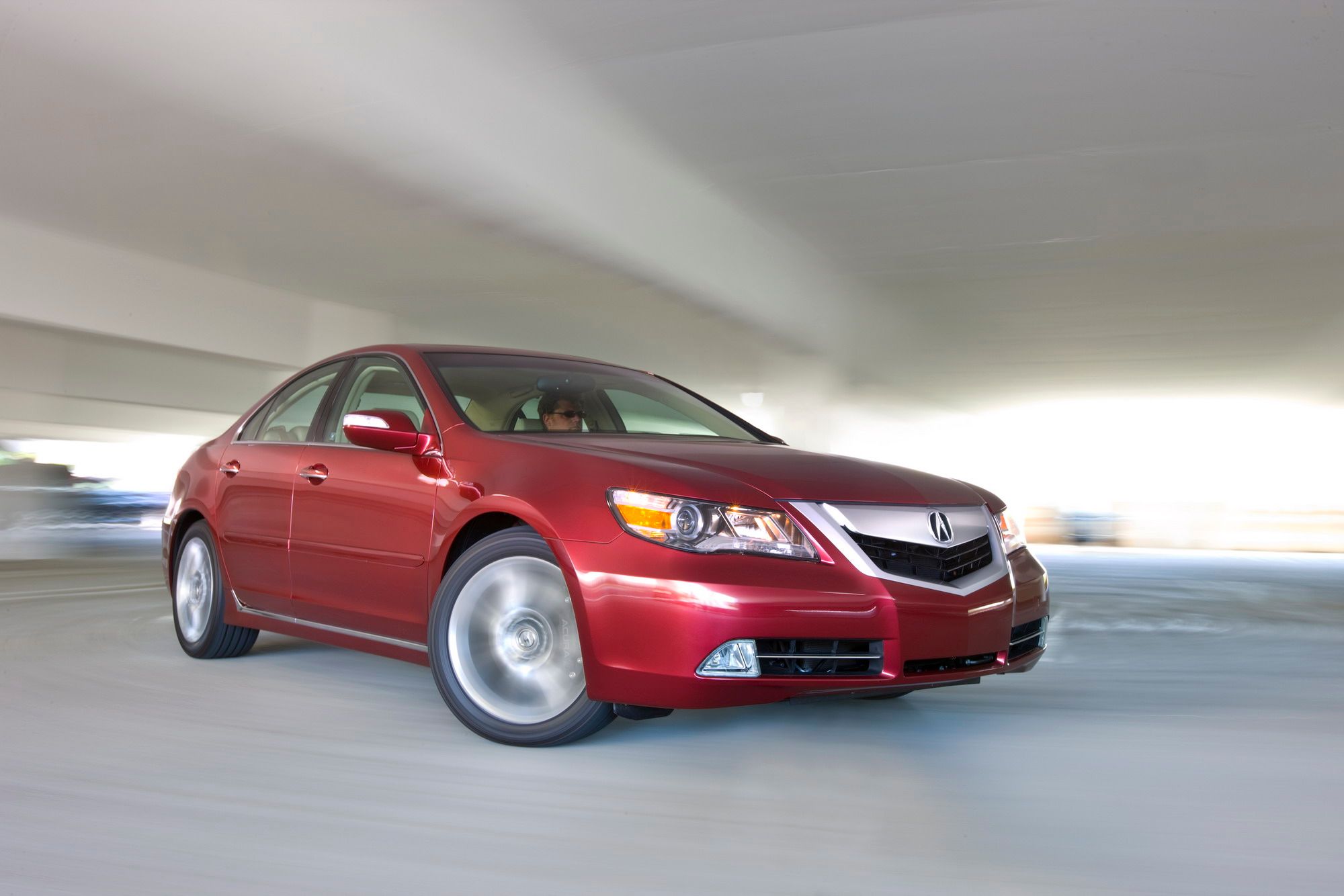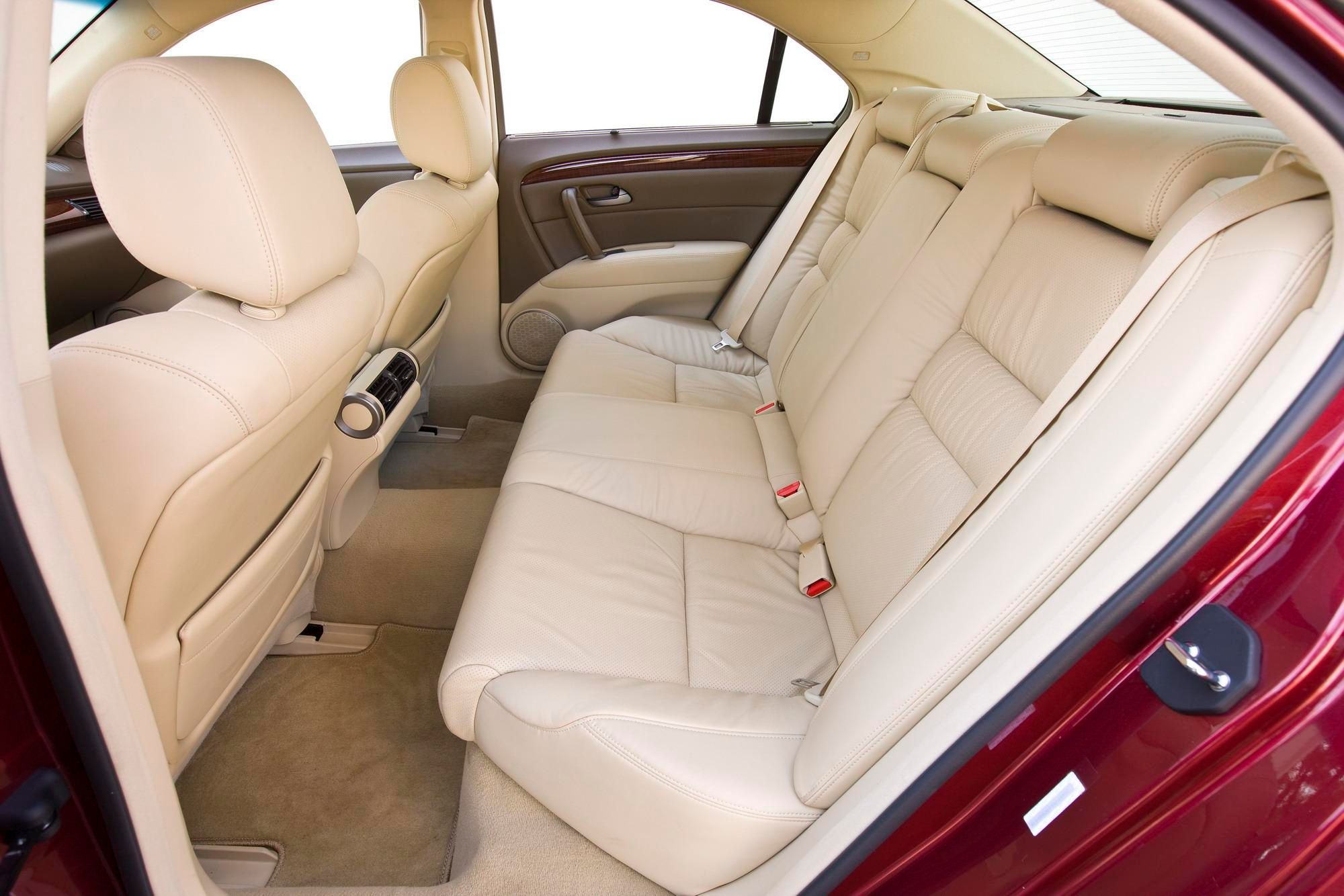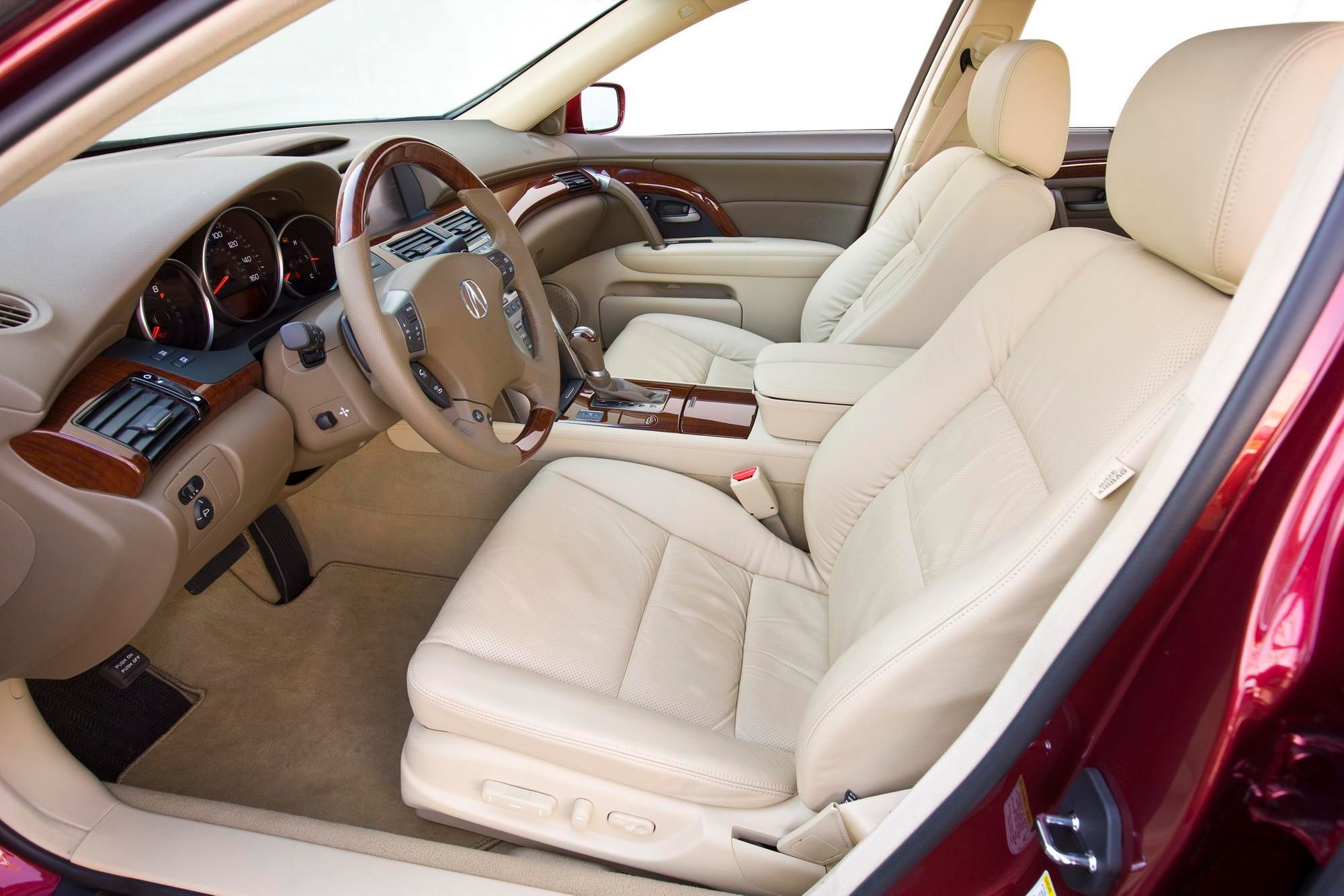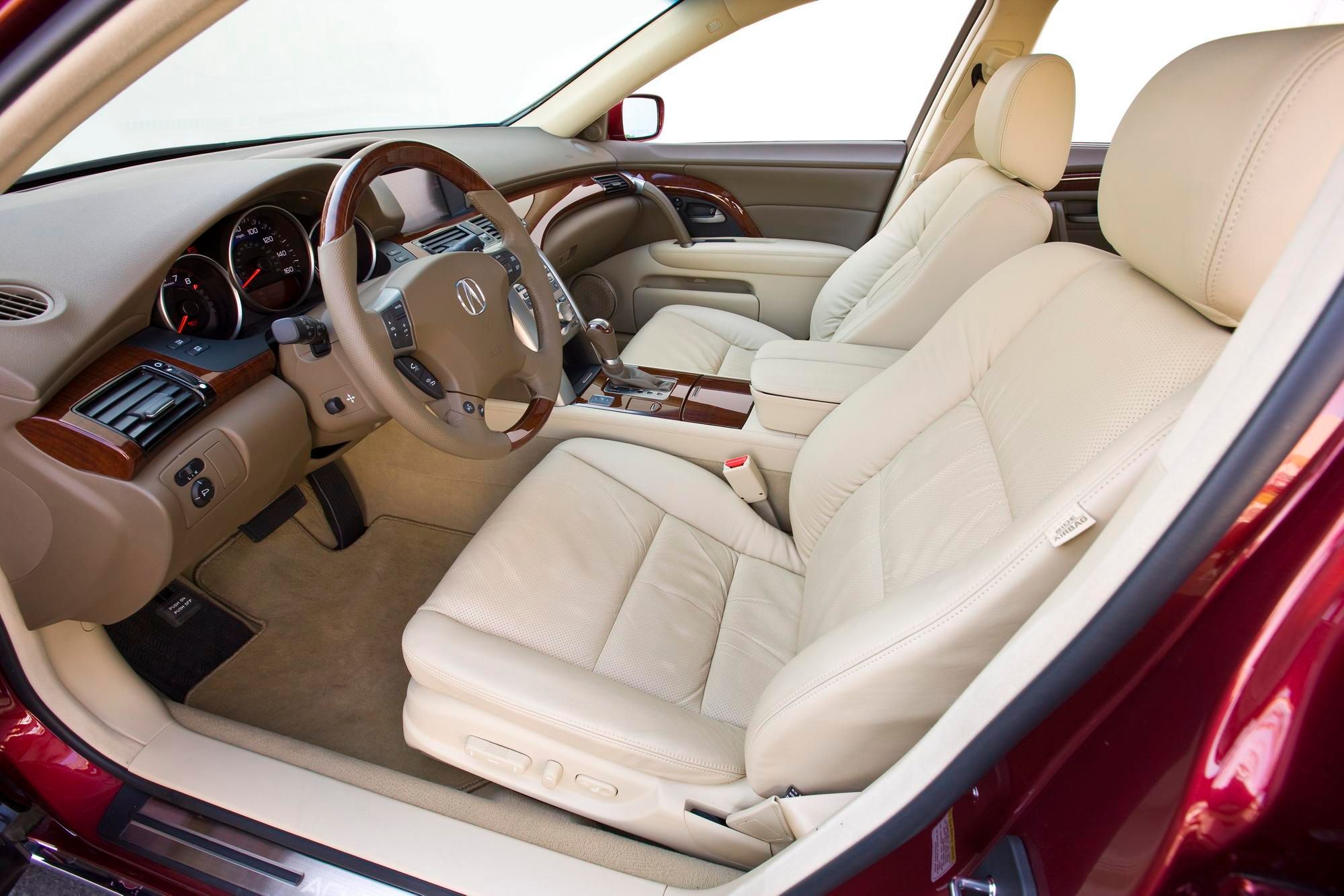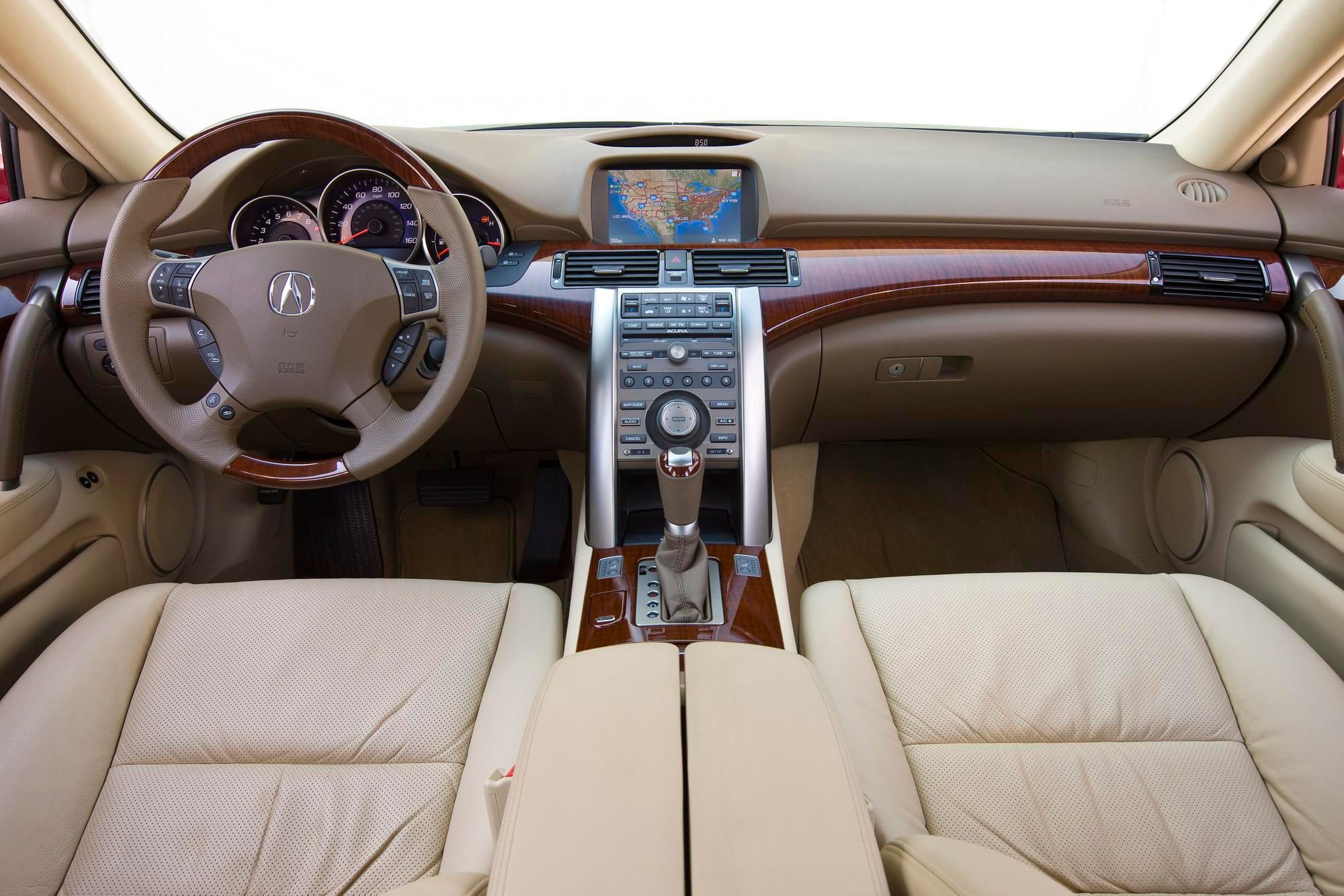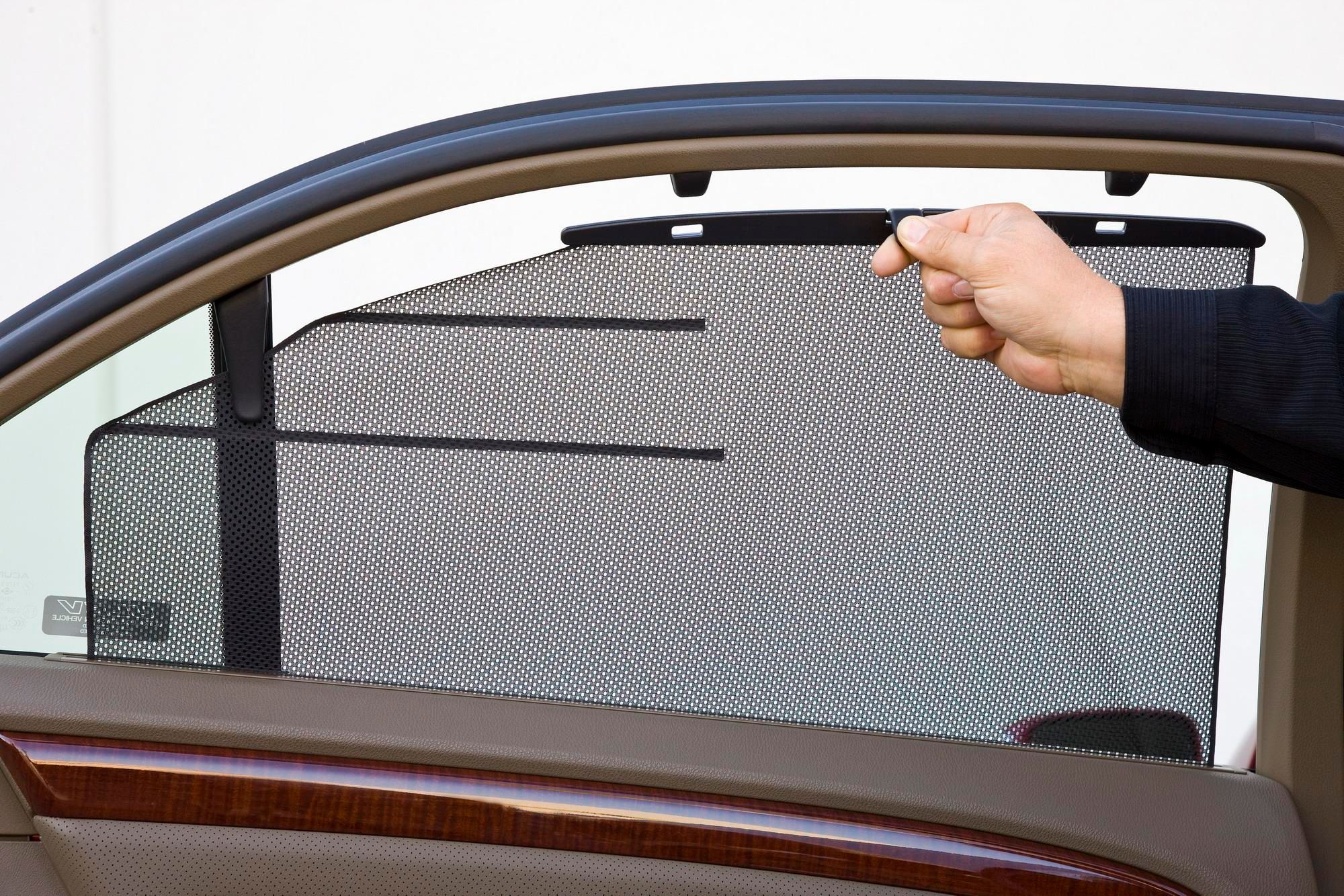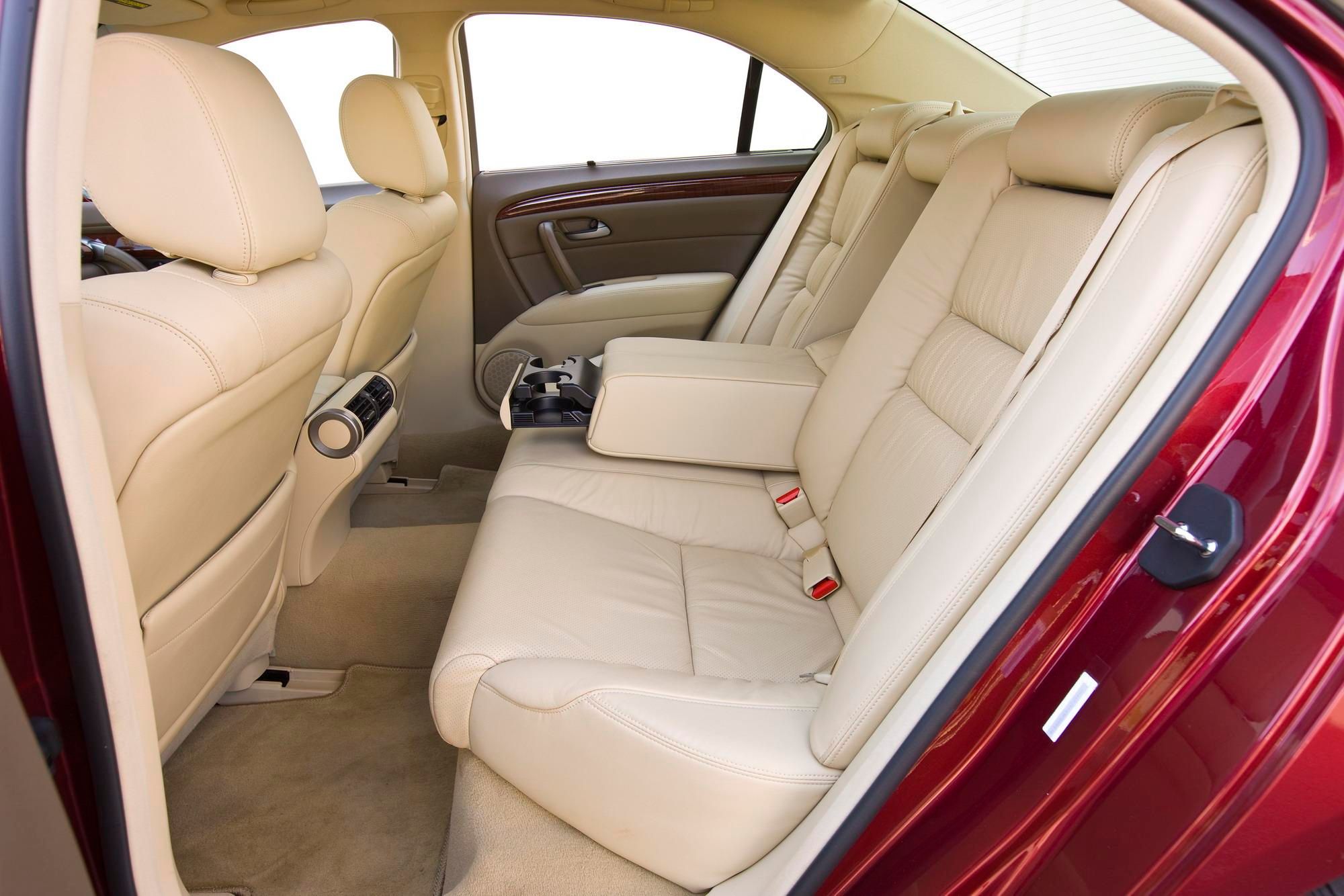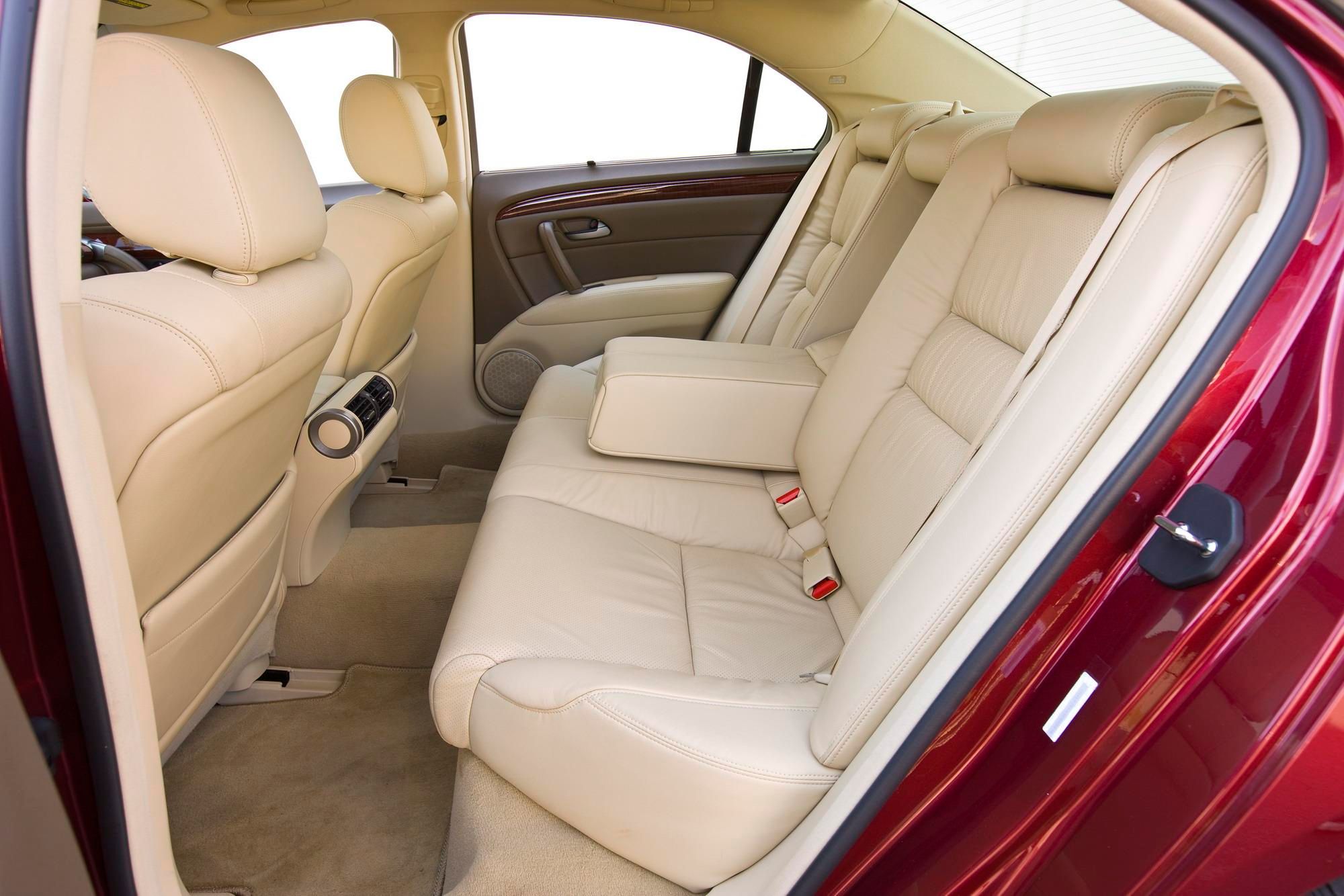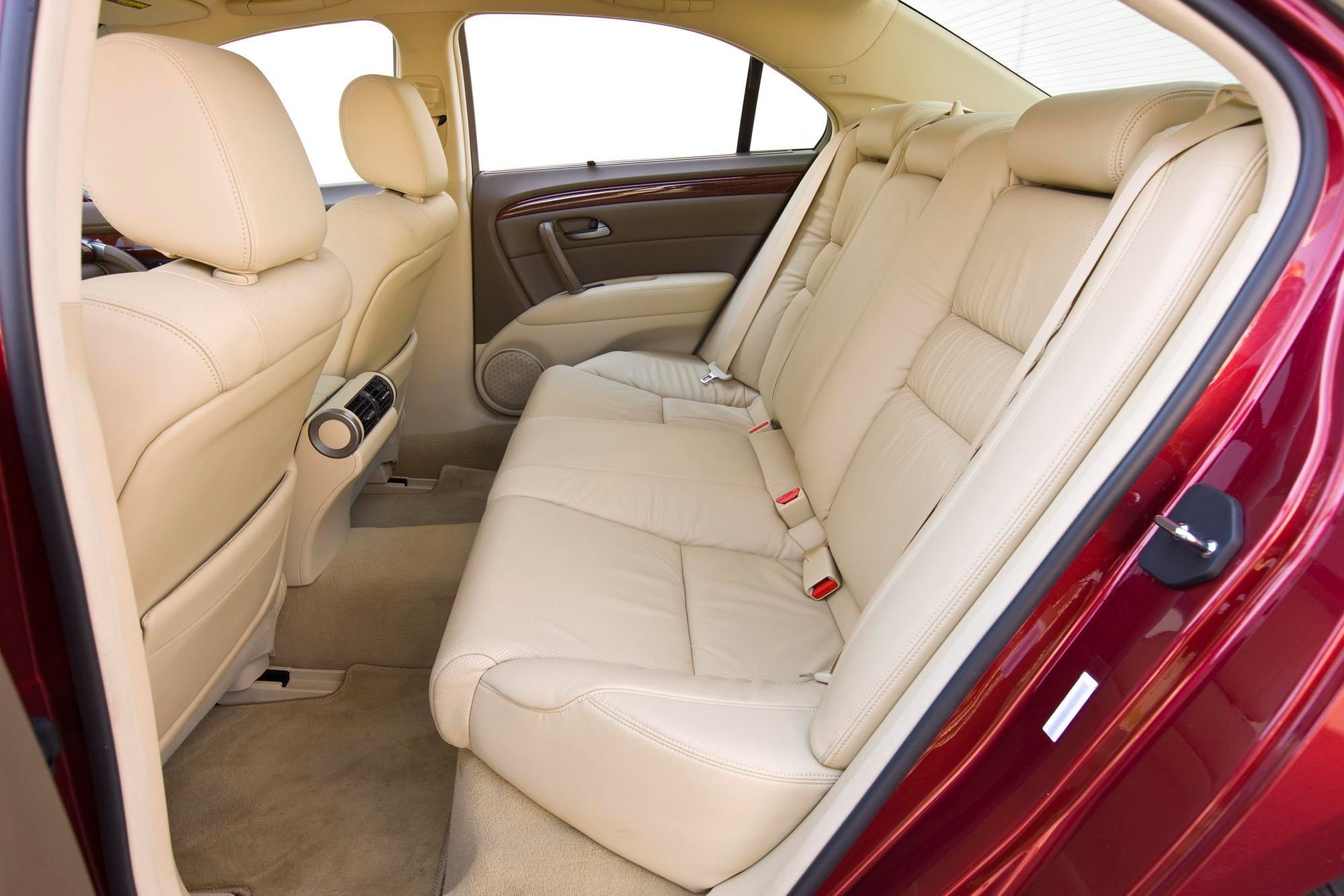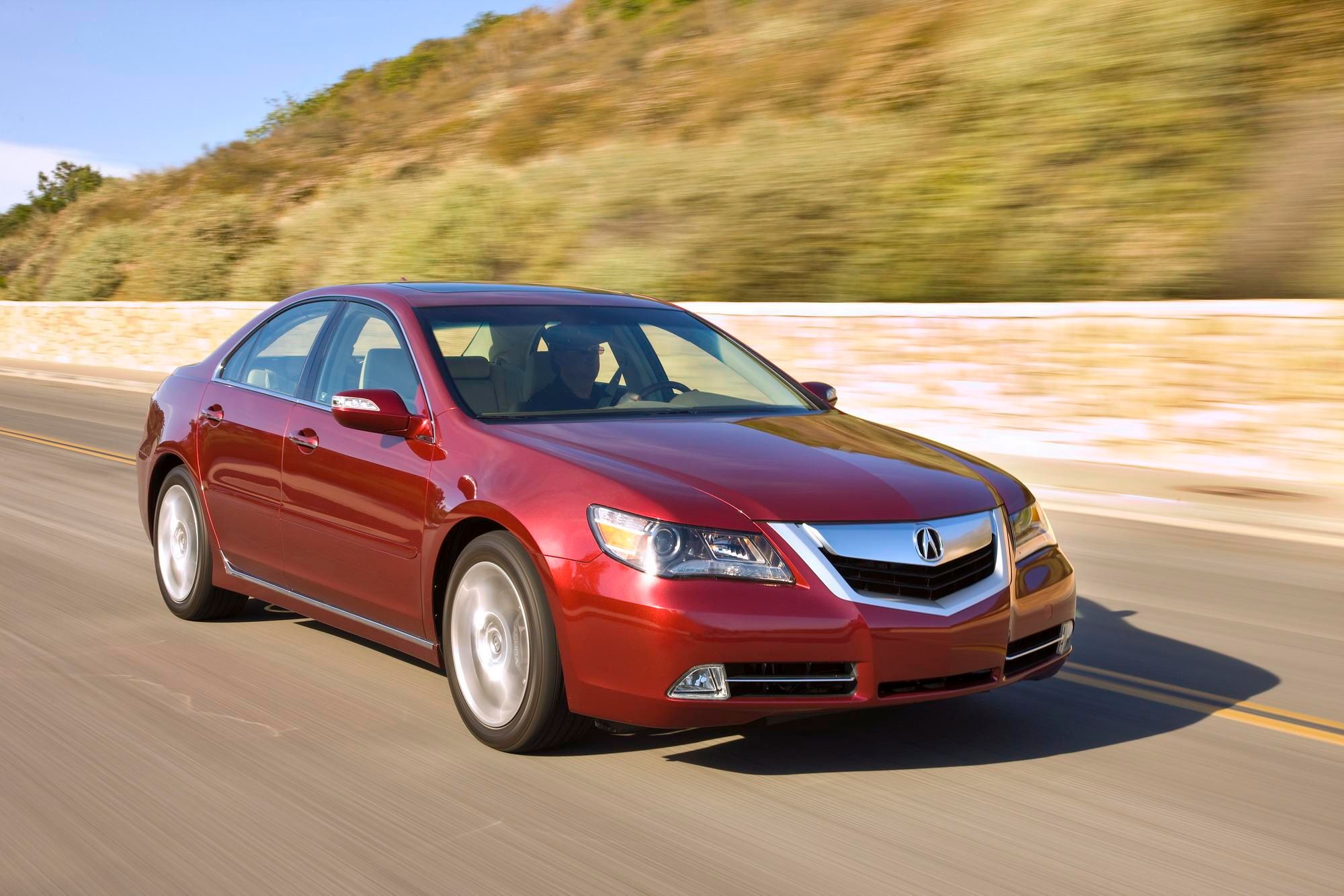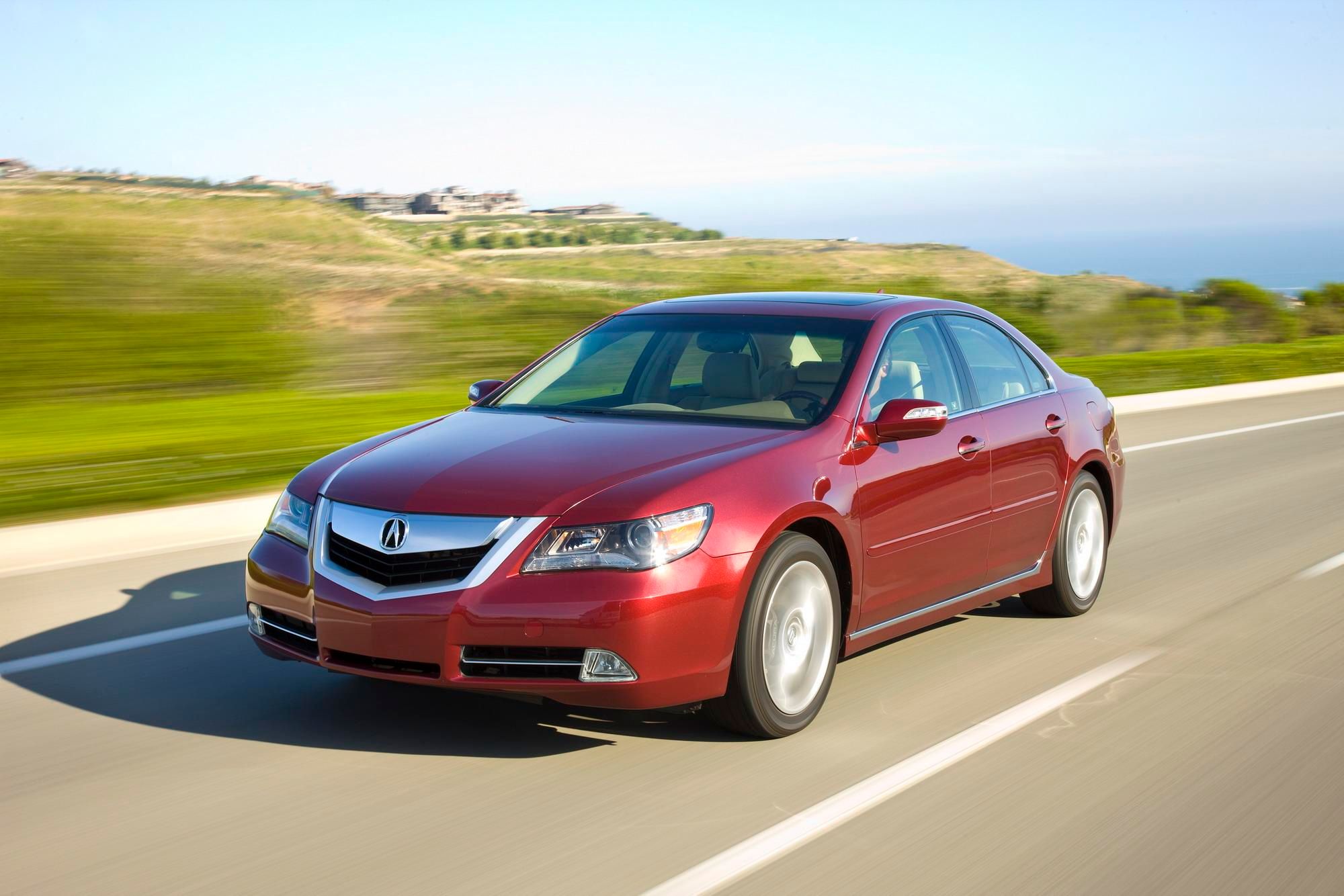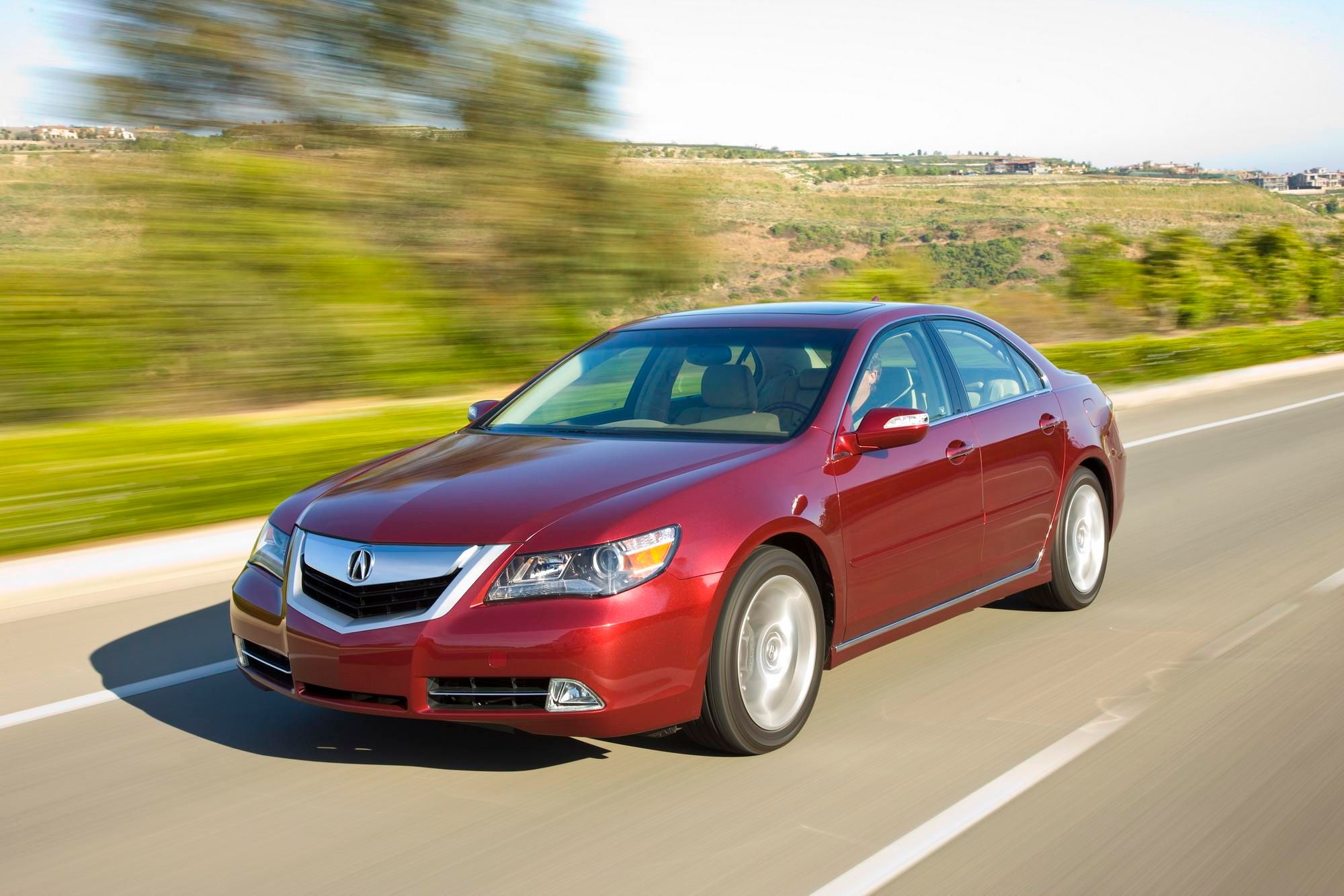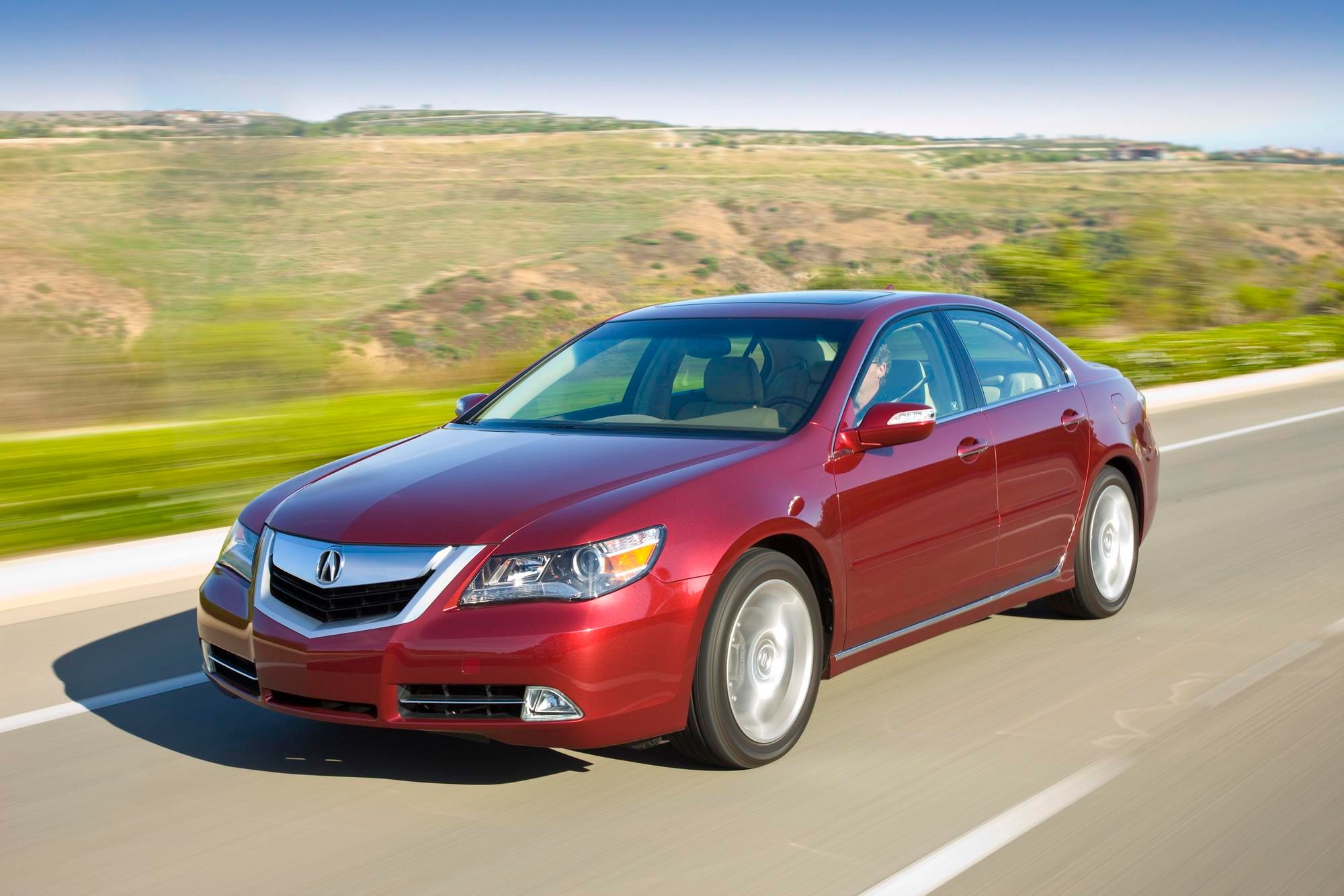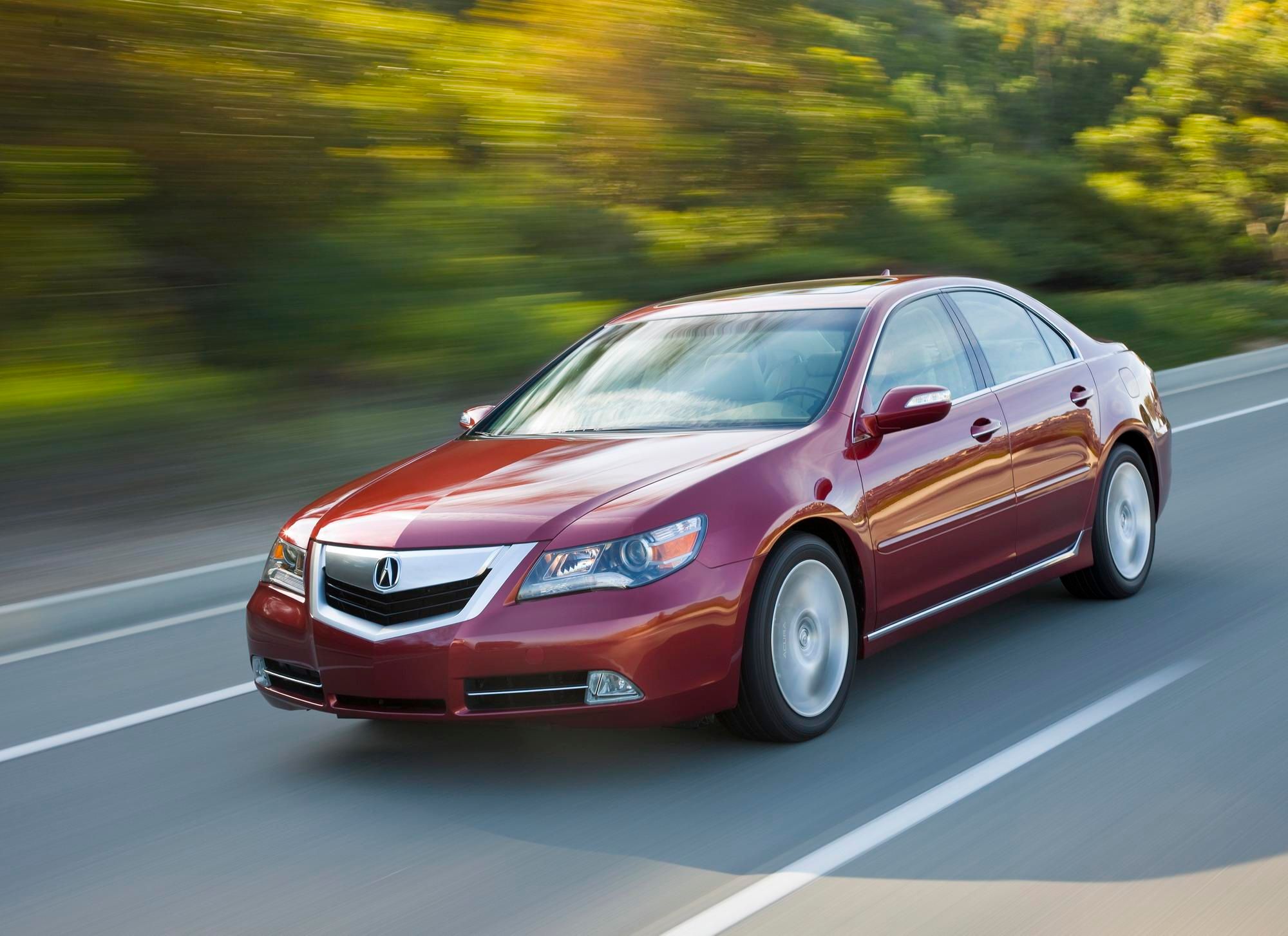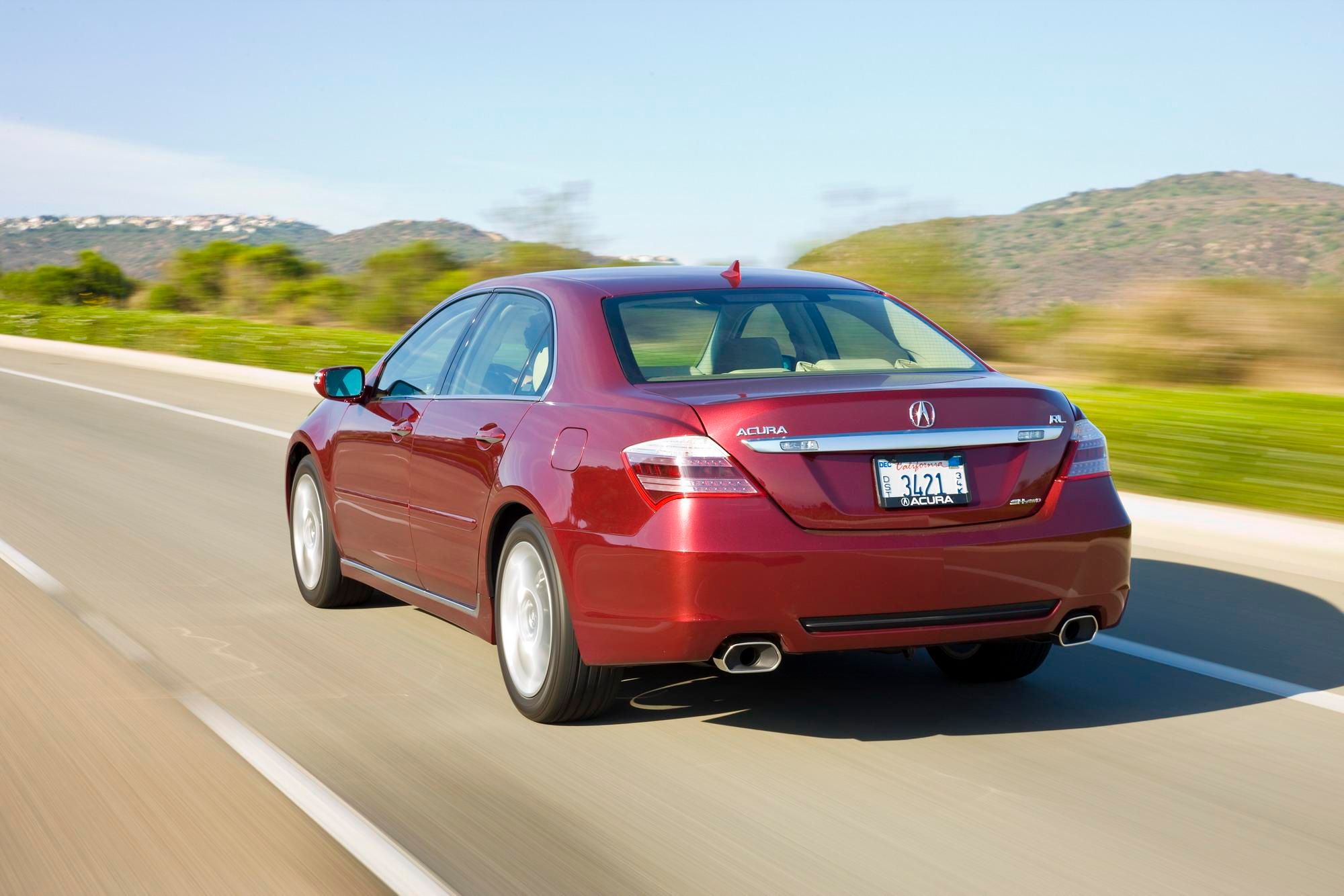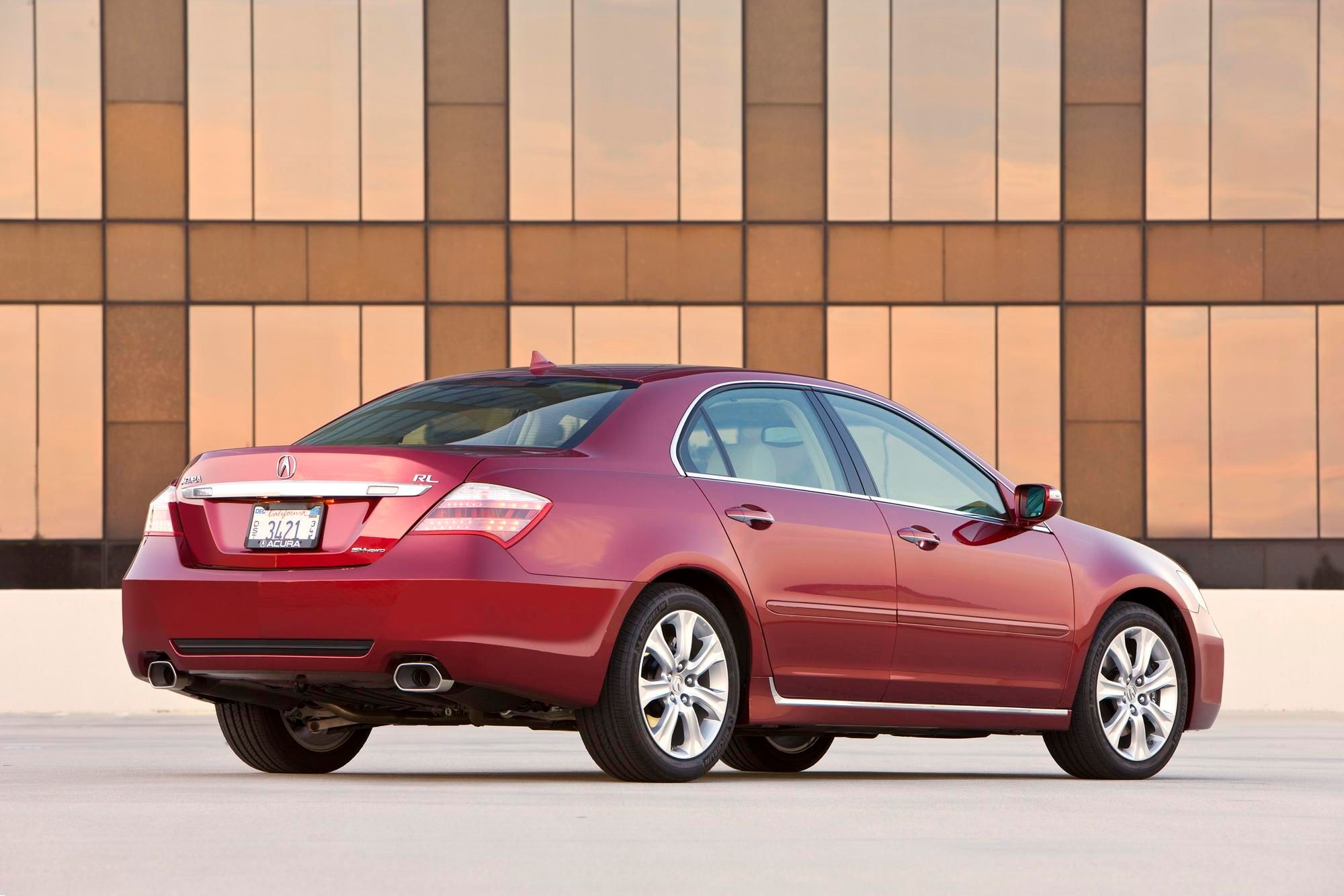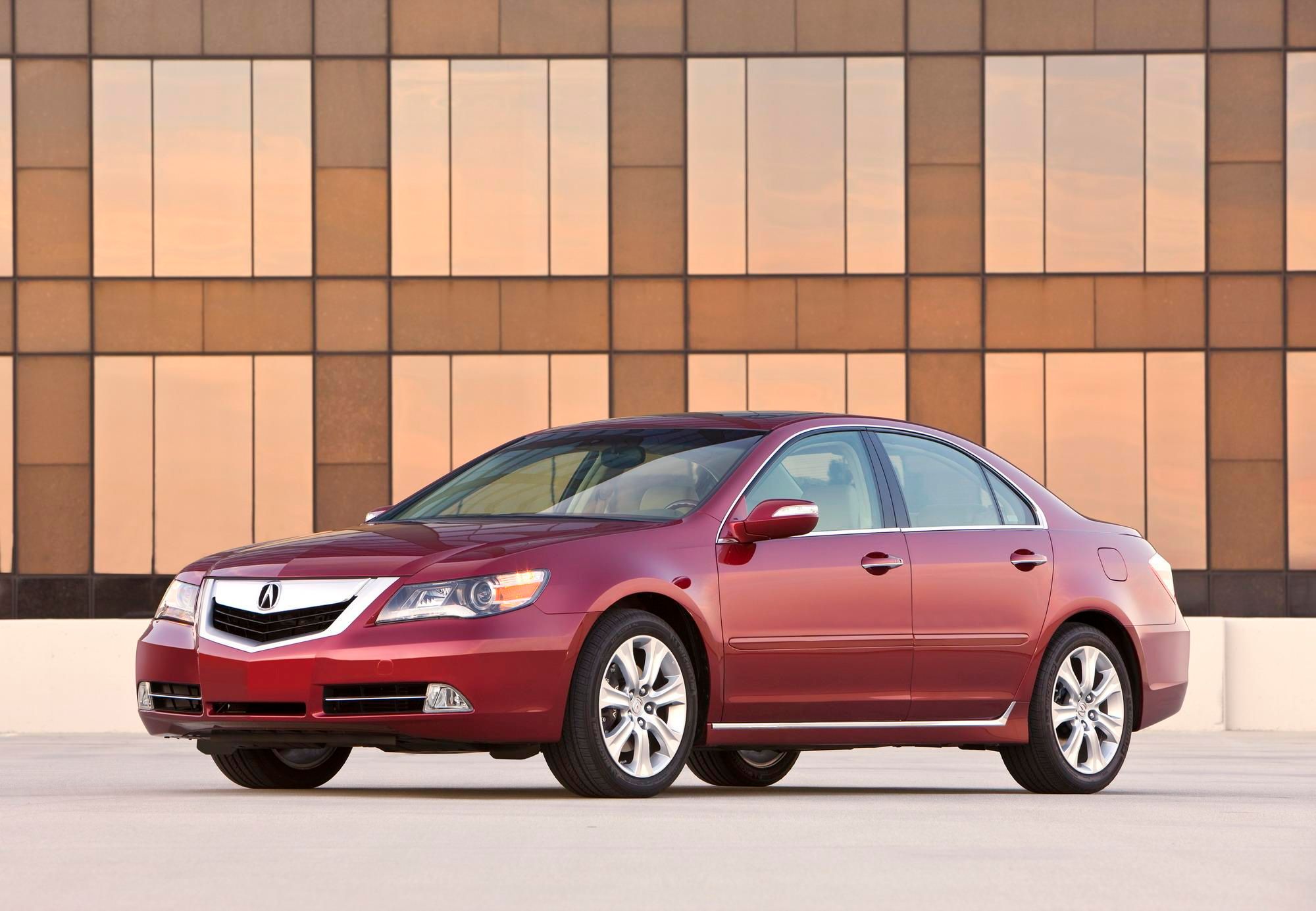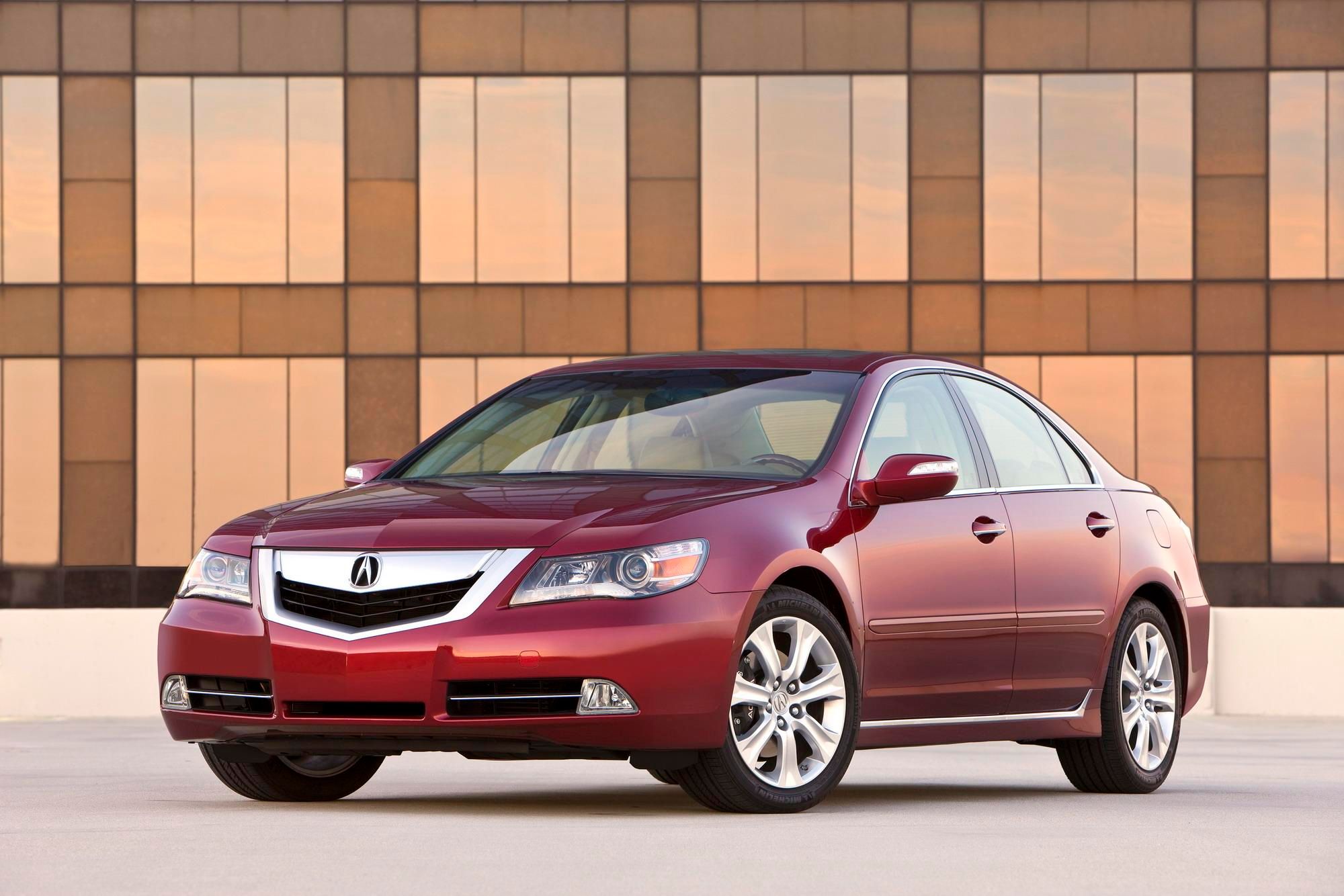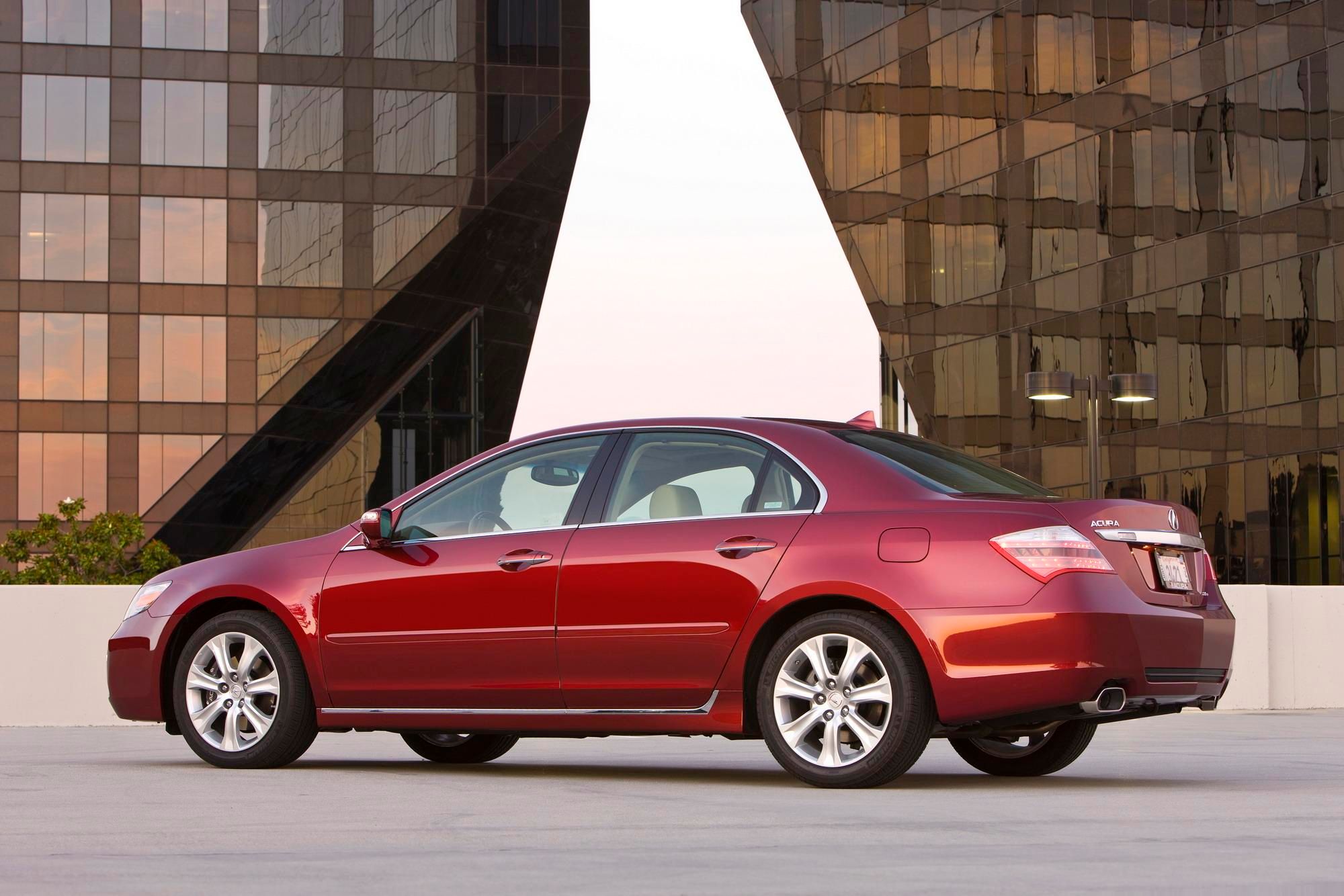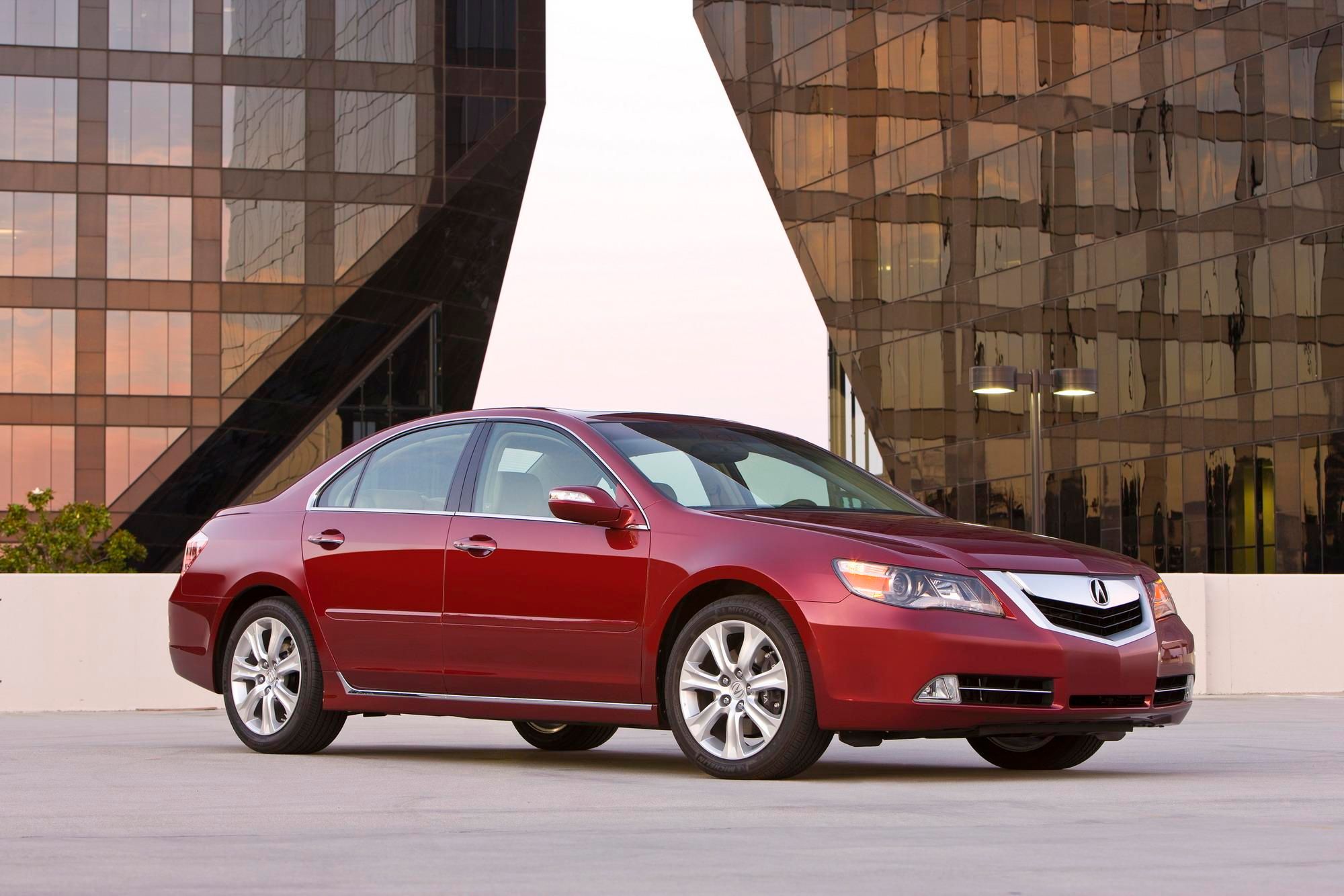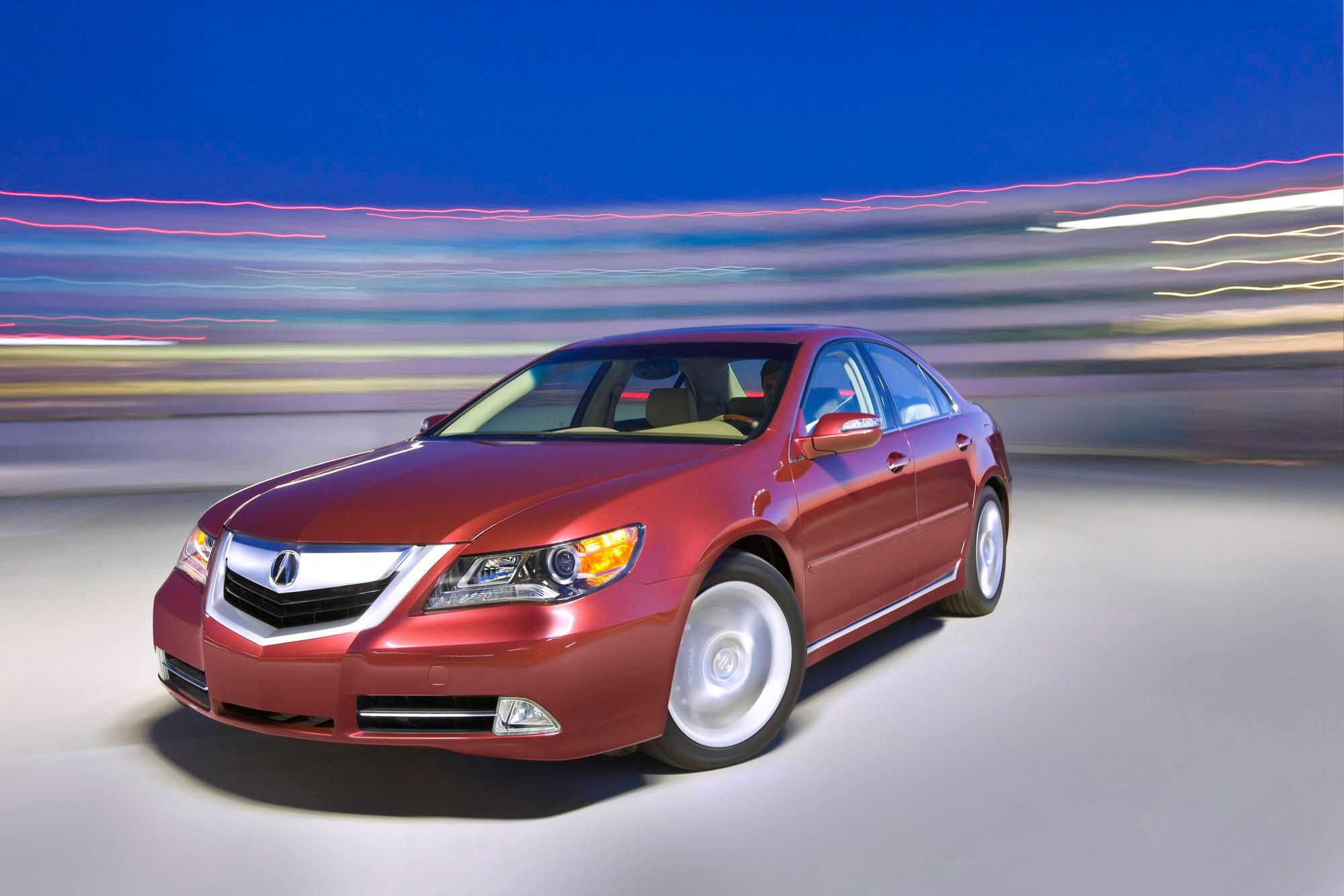Acura unveiled at the Chicago Auto Show the 2009 RL, a new generation featuring bold, sleek exterior styling, an upgraded interior, advanced technologies and powerful new engine.
The 2009 RL will be powered by a a new, larger 3.7-liter V-6 that incorporates the first ever SOHC use of VTEC valvetrain actuation for both the intake and exhaust valves. The engine develops 300 horsepower and 271 lb-ft of torque. The engine is mated to a new version of the Sequential SportShift 5-speed automatic transmission.
The RL will be offered in three different trim levels including RL, RL with Technology Package and RL with Technology Package Plus CMBS™. All RL's receive a potent new 3.7-liter V-6 engine, Super Handling All-Wheel Drive™, a Bose Surround Sound audio system, Bluetooth HandsFreeLink connectivity and a GPS-based solar-sensing climate control system.
The 2009 RL's new exterior styling is not only more aggressive, but delivers excellent aerodynamics and reduced rear lift at higher speeds. The RL's more athletic style foreshadows the power concealed by the new power plenum front grille and blow-formed aluminum hood. The RL's shape is taut and athletic, and its acceleration and cornering performance allow it to challenge the most capable German and Japanese sports sedans.
Press release after the jump.
2009 Acura RL
- Make: Array
- Model: 2009 Acura RL
2009 Rolls Royce Phantom Coupe
- Make: Array
- Model: 2009 Rolls Royce Phantom Coupe
- [do not use] Vehicle Model: Array
Press release
Acura's flagship, the new RL sedan, again proves that refined luxury need not be replete of performance adrenaline. The new 2009 Acura RL combines added performance, improved technology, more aggressive styling and safety features to Acura's premier sedan that was already top tier amongst luxury performance sedans. It would be hard to find a production car at any price that offers more advanced electronic technology or drive system sophistication. Now, the new 2009 RL allows the driver to be even more connected to the world-through improved connection with the road along with improved electronic connectivity to the world around them.
The previous RL offered an abundance of consumer friendly technology for the driver and passengers including satellite-linked Acura Navigation System with Voice Recognition™, AcuraLink® Real-time traffic information, Bluetooth® HandsFreeLink® cellular phone connectivity, DVD-Audio stereo entertainment, Active Noise Cancellation, and GPS-linked solar-sensing automatic climate control. The 2009 RL furthers cutting edge technology with the addition of new high-tech items including AcuraLink® weather, a new Note function for XM® Radio, Traffic Rerouting™, Active Sound Control, Smart Entry, Bluetooth® Audio and HandsFreeLink® that now features over 700 voice commands along with substantially improved voice recognition. Technology abounds in the drivetrain in the form of improved Super Handling All-Wheel Drive™, a revised steering rack system, upgraded coil springs, better performing shock absorbers, larger rear stabilizer bar, and more aggressive wheels and tires. Performance improves with the RL thanks to a new 3.7-liter V-6 engine that incorporates the first ever SOHC use of VTEC® valvetrain actuation for both the intake and exhaust valves.
For 2009, Acura will again offer three different trim packages on the RL:
- RL: in addition to the potent new 3.7L V-6 engine and Super Handling All-Wheel Drive™, the RL is equipped with standard Bose® Surround Sound audio system, Bluetooth® HandsFreeLink® connectivity and solar sensing climate control.
- RL with Technology Package includes: Acura Satellite Navigation System with Voice Recognition™, AcuraLink® Real-time traffic, AcuraLink® weather, rear view back-up camera, Active Front Lighting System (AFS), ventilated front seats, and a wood/leather steering wheel and shift knob.
- RL with Technology Package plus CMBS™: on top of the Technology Package, the CMBS™ equipped model includes Acura's Collision Mitigation Braking System™ (CMBS™), Adaptive Cruise Control (ACC), and genuine wood instrument panel trim.
CMBS™ uses a millimeter-wave radar unit mounted inside the RL's new power plenum front grille to detect vehicles ahead to monitor potential rear-end collisions, to alert the driver when the likelihood of a collision increases, and to help reduce the impact on front occupants by pre-tensioning the front seatbelts and applying the brakes should a collision prove to be imminent.
RL with Technology Package plus CMBS™ also adds the convenience of Adaptive Cruise Control (ACC). The ACC also uses the radar system mounted inside the front grille to measure the distance between the RL and the vehicle directly ahead. To compensate for varying traffic flow, ACC continually adjusts vehicle speed by automatically applying throttle or braking to maintain a consistent following distance interval.
The innovation built into the new RL begins with the most powerful engine ever offered in an Acura sedan. An all-new 3.7-liter V-6 engine develops 300 horsepower and 271 lb-ft of torque thanks to an innovative new VTEC™ valvetrain system for both the intake and exhaust valves, a higher compression ratio, along with a special dual-stage magnesium intake manifold that enables the intake to function as a single- or dual-plenum manifold design based on engine operating parameters. In addition to developing improved power and torque, the RL engine meets tough CARB ULEV-2 emission standards and delivers good fuel economy. The RL's engine bay appears more upscale thanks to a new surround panel assembly that reduces visual distractions and focuses attention directly on the all-new 3.7-liter V-6 engine.
To handle the higher power of the 3.7-liter engine, a new version of the Sequential SportShift 5-speed automatic transmission is fitted to the 2009 RL. Featuring new "smart" F1®-style steering wheel mounted paddle shifters and a new straight-gate console mounted gear selector, the RL driver now has more gear control than ever before.
The RL's acclaimed Super Handling All-Wheel Drive™ (SH-AWD™) system returns for 2009, but is now quicker responding and better performing. There are numerous traction advantages of all-wheel drive, yet SH-AWD™ does a key function that is not available with traditional AWD systems- SH-AWD™ utilizes torque vectoring to increase the rotation speed of an outside rear wheel during aggressive cornering to help the car turn more effectively while under power. This "yaw" function reduces the cornering load on the front tires to minimize understeer, to improve handling balance, and to escalate total cornering grip.
The 2009 RL's new exterior styling is not only more aggressive, but delivers excellent aerodynamics and reduced rear lift at high speeds. The RL's more athletic style foreshadows the power beneath the new blow-formed aluminum hood. The RL's shape is taut and athletic, and its acceleration and cornering performance allow it to challenge the most capable German and Japanese sports sedans. Comfort, quietness and ride quality are also on a par with performance sedan competitors. For 2009, eight exterior colors are available-5 of which are new-including a new pearl pigment process that improves luster and shine.
To further enhance handling and ride comfort, the new RL retains a fully independent suspension system with front double-wishbone and rear multi-link architecture. For 2009 the RL features higher rate coil springs, larger diameter rear stabilizer bar, stiffer subframe mount bushings and improved design steering rack components. To further improve handling and looks, new 18-inch diameter 7-spoke aluminum wheels are matched with more aggressive tires (replacing the previous 17-inch wheel/tire offering).
Inside, the 2009 RL features a more elegantly styled interior that includes more room for rear seat passengers, easier-to-use front seat belts, front door-mounted pull pockets, softer arm rests, redesigned vents, larger/clearer lettering for HVAC controls, and easier actuation of climate control functions. A revised steering wheel and genuine wood dashboard trim (included with the CMBS™ package) and metal-look accents is now fitted to the RL along with a transmission shift knob with simulated wood trim. Complementing the steering wheel are upgraded gauges that incorporate brushed metal accents for enhanced appearance. For 2009, additional insulation, a more high-tech design of Acura's acoustic glass windshield, and a new Active Sound Control noise abatement system team to further reduce the RL's already quiet cabin.
The RL's perforated leather front seats now incorporate six levels of heated/cooled ventilation. Moreover, just like the driver's seat, the passenger front seat now has 10-way power adjustability. For 2009, the center panel controls are now more intuitive and are surrounded by a new background color along with improved quality wood patterned panels. These interior upgrades are complimented by advanced electronics that include a satellite-linked Acura Navigation System with Voice Activation™ along with the innovative AcuraLink® satellite communication system with Real-time traffic and (new for 2009) AcuraLink® weather. The RL is the first vehicle on the market to feature in-dash integrated, continually updated real-time weather information in a single-screen format. The spectacular Acura/Bose® 10-speaker Sound System with DVD-Audio returns but is now upgraded to include Bluetooth® Audio, a new Note function for XM® Radio, improved button legibility, a USB connectivity port, and even richer audio sound.
The 2009 RL retains Acura's extremely rigid Advanced Compatibility Engineering™ (ACE™) body structure that features extensive use of high-tensile steel and lightweight aluminum components to take construction beyond conventional safety protocols while keeping overall vehicle weight in check. The ACE™ structure's front-mounted polygonal main frame is designed to help prevent cabin deformation by distributing forces through multiple major load bearing pathways-and away from the passenger compartment. For 2009, to enhance safety a new Active Headrest Restraint System is built into the front seats to improve neck and head protection in the event in a rear impact collision. To further aid in safety, the RL includes as standard a passenger seatbelt reminder, Tire Pressure Monitoring System (TPMS), and six airbags. These advances team to make the RL the most powerful, best handling, most luxurious and safest sedan Acura has ever built.
Prices
|
RL |
Trim Name |
Trans |
2009 MY |
EPA |
|
RL |
5AT |
$46,680 |
16/22 |
|
|
RL w/ Technology Package |
5AT |
$50,300 |
16/22 |
|
|
RL w/ CMBS |
5AT |
$54,100 |
16/22 |
|
|
RL (Hawaii) |
5AT |
$50,300 |
16/22 |
-----
Body
The 2009 Acura RL incorporates fresh exterior bodywork that generates a crisper, yet more muscular, luxury performance sedan. The RL combines its dynamic exterior and interior design with advanced body and chassis engineering. The result is distinctive and appealing styling, together with excellent maneuverability on the road. To ensure that the RL has exceptional dynamic capabilities and driving quality, it is outfitted with a lightweight and highly rigid body structure that makes extensive use of both high-tensile steel and aluminum components, and features 4-wheel independent suspension.
DESIGN CONCEPT
Acura designers wanted to create a taut and athletic shape that conveyed the performance capabilities of the RL without sacrificing comfort and capability.
To create an exhilarating, athletic sedan, the designers targeted superior dynamic performance, superb maneuverability, distinctively appealing styling, and a high level of active safety. The result is a top-flight luxury performance sedan able to compete with the Audi A6, BMW 5 Series, Mercedes-Benz E Class and others.
Design Image
With the new 2009 RL, Acura designers set out to employ a new "Keen Edge Dynamic" look of improved character and athleticism. To help craft the fresh design image, styling cues include the following:
- Improved aerodynamic design with low drag and improved high-speed stability
- A new "power plenum" front grille that is in design concert with the new Keen Edge Dynamic design grille for all new Acura vehicles
- A new front hood constructed of lightweight aluminum and designed for increased forward visibility and reduced aerodynamic drag
- A redesigned trunk lid that reduces rearend lift at high speed and provides added visual character
- More aggressively styled front and rear bumpers
- New lower rocker panel side moldings with inset chrome trim accents
- Flush-mount side glass for reduced wind noise
- Restyled, more aggressive front headlights that incorporate Active Front Lighting System (AFS)
- Restyled, more aggressive rear taillights
- Reverse gear back-up lights integrated into the rear trunk lid for improved visibility
- New hexagonal-shaped, polished chrome dual exhaust tips
- Five new exterior color choices
- All-new pearl paint technology that provides improved luster
Aero Sculpture
The specific aerodynamic properties of the RL complement the styling, safety, dynamic performance, stability, human factors and other considerations. To achieve this high-performance exterior, the RL designers created a strong wedge shape that begins its "momentum" with the hood, continues it with a forward-mounted acoustic glass windshield, and finishes with a short rear overhang. The aerodynamic cabin has flush side glass for reduced drag and less wind noise. With further improved aerodynamic performance, the 2009 RL is designed to look like it moves fast.
The packaging goal for the RL was to create a taught body with short overhangs while simultaneously providing wide interior dimensions for enhanced comfort and convenience.
Controlling the weight of the RL is important for maximum acceleration, road holding and braking performance - so lightweight materials and weight-saving design are key.
Light Weight
Producing a lightweight and rigid unit body was essential to making the RL a premium luxury performance sedan. Light weight construction techniques improve every aspect of the RL's dynamic performance and fuel economy, and a rigid structure improves ride and handling quality.
Specific RL strategies employed to reduce body mass include:
- Aluminum hood, front fenders, trunk lid, and trunk lid frame
- Aluminum front and rear subframes, suspension arms, front knuckles and bumper beams
- Magnesium intake manifold, cylinder head covers and seat frames
- Carbon fiber reinforced composite driveshafts
Structural Solidity
The Acura RL was also designed with the goal of creating an automobile body that provides world-class safety. It was engineered to comply with the latest FMVSS208 occupant crash protection standard and FMVSS301 fuel system integrity standard.
One of the most difficult test modes to achieve is the side collision that models the impact of a RL being struck from the side by an SUV or a pickup truck. To meet these important benchmarks, engineers increased the side section of the frame to comply with new collision regulations (see Safety section for more information). Engineers also chose different material specifications to provide the desired level of stiffness and strength for critical areas, without adding unnecessary weight.
- The use of aluminum for the front and rear bumper beams, hood, trunk lid and front fenders saves 40 pounds compared to if made from steel.
- Extremely strong Grade 80 high-tension steel is used for the side sills, under-floor spars, and in the impact-absorbing crumple zones at the front of the side frames
- High tension Grade 45 steel is used on the front shock mounts, areas of the front passenger-compartment bulkhead, areas of the front subframe mounts, and rear structure
- Grade 60 steel is used for 31-percent of the body construction
- The overall result is a high level of bending and twisting rigidity for the unit body combined with enhanced crashworthiness- all with no additional weight penalty.
ALUMINUM COMPONENTS
The lightweight aluminum front fenders, trunk and trunk frame are formed with an innovative build process called blow forming to achieve complex and pleasing shapes-all with a high level of quality, low cost and lightweight construction. First, the raw aluminum panels are placed in a heated mold and warmed to 500-degrees Celsius. Next, the aluminum panels are forced into the mold with a high-pressure gas. The result is perfectly formed complex shapes that are not possible with traditional stamping methods.
For rigidity, the trunk lid is composed of an inner structural panel and an outer body panel. This 2-piece aluminum structure is crimped together with self-piercing rivets that make the lid highly durable.
DOOR CONSTRUCTION
Safety in side collisions, along with the pursuit of a quality door-closing sound, drove Acura engineers to design unique door structures. Special beams were applied for side-impact safety in both the front and rear doors.
There is no mistaking the quality sound that a well-engineered door makes as it is closes. By positioning door's center of gravity (the height at which its weight is centered) at the same height as the latch, audible vibration and the resulting closing sound can be improved. For improved entry and exit, the rear doors now open 80-degrees.
TRUNK OPENING
The 2009 RL features an all-new, more aerodynamic trunk lid. Specially designed to reduce rear lift during high speeds, the new trunk lid also provides improved styling with a European flair.
The trunk opening is reinforced to retain rigidity while providing a large, low opening for easier loading. Inside, the trunk opening is finished to hide the hinges and to cover the rain gutters (see Interior section for more information).
WINDSHIELD WIPERS
To decrease wind noise levels and improve appearance, the RL incorporates hidden pivots and wiper arms for its speed-sensing, variable intermittent windshield wipers. The pivots are hidden underneath the trailing edge of the hood line to reduce noise levels, improve aerodynamics, and enhance appearance.
The use of a hidden windshield wiper pivot is a world's first. The hidden pivot improves aerodynamic efficiency and reduces visual distraction when the wipers reverse direction. A new cowl garnish below the windshield wipers reduces air turbulance, helping contribute to a significant reduction in wind noise.
AERODYNAMICS
Careful design consideration has been paid to external and underbody design to generate excellent aerodynamics with the new RL. An efficient aerodynamic drag coefficient of 0.30 for the 2009 RL pays dividends in the form of lower wind noise, improved fuel economy, increased performance, and enhanced stability on the highway. For 2009, the RL employs new underbody aerodynamic panels that include redesigned front spoiler, engine undercover, front tire strakes, floor undercovers, rear suspension lower control arm covers, rear tire strakes, exhaust pipe aero plates, and a rear floor cover. The new, reinforced front air dam reduces front end lift while the new rear trunk lid spoiler reduces rear end lift. The RL's underbody covers not only smooth airflow, but also help with rear differential cooling.
XENON HIGH-INTENSITY DISCHARGE (HID) HEADLIGHTS
Traditional headlight bulbs illuminate a tungsten filament inside a sealed bulb containing halogen gas. However, Xenon High-Intensity Discharge (HID) bulbs use an exceptionally high voltage that passes between two electrodes to create a plasma arc. This intense arc accounts for the HID brightness and "daylight-like" illumination.
Xenon is superior to tungsten-halogen bulbs in lumens-or lighting power. The RL's Xenon HID bulbs provide 825 lumens along with a lighting pattern that is both longer and wider than that of traditional non-Xenon bulbs. In addition, the RL's tungsten-halogen high beams provide a wide illumination spread. For the driver, these advances mean greater nighttime illumination for enhanced driving confidence.
Additionally, the Xenon HID low-beam headlight bulbs have a projected life span of 1,500 hours compared to 1,000 hours for a normal bulb.
ACTIVE FRONT LIGHTING SYSTEM
The 2009 RL receives all-new, more aggressively styled front headlight assemblies with integrated brushed-style metallic surrounds and trim accents. Acura RL's equipped with the Technology Package feature an Active Front Lighting System (AFS). The AFS system uses Xenon High-Intensity Discharge (HID) headlights, 55-watt fog lights, and daytime running lights (DRL).
In the Active Front Lighting System, the left low-beam unit can swivel left and the right low beam can swivel right to improve nighttime illumination while cornering, or to help illuminate around the corner of an intersection. This improved illumination allows the RL driver advance warning if a pedestrian, animal, or object is in the way. Each HID headlight can independently swivel laterally up to 20-degrees, with the total amount of movement determined by vehicle speed and steering input.
The Active Front Lighting System uses the following components:
- Steering angle sensor
- Vehicle speed sensor
- Control unit swivels the low beam headlight projector unit via a gearbox motor
- Reverse switch (cancels AFS when car is backing up)
- Control switch (turns off AFS at driver's discretion)
- Instrument panel warning light (illuminates when AFS is turned off)
AFS swivels either the left or right headlight (not both simultaneously) when the following conditions are met:
- Steering angle is over 12-degrees
- Vehicle speed is 5 mph or higher (left-hand turns only)
- Right-hand headlight will swivel even if vehicle is stopped
- Swivel cancels when speed drops to 3 mph (left-hand turns only)
LED LIGHTING
The 2009 RL features advanced Light Emitting Diode (LED) lighting systems. These include side mirror-integrated directional turn signals, each of which features bright LED lights to alert motorists who are alongside when the RL driver is planning to change lanes or make a turn.
Each rear taillight assembly has an array of 28 LEDs. The taillights use 14 LEDs, arranged as the perimeter of a circle, and the brake lights use an additional 14 LEDs. When the brakes are applied, all 28 LEDs light up, illuminating the entire area. The RL's center high-mounted stop lamp (CHMSL) also uses LEDs. Besides providing a high-tech look, LED lights react quicker (they turn on/off much quicker than traditional bulbs) and produce crisper illumination which translates to greater visibility and improved safety. The projected service life of the RL's LED lights is an impressive 2,000 hours.
DAYTIME RUNNING LIGHTS
In Acura's continual commitment for safety, as with all 2009 Acura models, the new RL features Daytime Running Lights (DRL) to improve visibility while driving.
5 MPH BUMPERS
To minimize repair costs in minor, low-speed collisions, the RL has "5-mph bumpers" front and rear that are designed to absorb low speed impacts without causing any structural damage to the body panels or chassis.
NOISE VIBRATION AND HARSHNESS (NVH)
The elimination of undesirable noise, vibration and harshness (NVH) for the new RL was of primary concern to RL development engineers. Virtually everything that could be the source of these NVH traits was scientifically reviewed and modified during the planning and prototype phases.
For 2009, the RL receives more sound-deadening insulation and unique body separators that use a new stamping design along with injected foam to help quell road noise from entering the RL's interior cabin. As part of the mission to control weight, Acura used lightweight materials wherever possible in the sound-absorbing package, including lightweight sound insulators instead of traditional heavier materials. In addition, revised shock absorber parameters and new coil springs help prevent road harshness from being transmitted to interior occupants. A dual exhaust system fit with six mufflers (of differing size) reduces exhaust noise while cruising. The 2009 RL receives a new acoustic glass front windshield that incorporates an upgraded PVB film to quell wind and windshield wiper noise from entering the cabin.
An all-new, more dynamic Active Sound Control system replaces the previous (more limited) Active Noise Cancellation™ (ANC) system. Sporting a new array of processing technology and sensors, the Active Sound Control system not only dramatically improves sound cancellation but also works throughout the entire engine rpm range whereas the previous ANC system only worked to cancel engine booming noise up to 2000 rpm.
The RL's new Active Sound Control system dramatically reduces high frequency and middle-frequency noise attenuation. Road noise attenuation is also improved over both smooth and rough roads.
POWER WINDOWS
The power actuated side door windows on the RL are made of safety-minded tempered glass that is 5 mm thick to reduce cabin noise. Each window features an auto-open and auto-close function, an auto-reverse safety feature, as well as key-off operation. The side glass is a special UV-coated, heat-rejection design "green glass" that helps protect occupants from harmful UV rays and excessive interior heat build-up. In an effort to further reduce cabin heat-as well as to provide added rear seat privacy-the RL features a power operated rear sunshade along with manually operated rear door glass sun shades.
FLUSH MOUNT GLASS
The Acura RL is the first car in the world to have totally flush side glass where it meets the B-pillars. Normally, a gap of about 5 mm exists between side glass and the B-pillar. On the RL, the window guide is on the glass instead of the window frame, which allows the gap to be eliminated. This design results in one continuous uninterrupted plane running along the front side window, across the B-pillar and all the way to the trailing edge of the rear side window. The benefit is improved aerodynamics, a reduction in wind noise, and a cleaner appearance.
EXTERIOR SIDE MIRRORS
To reduce wind rush and turbulence, exterior side mirror housings need to be small and aerodynamic, without unnecessarily reducing the mirror area. On the RL, the power mirror element is sized to fit inside a compact housing to reduce these unwanted characteristics.
The airflow between the mirror housing and the side window glass is crucial for reducing turbulence and noise. Engineers designed this gap as an expanding V-shape, with the gap narrower at the front and wider at the rear. This design helps the airflow decelerate as it flows across the side glass, instead of accelerating as it would if the V-angle were to decrease. The result is smoother airflow and less mid- and high-frequency noise.
For added safety, the mirrors feature integrated directional turn signals to improve visibility and to alert other vehicles of the RL's intended actions. In addition, the side mirrors are heated to deter ice or fog build-up in cold weather conditions and the mirrors feature a special coating that reduces nighttime glare. When the RL driver puts the transmission in Reverse, the mirrors tilt-down to reveal curbs and ground level obstacles to avoid. To generate added convenience, the mirrors feature driver recognition that automatically adjusts their position to preset parameters of a specific driver profile.
EXTERIOR PAINT
The exterior paint on the Acura RL uses an environmentally conscious water-based process. The painting procedure begins with an electrodeposition (ED) primer, which is electrically charged in the paint bath to help the primer better adhere to the metal bodywork. The ED primer is cured at high temperature to improve corrosive durability.
Next applied is a primer-surfacer that is hand sanded to ensure a smooth surface for better appearance. After a waterborne color basecoat is applied, a pair of clearcoats provides depth while helping to protect the base coat from air pollution, acid rain and sun damage.
Eight different exterior colors are available, including four metallic colors and four pearl colors. All eight colors are selectively available with three different interior colors.
2009 RL EXTERIOR ACCESSORIES
A line of dealer installed Genuine Acura Accessories was developed simultaneously with the RL to provide personalization for the Acura owner. Like all Genuine Acura Accessories, the RL accessories are covered by a 4-year/50,000-mile limited warranty.
EXTERIOR ACCESSORIES
- Rear Deck Lid Spoiler
- Rear Bumper Appliqué
- Back-up Sensors
- Door Edge Protection Film
- Door Visor
- Moon Roof Visor
- Car Cover
- Front End Nosemask
- Color-Matched Splash Guards
- Engine Block Heater
- Wheel Locks
-----
Interior
The 2009 RL interior is designed to integrate richly elegant luxury and efficient design to create an environment in tune with the luxury performance sedan's clearly defined sporting character. At the same time, the interior incorporates the most advanced technology ever built into an Acura- operated in an intuitive and easy-to-use format. Careful integration of the advanced technology ensures that they add to the driver's comfort, control and understanding of the driving situation- all without detracting from the task of driving itself. The premium interior materials and exacting attention to detail highlight the RL's quiet interior.
The new RL interior features many new features including 10-way adjustable (8-way power seat plus 2-way power lumbar support)* front seats now with six levels of heating/cooling adjustability, roomy pull pockets added to the front door panels, optional Blackwood interior trim, longer front seat belt buckles to ease belt connection, and more room for rear seat passengers. To further improve sound isolation, the new RL makes use of more sound deadening material, an acoustic glass windshield, and an all-new Active Sound Control system that helps cancel out interior noise. In addition, revised HVAC and audio controls make for more simple function while new vent outlet adjusters provide easier operation.
For 2009 the new RL ups technology with the addition of high-tech items such as AcuraLink® weather (enabled through XM's new NavWeather® system), a new Note function for XM® Radio, upgraded Zagat® restaurant information, Traffic Rerouting™, Smart Entry, improved voice recognition now with over 700 voice commands, and a new feature that allows for automated service appointment scheduling while driving.
Acura Bluetooth® HandsFreeLink® wireless phone connectivity allows the driver to dial a Bluetooth®-enabled mobile telephone by voice command and satellite-based AcuraLink® allows communication between the RL owner and Acura-thus there has never been a more "connected" vehicle than the RL. The RL is equipped with the new Smart Entry, which allows owners to lock and unlock doors, open the trunk, and start the car without having the keyless remote in the hand.
STYLING AND MATERIALS
The quality of interior materials, fit and finish have received close attention to reflect the discerning nature of the RL owner. The large, bright navigation system display is positioned up high, in the center of the instrument panel within easy line of sight of the driver and passenger. Below the navigation system screen, the satin metal finish of the climate, audio and navigation controls has a clean, technical look. An optional upgraded wood interior sweeps across the instrument panel, is fit to parts of the steering wheel, and adorns the shift knob.
DRIVER-ORIENTED COCKPIT
Acura interior design has always made intuitive functionality a priority. All important systems and controls are within easy reach of the driver. The systems used most frequently-audio, cruise control, Bluetooth® HandsFreeLink® , satellite-linked Acura Navigation System with Voice Recognition™ and Multi-Information Display-have controls positioned on the steering wheel. The main instrumentation is an easy-to-read analog design, supplemented with digital and graphic displays. Even though the RL gives its driver access to many electronic features and conveniences, the interface is simple and welcoming. Sight lines are clear with important items placed within easy view.
Typical of Acura interior design, the soft-touch switchgear of the RL is engineered to deliver a quality feel and positive action. Helpful features make driving easier, such as power side mirrors that can be set to automatically tilt-down when Reverse gear is engaged to make parking simpler. There is also a bottom-hinged throttle pedal to provide a linear feel and natural motion. A large dead pedal on the left side of the driver-side foot well provides extra support for the driver's left foot during spirited driving.
LEATHER-WRAPPED STEERING WHEEL
The leather wrapped steering wheel incorporates the most commonly used controls, allowing the driver to keep their hands on the wheel while using them. Audio system controls are on the upper left spoke, while cruise control buttons are on the upper right spoke. The lower left spoke is reserved for navigation system controls, including a push-to-talk button to activate the voice recognition system that provides voice control of the navigation system, as well as climate control and audio system features.
Also on the left, between the spokes, are controls for Bluetooth® HandsFreeLink®. On the right, between the spokes, are controls for the MID. Tucked out of view, but within fingertip reach, are a pair of F1®-style paddles that upshift and downshift the Sequential SportShift 5-speed automatic transmission.
On models equipped with the available Technology Package plus CMBS™, control buttons for the Adaptive Cruise Control and Collision Mitigation Braking System™ are located on the upper and lower right-hand spokes.
INTERFACE DIAL
Most of the commonly used electronic functions have dedicated controls positioned on the instrument panel or on the steering wheel. Voice control of navigation, climate control, audio and communications functions are available, while an Interface Dial positioned just ahead of the center console-mounted shift lever provides another avenue of control. The Interface Dial is rotated and rocked like a joystick to select function menus displayed on the in-dash navigation screen. A push of the controller selects the highlighted item. Functions controlled by the Interface Dial include:
- Audio
- Navigation
- Climate Control System
- AcuraLink® satellite communications system
SEATING
Given the luxury mission and performance capabilities of the 2009 RL, seating required extensive engineering development. In particular, the front seats had to blend long-trip comfort with secure lateral support given the cornering potential afforded by the advanced SH-AWD™ system. For 2009, the RL receives new front seats that feature six levels of heating and cooling along with a new Active Headrest Restraint System that is expected to generate a GOOD rating in IIHS' rear crash protection test.
Replacing the previous RL's 8-way adjustable driver seat and 4-way adjustable passenger seat are new seats with 10-ways of power adjustability (8-way power seat plus 2-way power lumbar support) for both seats. Included is a power-adjustable lumbar support mechanism that, with its smooth shape of the articulated lumbar mechanism, matches the human spinal curvature to provide solid support for the occupant's torso and pelvis. All driver's seat power adjustments (except power adjustable lumbar support) are included in the new Smart Entry system that (among many other features) stores a pair of user profiles- one for each of the two key fobs that come standard with the RL.
New (1.57-inch longer) seat belt buckles allow front seat occupants to more easily find the buckle receptors when putting on safety belts. In addition, front seat occupants will also enjoy upgraded armrests with improved padding for a more luxurious feel.
For 2009, the RL offers rear seat occupants even more comfort and room. Redesigned front seat seatbacks are less bulky thus delivering improve rear seat legroom. The lower rear seat cushion has been redesigned to deliver added leg support for rear seat occupants. In the rear seat area, the outer seating positions are carefully engineered-complete with side bolsters-to simultaneously combine luxurious comfort on long trips with solid lateral support.
In front, 4-way adjustable head restraints with an Active Headrest Restraint System are adjustable for height and tilt. In back, the three headrests have a remote retractable feature that allows the driver to lower them with a touch of an overhead button for improved rearward visibility when there are no rear-seat passengers. When carrying rear seat passengers, the rear headrests can be raised manually for use.
The RL seat cushions are constructed of a special urethane with high damping coupled with a wide "S" spring design for better support of the urethane padding. These features work together to reduce the amount of road and engine vibration transmitted to the occupants while simultaneously delivering excellent passenger comfort.
MULTI-INFORMATION DISPLAY AND MAINTENANCE MINDER™
A highly functional instrument panel gives the RL driver instant access to critical information. It also provides important vehicle information via an LCD Multi-Information Display (MID) positioned in the lower section of the speedometer face. Controls positioned at the 4 o'clock position of the steering wheel hub allow the driver to cycle the MID display through multiple screens of information from sources including CMBS™ and ACC.
Trip computer functions include overall mileage, trip mileage, average and instantaneous fuel economy, average speed, fuel range, and elapsed time. The MID also displays outside air temperature, engine oil life (as a percentage), SH-AWD™ torque distribution, and individual tire pressures. The Maintenance Minder™ system alerts the RL driver of upcoming maintenance needs via the MID and should a fault occur with the vehicle, specific warning information will appear (see Engine section for more information).
INTERIOR LIGHTING
The theme of efficient driver control and easy-to-read components carries on after dark in the RL. The analog instruments are backlit with LED lighting and feature high-contrast markings with a subdued blue accent hue. The self-lighting gauge package progressively illuminates thus giving the driver a welcoming feel upon vehicle entry. When the door is first opened, the instrument lighting comes to life and then brightens progressively to 100-percent illumination when the ignition is switched on. The illuminated instrument needles and enunciator lights then come alive, indicating that the car is ready to go. At the end of the drive, the instrument lighting dims progressively.
All the interior switches are illuminated to make them easy to locate at night, including switches on all four doors and the steering wheel. In addition to front and rear overhead interior lights and map lights, the RL also has a complement of low-level interior cabin lighting. Blue front and rear ambient lighting in the ceiling illuminates the front center console and the rear flip-down armrest. The front footwells also have blue ambient lighting that brightens substantially when the doors are opened.
Front and rear interior door handle areas are illuminated to make them easy to find, and the front door storage compartments, glove compartment and the center armrest compartment are all internally illuminated. All four doors have courtesy lights that illuminate when the doors are open. The RL interior lights feature "theater dimming," which can be specifically set by the driver to any of several dimming rates via the Multi-Information Display. The trunk has interior lighting, plus the trunk lid has lighting that illuminates the bumper and sill area when the lid is opened.
INTERIOR CONVENIENCE
The RL interior offers plenty of storage and convenience features for driver and passengers. The front center armrest incorporates a unique dual lid design that allows the padded armrest to be used on one side, while the lid on the opposite side can be opened independently. Moreover, the upper portion of the armrest can be swiveled up to allow access to a large lower storage compartment that can accommodate odd-shaped items such as CD cases. New for 2009 is a USB port that allows for easy connectivity of an iPod®, iPhone® or a removable "memory stick" mass storage device. The USB port is located alongside a traditional AUX jack (that allows connectivity of MP3 music players) in the center console's lower storage compartment. Just forward of the console compartments is a dual beverage holder with an adjustable bottom tray that allows for the accommodation of a wide range of container sizes.
Inside the glove compartment is a separate document box that allows the safe stowage of the RL User Manual as well as important registration and insurance papers. The separate document box arrangement not only keeps paperwork neatly contained, but it also frees up storage space in the main glove box compartment. New for the 2009 RL are one foot long fold-out side pockets mounted in the lower portion of the front door panels.
In the rear seating area, an 8-inch wide fold-down center armrest has a padded top. A pullout dual beverage holder is built into the rear armrest. When no passengers are riding in the back, the rear seat headrests can be automatically folded down to generate improved rearward visibility for the driver.
STRAIGHT-GATE SHIFTER ASSEMBLY
The RL employs a new straight-gate shifter assembly that replaces the previous multi-gate, multi-position shifter. Located in the center console, the new shifter delivers a more intuitive, more easy-to-use design that also takes up less space on the console surface.
CARGO CARRYING VERSATILITY
The RL has a generously sized 13.1 cubic-foot trunk that is fully finished, with all wiring concealed along with the rear parcel shelf speakers and navigation unit being fully protected. The acoustic properties of the trunk and the three rear deck speakers were specially engineered to create the best possible sound performance from the Acura/Bose® DVD-Audio system. To allow room for longer and/or odd shaped items, a locking trunk pass-through is provided. A standard cargo net replete with a network of anchor points help keep trunk cargo securely in position. The spare tire is located out of sight under a folding cover built within the trunk floor.
For a cleaner appearance and to avoid damage to luggage, the lightweight aluminum trunk lid is supported by fully concealed hinge mechanisms. The trunk can be opened via a remote release mounted on the driver's door panel, by pulling the exterior release lever on the trunk lid when carrying the Smart Entry keyless access fob, or with a manual release accessible through the locking trunk pass-through. There is also an emergency trunk opener inside (located near the trunk latch) that can be found in total darkness thanks to a yellow glow-in-the-dark color treatment. For security, a switch is located in the glove box that allows the truck to be locked thus preventing access by valets. In addition, a valet key is provided that will allow a parking attendant to operate the ignition, but will not be able to open the glove box, trunk, or locking trunk pass-through if it is locked by the driver.
SOLAR-SENSING, DUAL-ZONE, DUAL-MODE AUTOMATIC CLIMATE CONTROL SYSTEM
The 2009 RL has a unique GPS-based, solar-sensing, dual-zone, dual-mode automatic climate control system that lets the driver and front passenger set temperature modes to their individual liking. A pair of large adjustable vents in the rear of the center console keeps rear seat occupants comfortable.
For 2009, easier-to-read HVAC buttons and system controls are positioned within easy reach, just below the center instrument panel vents. Also new are redesigned vent outlets with extended fin knobs for improved ease of use. The HVAC system can also be controlled by voice command, and additional custom settings can be accessed through the Interface Dial. The climate control system's control logic is designed to provide smooth operation with subtle changes in airflow. And now, changing vent airflow speed is easier than ever thanks to a new single-action fan control system that replaces the previous RL's more awkward two-stage design.
With its position-sensing ability, the GPS navigation system contributes to overall passenger comfort with a 3D solar sensing feature. Based on continuously updated vehicle position information, the navigation system determines the position of the sun relative to the driver and passenger. Combining this information with input from a solar sensor located on top of the instrument panel, the climate control system automatically adjusts the temperature and airflow from side to side as needed to compensate for asymmetrical solar heating.
System operation can be customized to suit the preferences of the driver and front seat passenger. In addition, using the navigation screen and the Interface Dial, the temperature of the air flowing through the upper vents can be fine-tuned relative to that of the air flowing from the footwell vents.
REAR SUNSHADES
For increased rear seat privacy, reduced solar loading and greater passenger comfort on sunny days, the RL has a power operated rear-window sunshade along with manually operated sunshades for each rear side window.
ACTIVE SOUND CONTROL
The 2009 RL receives a new Active Sound Control system that is much advanced over the previous Active Noise Cancellation™ (ANC) system. Whereas ANC dealt specifically with the elimination of low decibel noise entering the cockpit, the new Active Sound Control system has a much broader range including the elimination of unwanted high frequency noise. In addition, Active Sound Control is linked to throttle position and engine rpm to provide a more quiet cockpit during normal cruising while allowing the 3.7L's muscular sound to be heard more during higher rpm, higher speed driving.
Sporting a new array of processing technology and sensors, the Active Sound Control system not only dramatically improves sound cancellation but also works throughout the entire engine rpm range whereas the previous ANC system only worked to cancel engine booming noise up to 2000 rpm. Moreover, Active Sound Control is specially tuned for various levels of "effect" generated at different throttle positions: during low rpm, Active Sound Control delivers a quiet cabin; during mid-rpm throttle, some of the throaty exhaust note is allowed to enter the cabin; and during high rpm the Active Sound Control system is tuned to allow a more crisp exhaust note to enter the cabin.
The Active Sound Control system operates whenever the car is running, regardless of whether the Acura/Bose® audio system is on or off. There are two microphones mounted in the headliner- one just behind the front overhead console and another just ahead of the overhead rear light module. The microphones capture low-end drivetrain frequencies entering the cabin, and send a signal to the Active Sound Control unit. The Active Sound Control unit then creates a precisely timed reverse phase audio signal that is sent to an amplifier, which powers the door speakers and the subwoofer positioned on the rear deck.
The Active Sound Control dramatically reduces the booming sound of the exhaust, front and rear. In the frequency range below 100 hertz, Active Sound Control results in an impressive 10 dB reduction in noise level. Moreover, the new Active Sound Control system dramatically reduces high frequency and middle-frequency noise attenuation during normal cruising. In addition, road noise attenuation is also improved over both smooth and rough roads.
OVERHEAD CONSOLE
An overhead console in the RL incorporates a variety of useful features. Controls for the standard HomeLink® system and other overhead console features include controls for interior lighting, power sunroof, power rear sunshade and remote retracting rear head restraints.
ACURA/BOSE® 10-SPEAKER SURROUND SOUND SYSTEM WITH 6-DISC CD, DVD-AUDIO AND DTS® CHANGER AND AM/FM TUNER
The RL comes standard with a DVD-Audio system that is engineered to advance the state of the art in production car audio. The ultra-sophisticated system in the RL provides the driver and passengers with a new level of audio enjoyment utilizing a Bose® Cabin Surround® audio system.
Engineered specifically for the RL, the Acura/Bose® 10-speaker Surround Sound System with 6-disc CD, DVD-Audio, DTS® changer and AM/FM tuner delivers surround sound to all seating positions. In addition, the RL's sound system features as standard XM® Satellite Radio that provides 170 channels of digital programming with near-CD quality sound. A text display on the navigation screen provides information on the current program material. XM® provides virtually uninterrupted coverage within the 48 contiguous United States and some of Canada, and a complimentary 3 month XM® subscription is included with the RL. (Note: XM® Satellite Radio is not installed on RL models sold in Alaska and Hawaii as service for these states does not exist at this time.)
The RL's audio system includes a new Note function for XM® Radio that makes it easy to identify songs for later remembrance or purchase. With push of a button, the Note feature can capture a 10 second portion of up to 30 different songs, along with text indicating the song title, artist name, and XM® channel.
The RL has a 6-disc in-dash CD changer that can play DVD-Audio, CD, and MP3 media. DVD-Audio is the next step in audio reproduction technology. Many new music releases are issued in this format, and many older recordings are being re-mastered and reissued to take advantage of the superior sound that DVD-Audio offers. With over 500-times higher resolution than traditional CD audio, DVD-Audio delivers smoother, fuller and far more accurate sound. The DVD-Audio system will not play DVD movies, DVD-Video or DVD-R/RW discs.
To improve sound quality when playing traditional CDs, the sound system includes Centerpoint® logic, which creates simulated surround sound from the two channels of CD data. Another feature, Audiopilot®, automatically adjusts the audio signal in response to exterior noises. Audiopilot® monitors the sound in the RL cabin using the same array microphone used for the Active Sound Control, and then the system adjusts the audio output to compensate. Centerpoint®, Audiopilot®, balance, fader and other functions can be accessed via the easy-to-use Interface Dial. Controls for key audio system functions are positioned within fingertip reach on the RL steering wheel. Select audio system functions can also be accomplished via voice commands.
For more precise audio imaging and impressive sound for listeners in the front and rear seats, 10 speakers are strategically located throughout the RL cabin. Each front door has a 6.5-inch full-range speaker and a separate 1.5-inch tweeter. A 2.5-inch twiddler is centered on the top of the instrument panel. Each rear door has a 6.5-inch full-range speaker, the rear parcel shelf has a 2.5-inch twiddler on each side, with a big 9-inch subwoofer centrally located beneath the rear glass. A total of 260 watts of power drives the 10-speaker system.
In addition to DVD-Audio and traditional CD source inputs, the 2009 RL is fitted with a new USB port that allows for easy connectivity to an iPod® (5th generation or later Apple iPod® or 2nd generation or later iPod Nano®) or iPhone® along with removable "memory stick" mass storage device containing WMA or MP3 format music. The USB port is located alongside a traditional AUX jack (that allows connectivity of MP3 music players) in the center console's lower storage compartment.
The RL's audio system control panel has been upgraded for 2009 to include a larger font size for wording, a color change, and a darker background color for added contrast and improved readability.
BLUETOOTH® HANDSFREELINK® WIRELESS TELEPHONE INTERFACE
Like all Acura's, the RL has a standard Bluetooth® HandsFreeLink® hands free phone interface that is designed to work with many Bluetooth®-enabled mobile phones. Bluetooth® is a radio frequency-based technology that allows portable devices like mobile cellular telephones, PDAs, laptops and other devices communicate wirelessly. The RL's HandsFreeLink® system is compatible with Bluetooth®-enabled cellular phones that have the Hands Free Profile (HFP). (Some early Bluetooth®-enabled phones do not have this communications protocol, but most newly released phones have HFP.) After the driver completes a one-time pairing process, the RL can communicate wirelessly and securely with the driver's cell phone when it is within approximately 10 feet of the car. The phone needs to be on, but can be stowed in a pocket, briefcase, purse, or anywhere inside the RL cabin-thus there is no need to worry about where to place the cellular telephone.
Bluetooth® HandsFreeLink® allows the driver to send or answer telephone calls without removing hands from the steering wheel. When a call comes in, the number of the incoming caller is displayed on the Multi-Information Display (MID) located in the speedometer face. In addition, the phone ring tone is played over the audio system. If the driver chooses to answer the phone call, a press of the steering wheel-mounted "Pick up" button mutes the audio system and the incoming caller is heard over the RL's audio system speakers. Working with a new overhead array microphone, the HandsFreeLink® system cancels "echo effect" and reduces background noise to improve the transmission quality of the driver's speech.
To send a call hands free, the driver can dial the number by voice, again using fingertip controls mounted on the steering wheel to activate the system. The driver also can store frequently called numbers in the system's memory using unique voice tags. Up to six different compatible mobile phones can be paired with the RL's Bluetooth® HandsFreeLink® system at one time.
ACURALINK® SATELLITE COMMUNICATION SYSTEM WITH REAL-TIME TRAFFIC
RL models within the 48 contiguous United States feature the AcuraLink®satellite communication system with Real-time traffic (when equipped with the Technology Package). AcuraLink® allows for two-way communication between Acura and the vehicle, providing customers with the latest information specific to their vehicle. In cases where communication to and from the Acura Telematics server is needed, the owner's Bluetooth® phone is used (once the owner has enabled its data-transmission function).
AcuraLink® messages consist of a limited amount of text plus expanded details via Text-To-Speech. Each message is prioritized by importance. High priority messages are displayed immediately upon receipt. Other messages trigger an icon on the RL navigation display. Some low priority messages show up only on vehicle start-up to avoid distraction. In all cases, the RL owner can choose to read or listen to the message immediately, or archive it to be retrieved at a later time.
A wide variety of messages can be sent to the RL, including Maintenance Minder® (detailed information regarding your next required maintenance), Quick Tips (information to help you maximize the benefit and enjoyment of RL features), Feature Guide (supplements to the RL Owner's Manual), Diagnostic Info (detailed information and instruction should an onboard system issue arise), and information regarding required vehicle service or repair. The RL owner has complete control over the types of messages they receive. All AcuraLink® preferences can be set via the Owner Link website (www.ahm-ownerlink.com).
Since the system allows two-way data communication between the RL and the Acura Telematics Server, AcuraLink® can provide the owner with vital information that previously has been unavailable. For example, if a warning light should appear on the RL instrument panel, AcuraLink® can be configured to automatically send a trouble code along with the sensor data associated with the fault to the Acura Telematics Server, which analyzes the code, then sends a message back to the RL-such as "A software issue has been detected. It is OK to continue driving. The repair is currently being developed, so you do not need to visit your dealer at this time." You will receive another AcuraLink® message when it is time to visit your dealer to have the system repaired. This way, the owner knows if a particular fault is serious enough to cancel a trip, if it can be dealt with later or if it requires special driving techniques. An icon on the RL navigation display screen indicates an incoming message.
A wide variety of messages can be sent to the RL, including Maintenance Minder™, Quick Tips, Feature Guide and Diagnostic Info. The RL owner can set their preferences for the types of messages they receive in their RL via the Owner Link website.
Since the system allows two-way data communication between the RL and the Acura Telematics Server, AcuraLink® can provide the owner with vital information that previously has been unavailable. For example, if an ABS/BRAKE warning light should appear on the RL instrument panel, AcuraLink® will automatically send a trouble code to the Acura Telematics Server (if the customer selects this preference), which interprets the code, then sends a message back to the RL, such as "ABS and EBD shut down! Drive slowly. Avoid sudden hard braking." This way, the owner knows if a particular fault is serious enough to cancel a trip, if it can be dealt with later or if it requires special driving techniques. The data connection is enabled even if the monthly XM® service package is not in effect.
ACURALINK® REAL-TIME TRAFFIC INFORMATION
The navigation screen can display up-to-the-minute traffic information including flow, accidents, unusual incidents, construction and weather on freeways in 76 major metropolitan areas. The information is part of the XM NavTraffic® feature (aggregated by NAVTEQ™ from multiple sources including police and highway patrol accident reports and transportation departments), and then is transmitted by XM® satellites to the vehicle where it is graphically displayed on the RL's navigation system from a 1/2- to 5-mile scale.
The RL owner can click on an icon on the map to see incident details or select Traffic Incidents by pushing "Enter" on the Interface Dial. Traffic information is continuously updated, allowing drivers to avoid congestion en route and choose the fastest path to their destination. Moreover, you can see traffic incidents, determine average traffic speed and estimate travel time along your chosen route, as you drive it. It can even automatically recalculate results as factors change. Plus, XM NavTraffic® alerts drivers of scheduled traffic incidents such as construction and road closures, plus unscheduled incidents such as accidents and disabled vehicles.
For 2009, the RL's Acura Satellite-based Navigation system advances with new Traffic Rerouting™ functionality, utilizing live data from AcuraLink® Real-time traffic information. When traffic congestion or road incidents are detected along the selected drive route, Traffic Rerouting™ can automatically recalculate a "detour" route and display a pop-up box signifying the route change. The RL driver can also recalculate a route in manual mode simply by selecting "TRAFFIC INCIDENTS" from the Map Info menu followed by selecting the "AVOID" command relevant to an incident. Either method can save time and frustration, thus keeping the Acura driver ahead of the curve. (Note: Traffic Rerouting™ requires a monthly subscription to the XM NavTraffic® service).
With the average rush-hour commuter spending over 50 hours a year sitting in traffic, AcuraLink® Real-time traffic with Traffic Rerouting™ gives RL owners a useful time saving tool on freeways. Unlike sporadic radio or television traffic reports, Real-time traffic provides a constant flow of relevant information reflecting conditions along a driver's chosen route. Real-time traffic data services are offered on a subscription basis for a nominal fee following the 3-month free trial period. In addition to the on-screen traffic information, RL owners who maintain their XM® Satellite Radio service also receive more general audio traffic information that runs on a 2-3 minute loop in selected metropolitan areas.
ACURALINK® WEATHER
Acura was the first automotive company to offer continually updated "real time" traffic information as standard equipment. Now, Acura again leads the technology front as it is the first to offer an in-dash navigation system with integrated Real-time weather information displayed in a single-screen format. In short, it's almost like having a weather man in your car.
Key features
- All-new in-dash, single screen integrated AcuraLink® weather
- Professional grade weather information provided by Baron Services, Inc.
- Real-time weather information for 21 specific metropolitan areas
- 1- or 3-day future weather forecasts
- Severe weather alerts
- Specific area weather information
AcuraLink® weather (co-developed with XM NavWeather®) is a personal weather tracking system for in-dash automotive GPS navigation system. The system tracks area specific, real-time weather conditions between your current location and your final destination. Plus, it provides near-term weather forecasts. Rather than just offering general weather conditions for a region, the system focuses on the specific weather on your personal drive route. Real-time weather information is continuously updated and delivered to the vehicle navigation system via the RL's built-in GPS satellite receiver.
With data provided by Baron Services, Inc., professional grade weather information (obtained and deciphered from a complex array of National Weather Service information) is now exclusively available to Acura owners. Owners of a new RL will receive a complementary 3-month trial subscription that delivers AcuraLink® weather along with AcuraLink® Real-time traffic and XM® satellite radio. Afterwards, AcuraLink® weather is available alone by monthly subscription or packaged with Real-time weather, with XM® satellite radio, or as a combined package of all three features.
Implementing XM's® proven WX Weather that is the recognized weather information leader in the aviation and marine markets, the AcuraLink® weather technology is further enhanced for specific travel conditions across the United States including 21 specific major metropolitan areas. The information focuses on identifying potential weather threats along with current and future forecast weather conditions.
Current weather conditions are displayed on the navigation screen in an easy-to-read format. Or, if you wish to learn of nearby weather conditions elsewhere than your current driving location, simply move the RL's navigation system cursor to the desired location on the map to obtain info for a specific location. When finished, simply press the "Map" button and information regarding your current location will return.
In addition to providing continually updated weather information, unique Threat Matrix Technology within AcuraLink® weather generates prompts with specific icons (within 46 different categories) informing the RL driver if the vehicle is headed into oncoming severe weather such as a developing snow storm, tornado warning, or ice. With such advance information the RL driver can choose to reroute driving to avoid the severe weather before actually encountering the weather.
If you zoom out all the way on the navigation screen (thus revealing the entire United States), Real-time weather will shows a global look at weather patterns across different areas of the country. Furthermore, if you plan on traveling to different states, Real-time weather offers 1- or 3-day weather forecasts for specific areas of the United States.
ACURA NAVIGATION SYSTEM WITH VOICE RECOGNITION™
RL models equipped with the RL with Technology Package offers the latest generation Acura Navigation System with Voice Recognition™ with rearview camera (available in the 48 contiguous United States and Hawaii).
System Operation
Based on positioning data from up to 12 orbiting Global Positioning Satellites (GPS), the Acura Navigation System with Voice Recognition™ tracks the RL's position. If the GPS antenna is blocked by a tunnel, tall building or parking garage, an internal gyroscopic system and a speed sensor track the location of the vehicle to keep the mapping information current and reliable until satellite reception is restored. A mapping DVD is located in the trunk within the system's ECU. Updated DVD data discs are available for purchase on an annual basis on-line or by calling 888-549-3798.
The navigation system can be controlled by voice command or by using the Interface Dial. For voice operation, the driver simply presses the "Talk" button on the steering wheel and says any of a number of preset command phrases. The system responds to over 700 command phrases, as well as to spoken city and street names.
When the "Talk" button is pressed, the audio system is automatically muted, and an all-new overhead array microphone receives the command from the driver. Commands can be given in plain English, like "Display gas stations", "Find nearest hospital", or "Find nearest Chinese restaurant." You can choose to display points of interest on the map (such as restaurants or grocery stores), or have the system provide turn-by-turn navigation-all by voice command. The extensive point-of-interest database includes phone numbers, which can be dialed easily by using the Bluetooth® HandsFreeLink® system and the driver's cell phone. Plus, with HandsFreeLink® and a proper Bluetooth® enabled cellular phone you can automatically import your cell phone's phonebook into the navigation system's database.
The Acura Navigation System with Voice Recognition™ can also be controlled via the Interface Dial by choosing menu options or spelling out a word (e.g., an address, business name or place) using the Interface Dial much like a computer mouse to select characters from an on-screen keypad.
The onboard database includes a Zagat® Survey Restaurant Guide. The Interface Dial makes it easy to operate the system as well as to find and select destinations. Voice recognition capability saves time and simplifies operation of the system. The 2009 RL's revised voice recognition technology allows the RL owner to simply speak city and street names aloud, and the system responds by displaying matches available in the database.
ADAPTIVE CRUISE CONTROL (ACC)
For 2009, Acura again offers an optional Technology Package with CMBS™ for the RL that includes Adaptive Cruise Control (ACC). This new vehicle speed and distance control system uses a grille-mounted millimeter-wave radar unit to monitor the distance between the RL and the vehicle directly ahead. Like a conventional cruise control system, the RL's ACC can maintain a pre-set speed. In addition, by combining radar data with data from speed sensors, ACC can regulate the RL's speed to maintain a pre-set following distance interval between it and the vehicle directly ahead. The system is designed for use on open highways and works only when the RL is traveling over 25 miles per hour.
The system is activated by pressing the "ACC" button on the upper right-hand spoke of the steering wheel. When this button is pushed, "ACC" will appear on the Multi-Information Display (located directly below the speedometer) indicating that the ACC system has been turned on. To select the ACC cruising speed, the driver accelerates to a chosen speed and presses the "Decel/Set" button, which is also located on the upper right-hand spoke of the steering wheel. Once selected, the chosen cruising speed is shown on the Multi-Information Display.
The following distance interval is selected by pressing the "Distance" button on the lower right spoke of the steering wheel. Using this button, the driver can choose one of three following intervals: approximately 1 second, 1.5 seconds or 2 seconds, based on the speed of the RL along with the following distance the driver wants to maintain from the car directly ahead. Each time the button is pressed, a "vehicle-shaped" icon on the Multi-information display changes to reflect the chosen following interval:
- One bar representing approximately a 1-second interval
- Two bars representing approximately a 1.5-second interval
- Three bars representing approximately a 2-second interval
Once ACC is activated, the system's electronic control unit (ECU) adjusts the throttle and applies light braking to maintain the chosen following distance interval between the RL and the car directly in front of it. If a vehicle from another lane cuts in front of the RL (between the RL and the car that it has been following) the system will beep and the "vehicle" icon will flash on the Multi-Information Display to alert the driver that a new vehicle has been detected. The system then adjusts the throttle and applies braking to maintain the pre-set following interval between the RL and the new vehicle. A vehicle icon will appear each time a vehicle moves into the ACC system's range. Conversely, when a vehicle moves out of the system's range, the icon changes to an "outlined" image. If the vehicle directly ahead of the RL brakes suddenly, a series of beeps will sound and the word "BRAKE" will appear on the Multi-Information Display warning the driver to apply the brakes.
If the vehicle directly in front of the RL accelerates out of the radar's detection zone or moves to another lane, and another vehicle is not within the system's range, ACC will gradually accelerate the RL until the pre-set cruising speed is achieved. When a vehicle moves out of range, the "vehicle icon" on the Multi-Information Display will change from solid to outline.
The driver can switch between ACC and conventional cruise control by using the "Distance" button located on the steering wheel. Cruise control system status is displayed continuously on the Multi-Information Display.
Because the ACC system's millimeter-wave radar can be affected by rain, snow, fog and other types of inclement weather, the ACC system should not be used during these conditions.
SMART ENTRY KEYLESS ACCESS SYSTEM
The RL features a new Smart Entry vehicle access system with driver recognition for driver's seat, steering wheel, outside mirrors, climate control, audio system settings and presets, and select navigation system settings. This feature allows the RL owner to gain access to the car without ever having to unlock it with the remote transmitter or key. The keyless remote has an electronic unique digital identity. The car can be unlocked when the driver grasps one of the front doors with the keyless remote in his/her possession.
Once the driver has opened the door and is seated, the Smart Entry allows the RL to be start by rotating the ignition switch without inserting a key into the ignition.
To unlock the door, the driver must have the keyless remote in their possession. The remote can remain in a pocket or briefcase as it isn't necessary to have it in hand. The driver simply approaches the car and grasps the door handle to the door.
To lock the doors upon leaving the car, simply touch the raised dimple on outside of the door handle. Alternatively, you can press the Lock button on the keyless remote. All doors will lock simultaneously.
Approaching the driver's side allows the opening of the driver's door only whereas when approaching the passenger's side all four doors can be opened. Via the Multi- Information Display's selectable unlocking feature, the RL owner can preset a preference to have all four doors unlock when the driver's door is engaged.
To open the trunk, simply approach with the remote and pull the lever as it will automatically unlock so you can open the lid. The system will not allow the recognized transmitter to be locked in the trunk.Smart Entry also features a unique "quick vent" feature that (when holding the "unlock" button on the keyless remote for two seconds) instantly lowers all four door windows along with opens the power moonroof to quickly vent built-up interior heat. In addition, by holding the key in the "lock" position, all open windows can be simultaneously raised.
Preferences
The Acura RL comes with two keyless remotes. Each keyless remote can be set with a unique preference, for instance to accommodate the preferences of a husband and wife.
The preferences include driver seat, steering wheel and mirror positions along with select HVAC functions. Other preferences include turning entry lights on or off, audio system pre-sets, air conditioning preferences, and navigation system settings. In the event both owners plan to use the car at the same time, the RL will recognize the keyless remote that approaches first.
Built-in Key
A built-in mechanical key is provided as a back up in the event that the keyless remote battery should fail, although the vehicle will signal the driver when the remote battery is low. In this case the RL can be started with the built-in key. For security purposes when using a valet parking service, you can push a trunk lockout switch located inside the glove box, and then lock the glove box and the trunk pass-through with the key. Take the built-in key from the keyless remote and keep it, then give the keyless remote to the attendant. The valet will be able to start and drive the RL but will be unable to unlock the glove compartment or trunk.
2009 RL INTERIOR ACCESSORIES
A line of Genuine Acura Accessories was developed simultaneously with the RL to provide personalization for the Acura owner. Like all Genuine Acura Accessories, the RL accessories are covered by a 4-year/50,000-mile limited warranty.
INTERIOR
- All-Season Floor Mats
- Ashtray
- Trunk Tray
- Cargo Net
-----
Powertrain
The 2009 RL features an all-new powertrain consisting of a 3.7-liter SOHC VTEC® V-6 engine. Replacing the previous 3.5L V-6, the new 3.7L delivers more power, increased torque, more refined valvetrain, and an overall package that is lighter than the V-6 it replaces. The crankshaft of the RL is positioned transversely (side to side) rather than longitudinally (front to rear) which allows the RL engine to be packaged more tightly for better handling agility, without sacrificing interior comfort. Rated at 300 horsepower, the new high-output 3.7L V-6 is as powerful as some V-8 engines, yet the V-6 is more lightweight for better acceleration and more nimble handling. Compared to the old 3.5L V-6, the new 3.7L offers 9-percent more torque between idle and 3,000 rpm- the rpm range most people operate the engine during normal daily driving. The 3.7L V-6 gets a new engine bay cover assembly that simplifies the under hood appearance as well as focuses more attention on the new engine.
The 3.7L V-6 is teamed with a new Sequential SportShift 5-speed automatic transmission with revised shift parameters, a more robust torque converter, and two new forms of transmission gear activation. The previous RL's multi-gated shifter has been replaced with a new straight-gate style console-mounted shifter. Or, for more spirited driving, a new "smart" F1-style steering wheel paddle shifter system is standard that now works when the transmission is in Drive (formerly the paddles only operated when in Manual mode). Grade Logic Control is paired with revised transmission shift programming to deliver improved performance and a crisper driving feel.
To deliver exceptional handling performance and to maximize all-season traction, the 2009 RL comes standard with revised Super Handling All-Wheel Drive™ (SH-AWD™) that incorporates new control parameters that deliver quicker, more precise all-wheel-drive response. SH-AWD™ is the first all-wheel drive system in the world to distribute the optimum amount of torque not only between the front and rear wheels, but also between the left and right rear wheels. The system's torque vectoring direct yaw control feature makes the cornering character of the RL exceptionally neutral when under power. The result is a safer, more predictable, more enjoyable driving experience.
ENGINE ARCHITECTURE
The new 3.7-liter VTEC® V-6 is the largest and most powerful engine ever fitted to an Acura sedan and it incorporates many of the refinements and improvements that have been developed for other Acura powerplants. The new RL engine has a smooth-firing 60-degree V-angle, compact overall dimensions, and weighs 17.2 pounds less than the smaller displacement 3.5L engine it replaces. Aluminum alloy cylinder block construction (including unique aluminum cylinder sleeves) saves weight and improves cooling, while the first ever SOHC use of VTEC® for both intake and exhaust valves helps push power to an all-time high.
A special high-flow intake system, higher compression ratio, and a new design of close-coupled catalytic converters matched with high flow exhaust make the 3.7L engine the most powerful naturally aspirated 6-cylinder engine in its class.
ENGINE BLOCK
The RL's lightweight, heat-treated die-cast aluminum-alloy cylinder block has cast-in-place aluminum cylinder liners. These high-silicon sleeves dissipate heat better than iron liners. The silicon aluminum sleeves also allow a closer piston-to-cylinder clearance for better oil control, improved emissions, and less operating noise. A new mechanical etching process during manufacturing exposes silicone particles embedded in the aluminum sleeves, which provide a hard piston-ring sealing surface. The block also incorporates a deep-skirt design for rigid crankshaft support and minimized noise and vibration.
CRANKSHAFT/PISTONS/CONNECTING RODS
The new 3.7L V-6 uses a forged steel crankshaft for high strength with minimum weight. Designed with special raised crowns, the pistons increase the compression ratio (relative to the RL's previous 3.5L) from 11.0:1 to 11.2:1. This elevated compression ratio is possible due to an oil jet system that sprays cooling oil on the underside of the piston crowns to help keep temperatures in check. New heavy-duty steel connecting rods are forged in one piece and then the crankshaft ends are "crack separated" to create a lighter and stronger rod with a perfectly fitted bearing cap.
CYLINDER HEADS / VALVETRAIN
Like other current-generation Acura V-6 engines, the RL powerplant uses single overhead camshaft (SOHC) cylinder heads. However, for 2009 the new RL's 3.7L engine employs an all-new, industry-leading VTEC® rollerized rocker arm design for both the intake and exhaust valves. The lightweight heads are made of pressure-cast, low-porosity aluminum. To further save weight and reduce parts count, the cylinder heads incorporate unique integrated exhaust port castings that allow the optimal positioning of a primary close-coupled catalytic converter on each cylinder bank. The result of this design is the reduction of exhaust emissions during cold start-up due to quicker catalytic converter "light off".
Unique new camshafts are 25-percent lighter than the previous 3.5L camshafts they replace. Assembled from hollow tubular steel shafts with splined steel lobes and journals that are pressed in place, the 3.7L's camshaft design is a first for Acura.
The 3.7L's intake port design has an optimized shape that contributes seven horsepower alone (relative to the old 3.5L design) to the RL's 300 horsepower total. Intake valve head diameter in the new engine is 36mm (an increase of 1mm), yet it weighs 13-percent less due to a reduction in material in the valve head. The exhaust valves measure 30mm in diameter, the same as in the previous 3.5L engine.
To ensure positive sealing, a unique 3-layer shim-type head gasket is used. A single Aramid-fiber reinforced belt drives the overhead camshafts.
VTEC® (VARIABLE TIMING AND LIFT ELECTRONIC CONTROL)
Acura VTEC® (Variable Timing and Lift Electronic Control) is a major contributor to the new 3.7L engine's gains in horsepower and torque. The engine features the first ever application of VTEC® on a SOHC engine for both the intake and exhaust valves. The system operates the engine's 24 intake and exhaust valves in two distinct modes, so that the operation of the valves continually changes to optimize volumetric efficiency, combustion of the air/fuel mixture, and to increase exhaust flow.
At low engine rpm, the valves have lower lift and are open a shorter period of time. At high engine speeds where breathing is critical, the valves switch to a high-lift, long duration mode to deliver improved volumetric efficiency. The VTEC® changeover point occurs at 4,900 rpm and is undetectable to the driver.
The RL uses a unique new multi-arm VTEC® rocker arm system that allows each of the valves to be controlled by its own low-speed cam lobe. The result is better air/fuel mixing in the cylinders that improves both combustion speed and combustion stability. When the engine reaches 4,900 rpm, the powertrain control module (PCM) triggers the opening of an electric spool valve that routes pressurized oil to small pistons within the VTEC® rocker arms. As a result, small pistons slide into position to lock together the rocker arms for a given cylinder, which then follow a single high-lift, long-duration cam lobe (increasing high rpm intake valve lift by 27.9-percent and exhaust valve lift by 10-percent). The intake and exhaust valve timing and duration are unique to the RL. The result of the new VTEC® system is more power and torque, improved emissions, and better fuel economy. Plus, the new VTEC® rocker arm assemblies offer twice the durability of the former design as well as offer roller arm tips to reduce operating friction.
DRIVE-BY-WIRE™ THROTTLE SYSTEM
The RL doesn't use a conventional throttle cable, but instead has smart electronics that connect the throttle pedal to the throttle valve inside the throttle-body. The result is less underhood clutter, lower weight as well as quicker and more accurate throttle actuation. Plus, specially programmed "gain" between throttle pedal and engine offers improved drivability and optimized engine response to suit specific driving conditions. The throttle profile of the new RL has been reworked to provide low speed control, followed by progressively building throttle opening response at higher speed.
Acura's high-tech Drive-by-Wire™ Throttle System establishes the current driving conditions by monitoring throttle pedal position, throttle valve position, engine rpm speed, and road speed. This information is used to define the throttle control sensitivity that gives the RL's throttle pedal a predictable and responsive feel that meets driver expectations. With the new 3.7L V-6, a 69mm diameter throttle body delivers a 12-percent flow increase over the previous 3.5L unit and it operates via revised drive-by-wire throttle mapping for increased gain- thus generating improved mid-throttle power and feel.
PROGRAMMED FUEL INJECTION (PGM-FI)
The RL's V-6 engine features Programmed Fuel Injection (PGM-FI), which continually adjusts the fuel delivery to yield the best combination of power, low fuel consumption, and low emissions. Multiple sensors continually monitor critical engine operating parameters such as intake air temperature, ambient air pressure, throttle position, intake airflow volume, intake manifold pressure, coolant temperature, exhaust-air ratios as well as the position of the crankshaft and the camshafts.
2-PIECE DUAL-STAGE INTAKE MANIFOLD
The new 3.7L V-6 uses a dual-stage intake manifold that is designed to deliver maximum airflow to the cylinders across the full range of engine operating rpm. The 2-piece manifold is constructed of cast-magnesium to be very light.
The dual-stage induction system significantly boosts torque across the engine's full operating range by working in concert with the VTEC® valvetrain. Within the manifold are two separate butterfly valves that are operated electrically by the engine's powertrain control module (PCM) to provide two distinct modes of operation via changing plenum volume and intake airflow routing.
At lower rpm the manifold valves are closed to reduce the overall volume of the plenum. The effective result is an increase in the length of the inlet passages for maximum resonance effect as well as to amplify pressure waves within each half of the intake manifold at lower engine rpm. The amplified pressure waves significantly increase cylinder filling and torque production throughout the lower part of the engine's rpm band.
As the benefits of the resonance effect lessen with rising engine speed, the intake manifold valves open at 3,800 rpm to interconnect the two halves of the plenum, thus increasing its volume. The inertia of the mass of air rushing down each intake passage helps draw in more charge than each cylinder would normally ingest. The inertia effect greatly enhances cylinder filling along with the torque produced by the engine at higher rpm. An electric motor, commanded by the powertrain control module, continually adjusts and controls the intake's valves.
MULTI-HOLE FUEL INJECTORS
The 3.7L makes use of special, multi-hole fuel injectors that mount in the lower intake manifold and spray directly towards the cylinder head intake ports. The multi-hole injector design provides better fuel atomization for higher horsepower, improved fuel economy, and better cold weather start-up.
DIRECT IGNITION AND DETONATION/KNOCK CONTROL
The RL's powertrain control module (PCM) monitors engine functions to determine the best ignition spark timing. An engine-block-mounted acoustic detonation/knock sensor "listens" to the engine, and based on this input, the PCM can retard the ignition timing to prevent potentially damaging detonation. The 3.7L V-6 has an ignition coil unit for each cylinder that is positioned above each spark plug's access bore.
CLOSE-COUPLED CATALYSTS AND VARIABLE FLOW EXHAUST SYSTEM
Like the previous RL engine, the exhaust manifolds of the new 3.7L V-6 are cast directly into the aluminum alloy cylinder heads to reduce weight, decrease parts count, and to create more space. The result of the unique casting design is to position the two primary catalytic converters much closer to the combustion chambers. The 600 cell-per-square-inch, high-efficiency catalytic converters mount directly to the exhaust port of each cylinder head for extremely rapid converter "light-off" after the engine starts. A significant weight savings is realized by eliminating traditional design exhaust manifolds.
Downstream of the close-coupled catalytic converters, a hydroformed 2-into-1 collector pipe carries exhaust gases to a secondary (single, 300 cell-per-square-inch) catalytic converter located under the passenger cabin floorboard. This high-flow secondary catalytic converter has a revised shape and a large 62mm outlet (up from the previous 55mm unit). To balance the engine's need for proper exhaust backpressure at low rpm and higher flow at high rpm, the RL's dual exhaust system incorporates a variable flow rate feature. An exhaust pressure-operated valve in the system has two specific operating modes. The low speed mode has a flow rate of 130 liters per second, but when the 3.7L engine crests 4,000 rpm, the exhaust pressure raises enough to open the special valve which in turn increases exhaust flow to 150 liters per second.
EMISSIONS CONTROL
The new 2009 RL 3.7L V-6 engine gains displacement, horsepower and torque without an increase in emissions. It meets the tough EPA TIER 2 – BIN 5 and CARB ULEV-2 emissions standards, and is certified to this level of emissions performance for 120,000 miles.
A number of advanced technologies are factors in the emissions performance. The unique cylinder head-mounted close-coupled catalytic converters light off more quickly after engine start up, and a 32-bit RISC microprocessor within the powertrain control module (PCM) boosts computing power to improve the precision of spark and fuel delivery. Particularly right after startup, better fuel atomization is provided by the high-efficiency multi-hole fuel injectors used to deliver fuel to each cylinder.
The RL's V-6 engine features Programmed Fuel Injection (PGM-FI) which continually adjusts the fuel delivery to yield the best combination of power, low fuel consumption, and low emissions. Multiple sensors constantly monitor critical engine operating parameters such as intake air temperature, ambient air pressure, throttle position, intake airflow volume, intake manifold pressure, coolant temperature, exhaust-to-air ratios as well as the position of the crankshaft and the camshafts.
To further improve emissions compliance, the 3.7L V-6 makes use a new after-cat design exhaust gas recirculation (EGR) system that allows cleaner, cooler EGR gas to be fed back into the intake system. An EGR system, especially one that delivers a cleaner/cooler charge, reduces pumping loss for better fuel economy.
ONE-TOUCH STARTER SYSTEM WITH HIGH-POWERED STARTER
Due to the increased displacement of the RL's new 3.7L V-6, a new starter motor with 18-percent more power is used. To ensure consistent starting, the RL has a 1-touch starter system that maintains starter engagement until the engine starts, even if the driver releases the ignition switch. Simply turn the starter switch (no clumsy keys are required) and the engine automatically starts up.
NOISE, VIBRATION AND HARSHNESS (NVH) CONTROL
With its 60-degree V-angle and compact, rigid and lightweight die-cast aluminum-alloy cylinder block assembly, the new 3.7L V-6 powerplant is exceptionally smooth during operation. Other factors that help reduce engine noise and vibration are a rigid forged-steel crankshaft, die-cast accessory mounts, and a stiff cast-aluminum alloy oil pan that reduces cylinder block flex.
100,000 MILE TUNE-UP INTERVALS
The RL's 3.7L V-6 requires no scheduled maintenance for 100,000 miles, other than periodic inspections and normal fluid and filter replacements. The first tune-up includes water pump inspection, valve adjustment, replacement of the camshaft timing belt and the installation of new sparkplugs.
MAINTENANCE MINDER™ SYSTEM
To eliminate unnecessary service stops while ensuring that the vehicle is properly maintained, the RL has a Maintenance Minder™ system that continually monitors the vehicle's operating condition. When maintenance is required, the driver is alerted via a message on the Multi-Information Display (MID).
The Maintenance Minder™ system monitors operating conditions such as oil and coolant temperature along with engine speed to determine the proper service intervals. Depending on operating conditions, oil change intervals can be extended to a maximum of 10,000 miles, potentially sparing the owner considerable money and inconvenience over the life of the vehicle. The owner-resettable system monitors all normal service parts and systems, including oil and filter, tire rotation, air-cleaner, automatic transmission fluid, spark plugs, timing belt, coolant, brake pads and more. To prevent driver distraction, maintenance alerts are presented on the MID when the ignition is first turned on, not while driving.
5-SPEED AUTOMATIC WITH SEQUENTIAL SPORTSHIFT, PADDLE SHIFTERS AND GRADE LOGIC CONTROL
To maximize acceleration performance, fuel economy and driver control, the RL has a new 5-speed automatic transmission equipped with Sequential SportShift, F1®-style steering wheel mounted paddle shifters and Grade Logic Control.
The new transmission includes a more heavy-duty case assembly, larger counter shafts, revised gearing, larger gear clutches with improved friction material, along with a new torque converter with a revised clutch lock-up assembly. The transmission is operated via a new straight-gate style console-mounted shifter or by way of a new "smart" steering wheel paddle shifter system that now works when the transmission is in Drive (formerly the paddles only operated when in Manual mode). Grade Logic Control is paired with revised transmission shift programming that delivers improved performance and a crisper driving feel.
Designed for low maintenance and a high level of durability, the RL transmission requires no scheduled service until 120,000 miles when operated under normal conditions. To provide strong off-the-line acceleration coupled with a relaxed, fuel-efficient cruising rpm, the automatic transmission has the widest gear ratio spread of any 5-speed automatic transmission in the RL's class.
Besides the benefit of the 3.7L's added power, when in Manual shift mode the new RL delivers improved performance as a result of new transmission shift map programming. During gear upshifts, the 5-speed automatic transmission holds Third and Fourth gears longer into the engine's rpm range for improved performance. On downshifts, new shift logic has been added that generates 30-percent quicker response, a race-style "double blip" of the throttle to help match gear speeds, the transmission fluid line pressure releases the previous gear quicker, and then the next gear's clutch pack line pressure is applied more aggressively for quicker gear engagement.
Automatic Mode
The Sequential SportShift transmission can be operated in a conventional fully-automatic mode via a new console-mounted straight-gate shifter. When in automatic mode, the transmission incorporates an advanced Grade Logic Control System and Shift Hold Control, both of which work to reduce gear "hunting" and unnecessary shifting.
Shift Hold Control keeps the transmission in its current (lower) gear ratio when the throttle is quickly released and the brakes are applied (as might be the case when decelerating to enter a corner). Shift Hold Control leaves the chassis undisturbed by excess shifting, ensuring that power is immediately available without a downshift.
Grade Logic Control alters the 5-speed automatic's shift schedule when traveling uphill or downhill, reducing shift frequency, and improving speed control. Throttle position, vehicle speed and acceleration/deceleration are continuously measured, then compared with a shift map stored in the transmission computer. The Grade Logic Control System then determines when the car is on a hill; if this is the case, the shift schedule is adjusted to automatically hold the transmission in a lower gear for better climbing power or increased downhill engine braking.
In addition, the transmission has new "smart" logic programming that, when in Drive, allows the use of the steering wheel mounted paddle shifters (previously, the paddle shifters only worked in Manual mode). With the paddle shifters, up and downshifts are made in the same fashion as when the transmission is in Manual mode. However, when operated in Drive, if further paddle shift inputs are not made within a short time span, the transmission returns to its normal fully-automatic Drive mode.
Manual Mode
The Sequential SportShift transmission can be shifted into a sport mode by moving the center console-mounted selector lever downward to a special shift detent labeled "S". When in Sport Mode, the RL's transmission operates exclusively via F1®-style paddle shifters mounted on the steering wheel. A digital display in the tachometer face indicates which gear the transmission is in. To heighten control and driver involvement, special shift logic in manual mode delivers quicker, firmer shifts than when in fully automatic mode.
To help protect the engine and drivetrain from damage, an array of preventative features are active when the transmission is in Manual mode. In Second, Third and Fourth gears, the shift logic changes and the transmission ECU cuts off fuel flow to the engine if there is a possibility of over revving.
In the rare situation where the fuel cutoff alone is unable to prevent engine over-revving (as could happen on a steep downhill), the transmission will automatically upshift gears to prevent engine damage. When downshifting, the transmission won't execute a driver-commanded downshift that would send the engine beyond its rpm redline as caused by the lower gear. For improved stop and go performance, the new Sequential SportShift transmission will automatically downshift to First gear as the vehicle comes to a stop as to prevent lugging away from a stop if the transmission held itself in Second gear.
STRAIGHT-GATE SHIFTER ASSEMBLY
The RL employs a new straight-gate shifter assembly that replaces the previous multi-gate, multi-position shifter. Located in the center console, the new shifter delivers a more intuitive, more easy-to-use design that also takes up less space on the console surface.
The new shifter allows the driver to choose D (allowing the use of First through Fifth gears) or D3 (only allowing the use of First through Third gears). On a downhill, engine braking can be provided by moving the shifter from D to the D3 position that will systematically generate downshifting from Fifth, Fourth, or Third gears depending on the vehicle speed.
STRAIGHT-GATE SHIFTER ASSEMBLY
Both shift speed and smoothness are improved by cooperation between the Drive-by-Wire™ Throttle System and the new electronically-controlled, B-type automatic transmission. The engine can be throttled by the engine management system during upshifts and downshifts, thus the function of the engine and transmission can be closely choreographed for faster, smoother shifting. As a result, the peak g-forces (or "shift shock") are reduced significantly during upshifts and downshifts. With the new 3.7L V-6, the Drive-by-Wire™ Throttle System has received special throttle mapping (with increased throttle gain) to generate improved mid-throttle power and feel.
COOPERATION BETWEEN TRANSMISSION AND DRIVE-BY-WIRE™
Super Handling All-Wheel Drive™ (SH-AWD™) is an innovative all-wheel drive system that continually distributes the optimum amount of torque not only between the front and rear wheels, but also between the left and right rear wheels. The result of the specific right/left wheel torque distribution (or torque vectoring) is more neutral, accurate steering when cornering under power that front-drive, rear-drive or conventional all-wheel-drive can't equal.
The previous RL's SH-AWD™ system didn't initiate rear side-to-side torque distribution until Second gear. However, on the 2009 RL new control parameters allow rearward torque delivery in First gear. Plus, front-to-rear and side-to-side power transfer happens much quicker with improved precision. The benefit of the revised SH-AWD™ system is improved accuracy, quicker response, and more power able to be applied to a specific rear wheel.
Torque splits are as follows:
During straight-line cruising and moderate cornering below half throttle, up to 70-percent of engine torque is delivered to the front wheels.
In full-throttle straight line acceleration, up to 40-percent of the power is sent to the rear axle.
In hard cornering, up to 70-percent of available torque goes to the rear wheels for enhanced chassis balance. Up to 100-percent of this torque can be applied to the outside rear wheel that can also be overdriven up to 5.7-percent by a built-in acceleration device.
SH-AWD™ incorporates a unique rear differential that continually varies the amount of torque delivered to the left and right rear wheels. SH-AWD™ generates a yaw moment during cornering by specifically routing torque from the engine. When cornering, a planetary gearset overdrives (or accelerates) the rear wheels while individual right and left clutch packs selectively direct torque to either or both rear wheel(s), driving them faster than the average of the front wheels to dramatically enhance the cornering, steering feel, overall handling and stability of the RL. The result is class leading cornering precision as well as enhanced traction in inclement weather.
SUPER HANDLING ALL-WHEEL DRIVE™ SYSTEM
SH-AWD™ counters understeer with a unique Direct Yaw Control system. Rotating an outside rear wheel faster than the average speed of the two front wheels allows the system to generate vehicle "yaw" while turning. By relieving the front tires of some of the work of turning the car, the system reduces understeer and the vehicle stays more balanced and controllable. In addition, with the cornering load more evenly distributed between the front and rear tires, the total cornering grip is increased. In conventional vehicles, cornering is created almost entirely by the steering angle of the front tires. With the RL, cornering is created by steering angle of front tires combined with the extra drive torque supplied by an outside rear tire.
Direct Yaw Control is a significant advance over conventional drive systems. To deal with high power output, front- or rear-drive systems generally use some type of limited-slip differential to maintain traction while under power. However, a linking effect of the inside and outside drive wheels in these systems resists turning. This linking effect is a factor that works against the front tires as they attempt to turn the vehicle. Conventional AWD systems have a similar linking effect between the inboard and outboard tires as well as between the front and rear axles, thus causing a similar resistance to turning. This is part of the reason why traditional AWD systems typically lack the more nimble feel of the best two-wheel drive systems. By using drive torque to help rotate the car, the RL is more responsive, neutral and predictable, while simultaneously offering all of the usual foul-weather benefits of all-wheel drive.
Direct Yaw Control System Theory
The logic and control of SH-AWD™ is integrated with the RL engine's Electronic Control Unit (ECU) and Vehicle Stability Assist™ (VSA®) ECU. The Engine ECU provides engine rpm, throttle position, intake manifold pressure, and transmission gear ratio data. The VSA® ECU provides data on lateral g, yaw rate, wheel rotation speed and steering angle. The SH-AWD™ ECU monitors the status of the acceleration device and the distribution of right and left Direct Electromagnetic Clutch torque. Traction is calculated based on the information from the engine ECU. During a hard acceleration situation, lateral g and steering angle are used to calculate the torque split between the right and left rear wheels. At the same time, this data is used to control the total amount (ranging between 0.6- and 5.7-percent) of rear wheel acceleration.
Electronic Controls and Parameters
SH-AWD™ is a seamlessly operating, full-time all-wheel drive system that requires no driver interaction for operation. A torque transfer unit is bolted directly to the front-mounted transaxle. Attached to the front differential ring gear is a helical gear that provides input torque to the transfer unit. A short horizontal shaft and a hypoid gear set within the case turn the propeller shaft ninety degrees and move it to the vehicle center line. Lightweight carbon fiber dual driveshafts carry power to the rear differential unit.
Torque vectoring takes place in the rear differential which contains three planetary gear and clutch sets. Torque from the driveshaft passes through the differential's first clutch/planetary gearset, which as a unit is called the Acceleration Device.
Output torque from the Acceleration Device is channeled to a hypoid gear that turns the output 90-degrees to drive the rear axle shafts. A matched pair of Direct Electromagnetic Clutch systems (one on each side) send power to each rear wheel. These clutch systems can be controlled as a pair to alter the front/rear torque split, or depending on the situation, the rear wheels can receive between 30- to 70-percent of the engine's total output. The right and left Direct Electromagnetic Clutch systems can be controlled independently, to allow up to 100-percent of the total rear axle torque to go to only one rear wheel.
SH-AWD™ System Layout
Positioned at the front of the RL rear drive unit, the Acceleration Device typically passes torque to the rear axle at very close to a one-to-one ratio. However, in cornering the Acceleration Device's output shaft spins faster than its input shaft.
The Acceleration Device uses a compact planetary gearset to achieve its speed increase. Hydraulic actuators operate clutch packs that control the planetary gearset. When the input shaft is locked with the planetary gear carrier, there is no ratio change (this is the traditional straight-line acceleration mode). During cornering, the carrier is coupled with the case, and the output shaft speed increases up to 5.7-percent. A speed sensor at the hypoid gear (located downstream of the Acceleration device) provides a constant feedback loop to the SH-AWD™ Electronic Control Unit to ensure that the system is working properly.
Acceleration Device
Located on either side of the hypoid gear that drives the rear axle are two identical Direct Electromagnetic Clutch systems that control the amount of drive torque that reaches each rear wheel. With the 2009 RL, the speed and accuracy of this electromagnetic clutch system is far more precise than previous versions thus providing an improved limited-slip differential function. In addition, the acceleration device incorporates a low- and high-range that delivers different levels of rear wheel overdrive depending on vehicle velocity and lateral acceleration. A computer-controlled electric coil controls the pressure applied to a clutch, which slows the sun gear within a planetary gearset to modulate the torque being sent to the rear wheel. The amount of torque transmitted to each rear wheel continually varies between zero and 100-percent, depending on driving conditions.
Under deceleration (throttle closed) while cornering, torque to the outside rear wheel is varied to change from an inward to an outward yaw moment, helping improve vehicle stability. A search coil sensor allows the ECU to estimate the clutch plate coefficient of friction (which changes with heat build-up) and then adjusts voltage sent to the electromagnetic coil that controls the clutch to compensate. To ensure that the amount of torque transmitted remains optimized as miles and wear accumulate, the coils provide a feedback loop that the ECU uses to adjust voltage to the electromagnetic clutches thus compensating for clutch wear.
-----
Chassis
Quick handling response, nimble performance, high dynamic capabilities, outstanding ride comfort, safety features and a fun-to-drive character aptly describe the 2009 Acura RL chassis. The RL features a highly rigid unit body teamed with an Advanced Compatibility Engineering™ (ACE™) front frame structure to provide an excellent platform for the four-wheel independent suspension. The independent front double-wishbone and independent multi-link rear suspension incorporate numerous aluminum components that reduce unsprung weight to provide better handling, more consistent traction, improved suspension response, and a more supple ride-even on rough roads. Acura's technologically advanced Super Handling All-Wheel Drive™ (SH-AWD™) system returns for 2009, and it has been upgraded with numerous improvements that deliver quicker response, more accurate torque distribution, and new control parameters for the Active Torque Transfer System (ATTS).
For 2009, the new RL has further optimized chassis and suspension in the form of an upgraded electric assist power steering assembly, improved steering rack components, a new compact noise isolation (CNI) steering joint, stiffer subframe mount bushings, more performance minded coil springs, revised dampers, larger rear stabilizer bar, larger diameter aluminum wheels, and more advanced tires. As always, ride quality and road noise isolation were also the focus of substantial engineering effort, so even with its elevated sporting performance, the RL remains quiet and composed.
CHASSIS CONCEPT
The RL was designed to compete squarely with the best luxury sedans from Germany and Japan in dynamic performance, interior luxury appointments, features and quality.
The new RL's unit body design with a fully-independent suspension, Advanced Compatibility Engineering™ (ACE™) front frame structure, and a SH-AWD™ system to provide superb handling precision teamed with outstanding safety. The suspension's optimized geometry provides linear cornering feel, outstanding dry and wet weather cornering capabilities, a flat ride, and a high level of controllability at all times. It also results in an increased feeling of precision and security for the driver and passengers alike.
FRONT DOUBLE-WISHBONE SUSPENSION
The front suspension is a double-wishbone design with a large subframe mount and a special compliance bushing. In addition, the coil spring rate has increased (by 6-percent front and 10.5-percent rear), the dampers have been recalibrated for improved performance, and the rear stabilizer bar increases in diameter by 11-percent. These upgrades combine to reduce chassis attitude changes to ensure a flat ride during acceleration, cornering, and hard braking.
Specific performance goals for the RL suspension included better response over rough roads, improved steering feel, optimized geometry, and overall component ruggedness. The steering knuckles, upper control arms, lower control arms and subframe assembly are all constructed of lightweight aluminum.
REAR MULTI-LINK SUSPENSION
The rear suspension is a multi-link design with a new enlarged subframe mount and a longer upper control arm. As a result, the vehicle roll center is optimized for better turning response, improved cornering stability and more control in extreme conditions.
The optimized geometry results in more linear toe and camber changes during suspension travel. Improved roll stiffness also enhances the RL's cornering capabilities. The suspension design also has anti-lift characteristics to reduce the pitching motion of the body during hard braking.
As a result of the new compliance bushing and the specially designed suspension, harshness and road noise are significantly reduced while ride comfort is measurably improved.
In an effort for weight savings, lightweight aluminum is used in the construction of the control arms and subframe. The components are also stiffer to withstand the higher side loads that improved SH-AWD, the larger 18-inch diameter tires and the stiff unit body design create.
ALUMINUM HYBRID SUBFRAMES
The RL employs front and rear aluminum subframes made by unique high temperature bulge-forming and high vacuum die casting methods. Both manufacturing techniques result in significantly lighter units than would be possible with traditional aluminum hydroform or steel hydroform processes.
To bulge-form these components, within a specially shaped die an aluminum tube is heated and pressurized with air. The ability to shape a component under heat and pressure means that less material can be used thus lowering the overall weight of the finished component.
The aluminum hybrid subframes on the RL save more than 40 lbs compared to comparable steel hydroformed subframes.The subframes are connected to the RL's body using new, stiffer subframe mount bushings that help deter body roll during aggressive cornering.
TIRES
Buyers of premium luxury performance sedans expect a vehicle that delivers superior cornering precision while simultaneously providing a pleasing ride. Since tires directly affect cornering ability, the RL is equipped with the largest tires ever offered on a production Acura sedan. Standard equipment are Michelin Pilot HX MXM4 P245/45R18 M+S all-season tires that deliver outstanding cornering and a compliant ride.
The new 18-inch diameter Michelin Pilot tires were specifically designed for the 2009 RL. Despite a larger wheel diameter with a shorter sidewall aspect ratio, the tires deliver better ride comfort and lower noise while simultaneously improving overall handling. Moreover, the new tire has an improved sidewall appearance compared to the previous RL's 17-inch tire.
Within the trunk of the 2009 RL is a temporary-use Bridgestone T155/70D17 spare tire mounted on a 17x4-inch 12-spoke aluminum wheel.
WHEELS
The 2009 RL features all-new 7-spoke aluminum alloy 18x8-inch wheels. The satin silver wheels not only offer more aesthetic flair versus the previous 17-inch 5-spoke wheels, but they better fill the RL body's wheel openings to generate a lowered ride height appearance. In addition, the new wheels feature a concave, back-cut spoke design (applied to the back sides of the spokes) that reduces the amount of build material used thus reducing unsprung weight for improved performance and better fuel economy.
ELECTRONICALLY CONTROLLED, SPEED-SENSING, VARIABLE POWER ASSIST RACK-AND-PINION STEERING
Precise steering performance is an essential facet of the 2009 RL. The goals were to combine a light effort, yet linear steering feel at low speeds with a heavier and more solid steering feel at higher speeds. Such a request is beyond the range of traditional steering systems, thus the RL uses a unique electronically-controlled, speed-sensing, variable power assist rack and pinion steering system. Together with SH-AWD™ and the neutral handling characteristics of the chassis, the RL is engineered to feel like a smaller car than it actually is.
Compared to traditional mechanically controlled hydraulic power steering, the RL's speed-sensing steering assist unit is controlled electronically. Not only does the system free up additional power, but the electronically controlled assist provides a very linear and direct steering feel regardless of vehicle speed. In particular, the on-center feel is very precise and linear, with no discernible "dead spot."
To further improve the RL's steering feel and accuracy, engineers changed the diameter of the steering valves, improved the design of the steering rack guide, and incorporated an all-new CNI steering joint. The previous design was constructed of a soft rubber-to-rubber coupling. On the 2009 RL, the new CNI joint has higher rigidity due to being made of steel matched higher durometer rubber. The result is better steering accuracy with more linear response. In addition, engineers developed revised electronic control parameters for the steering system.
VEHICLE STABILITY ASSISTTM WITH TRACTION CONTROL
Vehicle Stability Assist™ (VSA®) is standard equipment on the RL. VSA® uses electronic traction control and ABS functions, combined with yaw and longitudinal/lateral acceleration sensors to detect if the RL is about to understeer or oversteer. VSA® then reduces engine output and applies one or more individual brakes to help stabilize the vehicle-often done before the driver is even aware of the handling instability.
4-WHEEL VENTILATED DISC BRAKES WITH ABS AND ELECTRONIC BRAKE DISTRIBUTION (EBD)
In keeping with the athletic capabilities of the RL, Acura designers upgraded the 4-wheel disc brakes to create a true high-performance system. They targeted the braking performance of top-level competitors from Audi, BMW and Mercedes-Benz as the benchmark to meet or exceed.
Up front, 12.6-inch diameter cast-iron ventilated rotors team with 4-piston aluminum brake calipers. The multi-piston calipers are extremely rigid and are derived from racing applications. In back, 12.2-inch diameter cast-iron ventilated rotors (attached to their hub via lightweight aluminum collets) are gripped by single-piston aluminum brake calipers. For 2009, the RL receives new rear brake pads that improve performance while simultaneously reducing NVH.
The RL includes Electronic Brake Force Distribution (EBD) that automatically adjusts the front/rear brake pressure to suit conditions, while an anti-lock braking system (ABS) helps the driver retain steering control during hard braking situations. Also affecting braking performance is the RL's 4-channel Vehicle Stability Assist™ (VSA®). The combined attributes of EBD, ABS, VSA®, improved brake pads and the RL's new shocks and springs all team to deliver more reliable, better braking.
BRAKE ASSIST
Brake Assist helps drivers apply full braking pressure in an accident avoidance situation. To do so, a microprocessor continually analyzes and "learns" the driver's normal braking habits- monitoring both the rate of pressure applied and the total pressure that the driver normally applies to the brake system.
If the driver suddenly applies the brakes, Brake Assist brings the system to full ABS activation to help stop the vehicle in the shortest distance possible. It is only activated when the microprocessor detects that certain brake pedal speed and pressure thresholds are reached.
Importantly, Brake Assist helps the driver obtain full braking performance in an emergency. The Brake Assist system deactivates when the driver releases pressure on the brake pedal.
TIRE PRESSURE MONITORING SYSTEM (TPMS)
The onboard Tire Pressure Monitoring System (TPMS) with specific location and pressure indicators warns the driver when the air pressure raises/lowers in any tire. This early notification helps reduce the chance of losing control of the vehicle due to improper tire pressure. Continually monitoring pressure levels is important because a slow leak might not be detectable immediately, but over time could cause significant air loss leading to reduced tire grip or the potential of a blowout.
A sensor mounted on each wheel continually monitors tire pressure and sends a coded signal to an initiator located inboard of the tire on the chassis. The information is then sent to an electronic control unit that compares the values of each tire against an acceptable set of pressure parameters.
When a tire's pressure drops significantly below the proper specification, a "CHECK TIRE PRESSURE" alert appears on the dashboard mounted MID alert screen. The TPMS system can simultaneously display the specific air pressure in all four tires via the MID, making it simple to specifically identify a low tire.
At the driver's preference the display can continually show the air pressure in all four tires. Regardless of whether the driver chooses to monitor the pressures, a warning will still occur if a tire drops below a critical level.
-----
Safety
The RL is equipped with a comprehensive array of the latest technologies to enhance active safety (accident avoidance) and passive safety (crash safety performance). Features like Vehicle Stability Assist™ (VSA®) with traction control, heightened handling agility, SH-AWD™ and ABS enhance accident avoidance capability in the RL. Should a collision prove unavoidable, the Advanced Compatibility Engineering™ (ACE™) body structure of the RL is designed to provide added protection for passengers in the event of a collision with a different sized vehicle (a truck or SUV, for example). Inside the RL, side, side curtain and dual-stage front air bag systems work together with sophisticated restraint systems to minimize injury to passengers in sufficient impacts. In addition, the RL has a host of standard features that improve safety such as SH-AWD™ and an Active Front Headlight System. Also enhancing safety is a new windshield washer system with higher pump pressure and a wider spray pattern to help keep the windshield clean for improved visibility and driving safety.
STANDARD PASSIVE SAFETY FEATURES
Passenger Seating
- Driver's and front passenger's side airbags with front passenger Occupant Position Detection System (OPDS)
- 3-point adjustable height front seat belts with load limiters and e-pretensioners
- Front 4-way adjustable head restraints with Active Front Headrests for front seat passengers
- Driver's seat position sensor
- Passenger seatbelt reminder
- Three-point seat belts for all rear seating positions
Child Seating
- Automatic Locking Retractors/Emergency Locking Retractors (ALR/ELR)
- Tether anchors (all rear positions)
- LATCH (Lower Anchors and Tethers for CHildren) child-seat mounting system for rear outboard seats
Airbags
- Driver and front passenger dual-stage, dual-threshold airbag Supplemental Restraint System (SRS)
- Seamless dashboard-mounted airbag lid for the passenger airbag
- Driver and front passenger side airbags with front passenger Occupant Position Detection System (OPDS)
- Side curtain airbag system
OPTIONAL TECHNOLOGY PACKAGES
For 2009, Acura offers two optional Technology Packages on the RL:
- RL with Technology Package: Acura Satellite Navigation System, AcuraLink® Real-time traffic and AcuraLink® weather, rear view back-up camera, Active Front Lighting System (AFS), ventilated front seats, and a wood/leather steering wheel and shift knob.
- RL with Technology Package plus CMBS™: on top of the Technology Package the CMBS™ equipped model includes Acura's Collision Mitigation Braking System™ (CMBS™) that monitors the following distance and closing rate between the RL and the car directly in front of it, warns the driver when a collision is likely and helps reduce impact when a collision becomes unavoidable, Adaptive Cruise Control (ACC), and genuine wood instrument panel trim.
From a safety standpoint, the features of the two Technology Packages help make the 2009 RL one of the most comprehensively equipped vehicles in North America.
COLLISION MITIGATION BRAKING SYSTEM™ (CMBS™)
In 2006, the RL was the first Acura vehicle to offer an optional Collision Mitigation Braking System™ (CMBS™). This revolutionary safety technology monitors potential rear-end collisions, uses audio, visual and tactile signals to alert drivers to the risk of collision, assists brake operation and pre-tensions the front seatbelts to help reduce impact force on occupants and vehicle damage should a collision become unavoidable. Unlike pre-collision systems on competitive vehicles, CMBS™ automatically applies the brakes to help mitigate the severity of a collision.
Using a millimeter-wave radar unit located inside the front grille, the CMBS™ system monitors the distance between the RL and the car directly in front of it up to a distance of 300 feet along with the rate of closure between the two vehicles. If the closing rate increases to a point where a collision is likely to occur (based on relative vehicle speeds and following distance) the CMBS™ system uses visual and audible warnings to prompt the driver to take preventative action. If, based on the driver's response, the system determines that the likelihood of a collision has decreased to an acceptable level, the system will disengage. If the driver's response does not sufficiently reduce the risk of a collision, the CMBS™ system will issue a secondary warning consisting of audible, visual and tactile elements as well as light braking to alert the driver to take action. If the closing rate increases so much that a collision becomes unavoidable, CMBS™ can initiate hard braking to reduce the vehicle's speed as well as pre-tension the driver and front passenger seatbelts to help reduce the severity of the crash.
Collision Mitigation Braking System ™ (CMBS ™) Overview
1. Stage one: When there is a risk of a collision with the vehicle ahead or if the distance between the vehicles has dropped below the pre-set level, a buzzer sounds and the message "BRAKE" appears on the Multi-Information Display.
2. Stage two: If the distance between the two vehicles continues to diminish, CMBS™ applies light braking, and an electric motor activates the driver's seat belt E-pretensioner, retracting the seatbelt gently two or three times, providing the driver with a tactile warning. The buzzer sounds again and the word "BRAKE" appears again on the Multi-Information Display.
3. Stage three: If, after issuing the primary and secondary warnings, the CMBS™ system determines that a collision is unavoidable, the E-pretensioner retracts the driver and front passenger seatbelts with enough force to compensate for seatbelt slack or baggy clothing and activates the brakes forcefully to reduce the speed of impact in the attempt to mitigate the collision effects on the RL and its occupants.
The CMBS™ system functions only when the RL is traveling at over 10 miles per hour and when the speed differential between the RL and the car directly in front it is 10 mile per hour or more. CMBS™ can be turned off by depressing a switch located on the left hand side of the instrument panel.
TIRE PRESSURE MONITORING SYSTEM™ (TPMS™)
An onboard Tire Pressure Monitoring System™ (TPMS™) with location and pressure indicators warns the driver when the air pressure lowers in any tire. This information helps reduce the chance of losing control of the vehicle due to low tire pressure. This is important because a slow leak (such as might be caused by a nail embedded through the tread) might not be detectable immediately but over time could cause significant air loss, reduced tire grip and potentially a blowout.
A sensor mounted on each wheel continually monitors tire pressure and sends a coded signal to an initiator located inboard of the tire on the chassis. The information is then sent to an electronic control unit that compares the values of each tire against an acceptable set of values.
When a tire's pressure drops significantly below the proper specification, a "CHECK TIRE PRESSURE" alert appears on the MID alert screen. The system can simultaneously display the air pressure in all four tires via the MID, making it simple to locate the specific low tire. If there is a fault in the system, a "CHECK TPMS SYSTEM" alert appears. At the driver's preference the display can continually show the air pressure in all four tires. Regardless of whether the driver chooses to monitor the pressures, a warning will still occur if a tire drops below specification.
ADVANCED COMPATIBILITY ENGINEERING™ (ACE™) BODY STRUCTURE
The Advanced Compatibility Engineering™ (ACE™) body structure on the 2009 Acura RL is designed to take vehicle front frame construction beyond conventional safety protocols such as the NHTSA NCAP 35 mph frontal barrier test or the IIHS 40 mph offset frontal crash. The goal of ACE™ is to deliver significantly enhanced occupant protection in a variety of real-world crash conditions. These incidents may include a frontal collision between vehicles of differing heights, weights, dissimilar frame construction design or differing bumper height.
The ACE™ structure uses the engine compartment to efficiently absorb and disperse collision energy during a frontal vehicle-to-vehicle collision. It features a frame structure composed of a highly efficient energy-absorbing main frame, a bulkhead (upper frame) which absorbs the upper part of the collision energy, and a lower member that helps prevent misalignment of the frames of the vehicles involved. This design disperses collision forces over a larger frontal area, which enhances energy absorption of the engine compartment, reduces the chance of deformation of the passenger compartment and results in enhanced occupant protection. At the same time, ACE™ reduces the chance of vertical or lateral misalignment between the RL and other vehicle's safety structures.
During a frontal collision, a conventional body structure generally concentrates the loads from the impact along two pathways running longitudinally through the lower portion of the frame. The ACE™ structure's front-mounted polygonal main frame is designed to prevent cabin deformation by distributing forces through multiple major load bearing pathways-and away from the passenger compartment.
CRASH TESTING
The RL has received the highest ratings given (5 Stars) by NHTSA in frontal and side impact testing as well as rollover resistance. In addition, the RL rated GOOD in Frontal Offset and SICE impact tests conducted by the Insurance Institute for Highway Safety (IIHS). With a new Active Head Restraint system for front seat passengers, the 2009 RL is anticipated to receive a GOOD rating in IIHS rear crash protection evaluation.
- In the 35 mph NHTSA New Car Assessment Program (NCAP) full frontal barrier test, the RL earned Five Stars, the highest rating for both driver and front passenger
- In the 38.5 mph SINCAP side test, the RL earned Five Stars, the highest rating for both front and rear outboard passenger
- In the IIHS 40 mph frontal offset test, the RL earned a GOOD rating
- In the IIHS 31 mph (50 km/h) Side Impact Collision Evaluation (SICE) test, the RL earned a GOOD rating
- IIHS rear crash protection rating of GOOD is anticipated for the 2009 RL
DRIVER AND FRONT PASSENGER DUAL-STAGE, DUAL-THRESHOLD AIRBAG SUPPLEMENTARY RESTRAINT SYSTEM (SRS)
Dual-stage airbags for the driver and front passenger are designed to provide protection for the head and chest during a moderate to severe front collision, while simultaneously helping to reduce injuries. The airbags do both through the use of a dual-stage, dual-threshold airbag technology. Each airbag inflator has two stages. During a severe collision both stages fire simultaneously to provide immediate airbag inflation. Yet, during a moderate collision the igniters fire in sequence, slowing the deployment rate of the airbags.
Besides monitoring the severity of the collision, the airbag modules interpret a signal from the seat belt buckle switch that indicates if the occupants are wearing seat belts.
- If the front passengers are not wearing seat belts, the inflators will activate simultaneously to make the airbag deploy more quickly.
- If front passengers are wearing seat belts, the airbags will inflate at a slightly higher threshold.
In the RL, the system also assesses the weight of the front passenger through a seat-mounted weight sensor. If the detected weight is less than a certain amount, the front passenger airbag is turned off. The front passenger airbag also features a seamless instrument panel cover over the airbag for a cleaner, more elegant look.
DRIVER'S AND FRONT PASSENGER'S SIDE AIRBAGS WITH FRONT PASSENGER OCCUPANT POSITION DETECTION SYSTEM (OPDS)
New larger side airbags are mounted in the outboard area of each front seatback. The airbags are designed to provide upper torso protection in the event of a sufficient side impact. The front passenger seat is equipped with Occupant Position Detection System (OPDS), an innovative system designed to deactivate the side air bag if a small child (or small-stature adult) leans into the side air bag deployment path. When the passenger returns to an upright seating position, the side air bag reactivates so it can deploy and help protect the occupant in a side impact. The system utilizes sensors in the passenger seatback to determine the height and position of the occupant, and to determine if it is safe to deploy the side air bag.
SIDE CURTAIN AIRBAGS
In a sufficient side impact, the RL's side curtain airbags deploy from roof modules, providing head protection for front seat as well as outboard rear seat occupants. Side curtain airbags effectively cover the window area from the A-pillar back to the C-pillar. Tests show that the g-forces acting upon an occupant's head are far lower with a side curtain airbag.
LATCH (LOWER ANCHORS AND TETHERS FOR CHILDREN)
The RL includes a LATCH (Lower Anchors and Tethers for CHildren) child-seat mounting system for the outboard rear seats. LATCH features built-in lower anchors and ready-to-use tether attachment points that allow compatible child safety seats to be installed without using the vehicle's seat belt system. The LATCH system simplifies child seat installation when an owner installs a LATCH-compatible child seat. The center rear seat has a tether point, but no lower anchors.
PEDESTRIAN INJURY MITIGATION
Acura's safety interests extend beyond care for vehicle occupants. The RL hood area is specially designed to deform if contact is made with a pedestrian. Underneath the hood are energy-absorbing supports and fender mounts, and the windshield wiper pivots are also deformable in the event that a pedestrian contacts these areas. Research shows that features such as these dramatically improve a pedestrian's chance of survival if struck by a moving vehicle.


